IMPLEMENTATION OF IOT IN SMALL BUSINESSES.
VerifiedAdded on 2022/10/12
|43
|11196
|2
AI Summary
First step :- We've done Literature review & please merge and edit it if you have some modification on it ,
Second step : Open Requirments Analysis.docx made to follow the requirements
Third step : I've give you articles that we've been used in this project .
Finally we need full Final project and , I will give you , an Final Research .doc so you can build a good one follow the same font ... if you have any question just ask us .
And make sure make simple as possible powerpoint to present it .
Contribute Materials
Your contribution can guide someone’s learning journey. Share your
documents today.
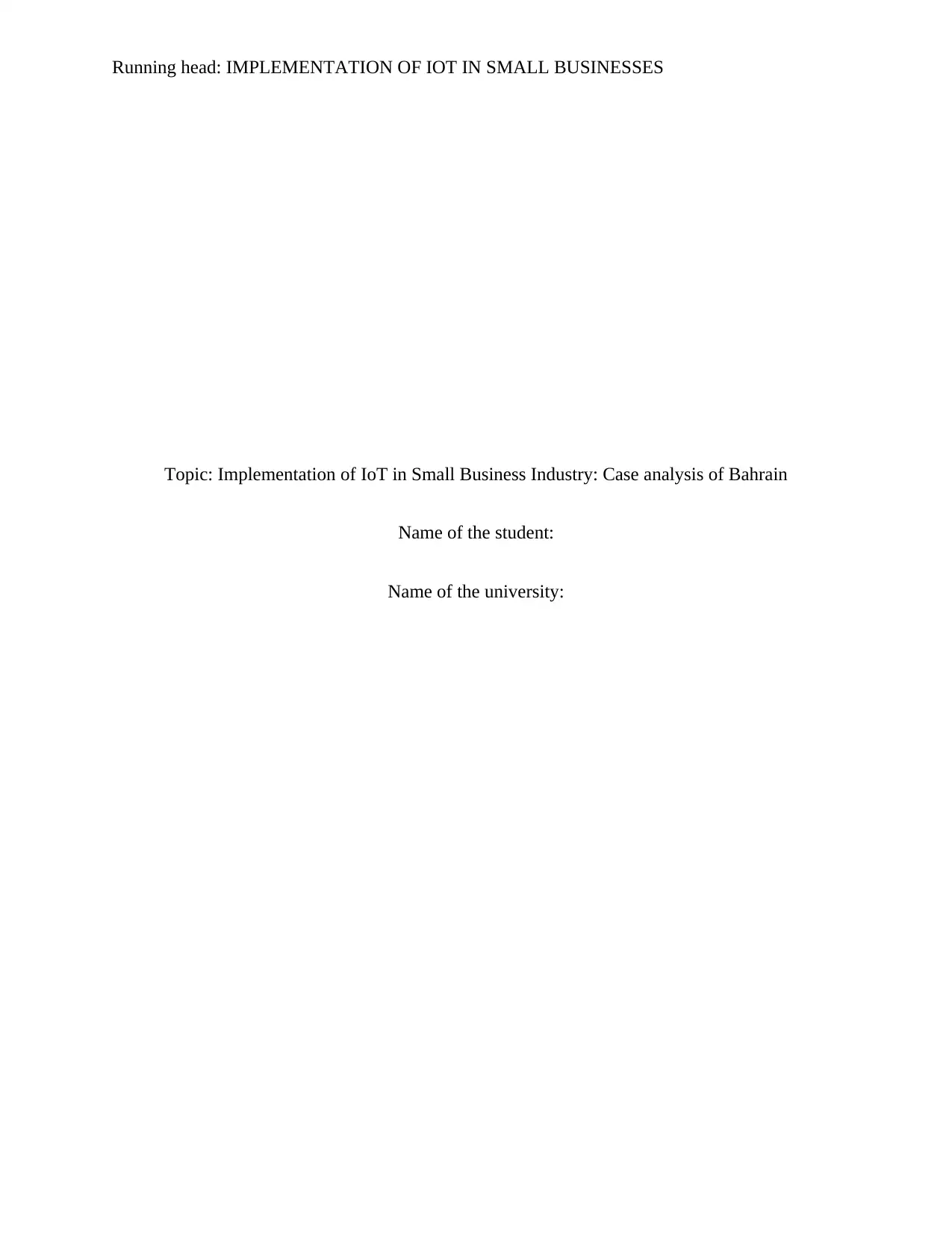
Running head: IMPLEMENTATION OF IOT IN SMALL BUSINESSES
Topic: Implementation of IoT in Small Business Industry: Case analysis of Bahrain
Name of the student:
Name of the university:
Topic: Implementation of IoT in Small Business Industry: Case analysis of Bahrain
Name of the student:
Name of the university:
Secure Best Marks with AI Grader
Need help grading? Try our AI Grader for instant feedback on your assignments.

1IMPLEMENTATION OF IOT IN SMALL BUSINESSES
Acknowledgement
Conducting the overall research has been one of the best experiences that I have got in my life.
The research contributed much to enhance my knowledge base along with analytical skills that
has been paramount. It gave me enough opportunity to face challenges in the process and also
ways to overcome them. This would not have been possible without the valuable guidance that
has been offered by my professor, peers and all those who have contributed to enrich my
experience. I would like to take this opportunity to thank my supervisor
_________________________ for constantly guiding me through the entire research process. I
would also like to thank my friends who had provided me with all kinds of help and assistance
while encouraging collecting primary data and valuable resources. Lastly I would like to thank
my family who supported me throughout my education.
I would not have done this without your support.
Heartfelt thanks and warmest wishes,
Yours sincerely,
1
Acknowledgement
Conducting the overall research has been one of the best experiences that I have got in my life.
The research contributed much to enhance my knowledge base along with analytical skills that
has been paramount. It gave me enough opportunity to face challenges in the process and also
ways to overcome them. This would not have been possible without the valuable guidance that
has been offered by my professor, peers and all those who have contributed to enrich my
experience. I would like to take this opportunity to thank my supervisor
_________________________ for constantly guiding me through the entire research process. I
would also like to thank my friends who had provided me with all kinds of help and assistance
while encouraging collecting primary data and valuable resources. Lastly I would like to thank
my family who supported me throughout my education.
I would not have done this without your support.
Heartfelt thanks and warmest wishes,
Yours sincerely,
1
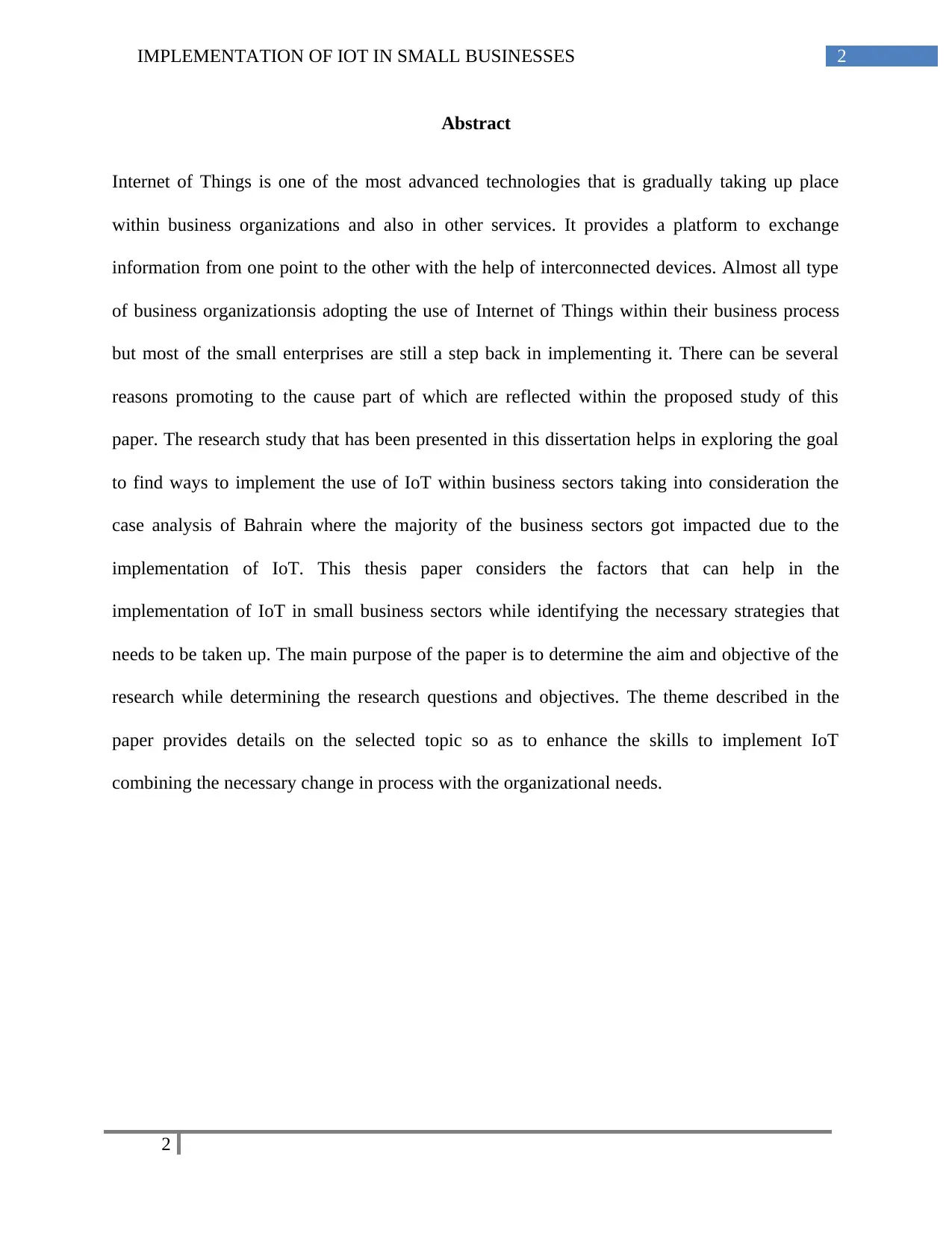
2IMPLEMENTATION OF IOT IN SMALL BUSINESSES
Abstract
Internet of Things is one of the most advanced technologies that is gradually taking up place
within business organizations and also in other services. It provides a platform to exchange
information from one point to the other with the help of interconnected devices. Almost all type
of business organizationsis adopting the use of Internet of Things within their business process
but most of the small enterprises are still a step back in implementing it. There can be several
reasons promoting to the cause part of which are reflected within the proposed study of this
paper. The research study that has been presented in this dissertation helps in exploring the goal
to find ways to implement the use of IoT within business sectors taking into consideration the
case analysis of Bahrain where the majority of the business sectors got impacted due to the
implementation of IoT. This thesis paper considers the factors that can help in the
implementation of IoT in small business sectors while identifying the necessary strategies that
needs to be taken up. The main purpose of the paper is to determine the aim and objective of the
research while determining the research questions and objectives. The theme described in the
paper provides details on the selected topic so as to enhance the skills to implement IoT
combining the necessary change in process with the organizational needs.
2
Abstract
Internet of Things is one of the most advanced technologies that is gradually taking up place
within business organizations and also in other services. It provides a platform to exchange
information from one point to the other with the help of interconnected devices. Almost all type
of business organizationsis adopting the use of Internet of Things within their business process
but most of the small enterprises are still a step back in implementing it. There can be several
reasons promoting to the cause part of which are reflected within the proposed study of this
paper. The research study that has been presented in this dissertation helps in exploring the goal
to find ways to implement the use of IoT within business sectors taking into consideration the
case analysis of Bahrain where the majority of the business sectors got impacted due to the
implementation of IoT. This thesis paper considers the factors that can help in the
implementation of IoT in small business sectors while identifying the necessary strategies that
needs to be taken up. The main purpose of the paper is to determine the aim and objective of the
research while determining the research questions and objectives. The theme described in the
paper provides details on the selected topic so as to enhance the skills to implement IoT
combining the necessary change in process with the organizational needs.
2
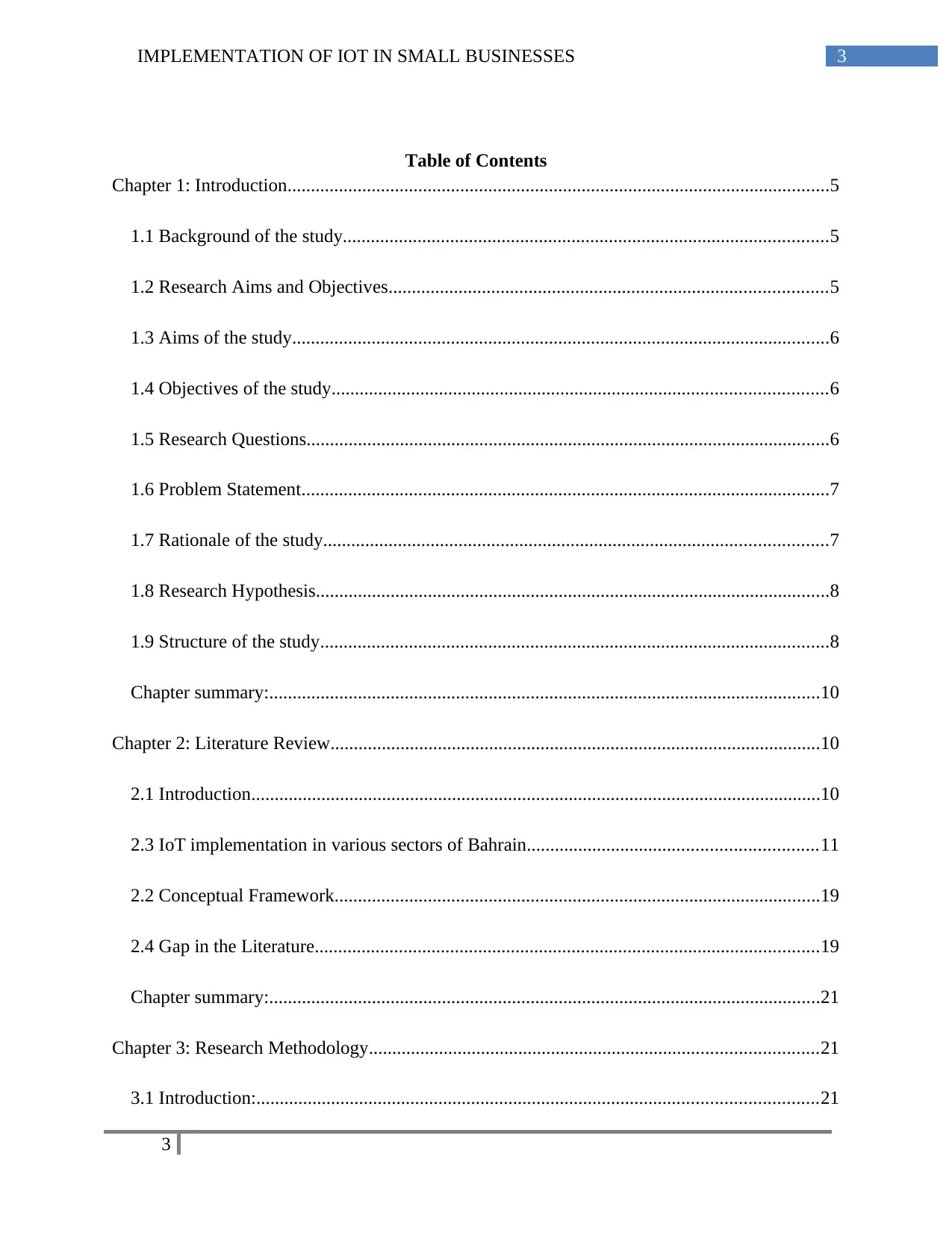
3IMPLEMENTATION OF IOT IN SMALL BUSINESSES
Table of Contents
Chapter 1: Introduction....................................................................................................................5
1.1 Background of the study........................................................................................................5
1.2 Research Aims and Objectives..............................................................................................5
1.3 Aims of the study...................................................................................................................6
1.4 Objectives of the study..........................................................................................................6
1.5 Research Questions................................................................................................................6
1.6 Problem Statement.................................................................................................................7
1.7 Rationale of the study............................................................................................................7
1.8 Research Hypothesis..............................................................................................................8
1.9 Structure of the study.............................................................................................................8
Chapter summary:......................................................................................................................10
Chapter 2: Literature Review.........................................................................................................10
2.1 Introduction..........................................................................................................................10
2.3 IoT implementation in various sectors of Bahrain..............................................................11
2.2 Conceptual Framework........................................................................................................19
2.4 Gap in the Literature............................................................................................................19
Chapter summary:......................................................................................................................21
Chapter 3: Research Methodology................................................................................................21
3.1 Introduction:........................................................................................................................21
3
Table of Contents
Chapter 1: Introduction....................................................................................................................5
1.1 Background of the study........................................................................................................5
1.2 Research Aims and Objectives..............................................................................................5
1.3 Aims of the study...................................................................................................................6
1.4 Objectives of the study..........................................................................................................6
1.5 Research Questions................................................................................................................6
1.6 Problem Statement.................................................................................................................7
1.7 Rationale of the study............................................................................................................7
1.8 Research Hypothesis..............................................................................................................8
1.9 Structure of the study.............................................................................................................8
Chapter summary:......................................................................................................................10
Chapter 2: Literature Review.........................................................................................................10
2.1 Introduction..........................................................................................................................10
2.3 IoT implementation in various sectors of Bahrain..............................................................11
2.2 Conceptual Framework........................................................................................................19
2.4 Gap in the Literature............................................................................................................19
Chapter summary:......................................................................................................................21
Chapter 3: Research Methodology................................................................................................21
3.1 Introduction:........................................................................................................................21
3
Secure Best Marks with AI Grader
Need help grading? Try our AI Grader for instant feedback on your assignments.
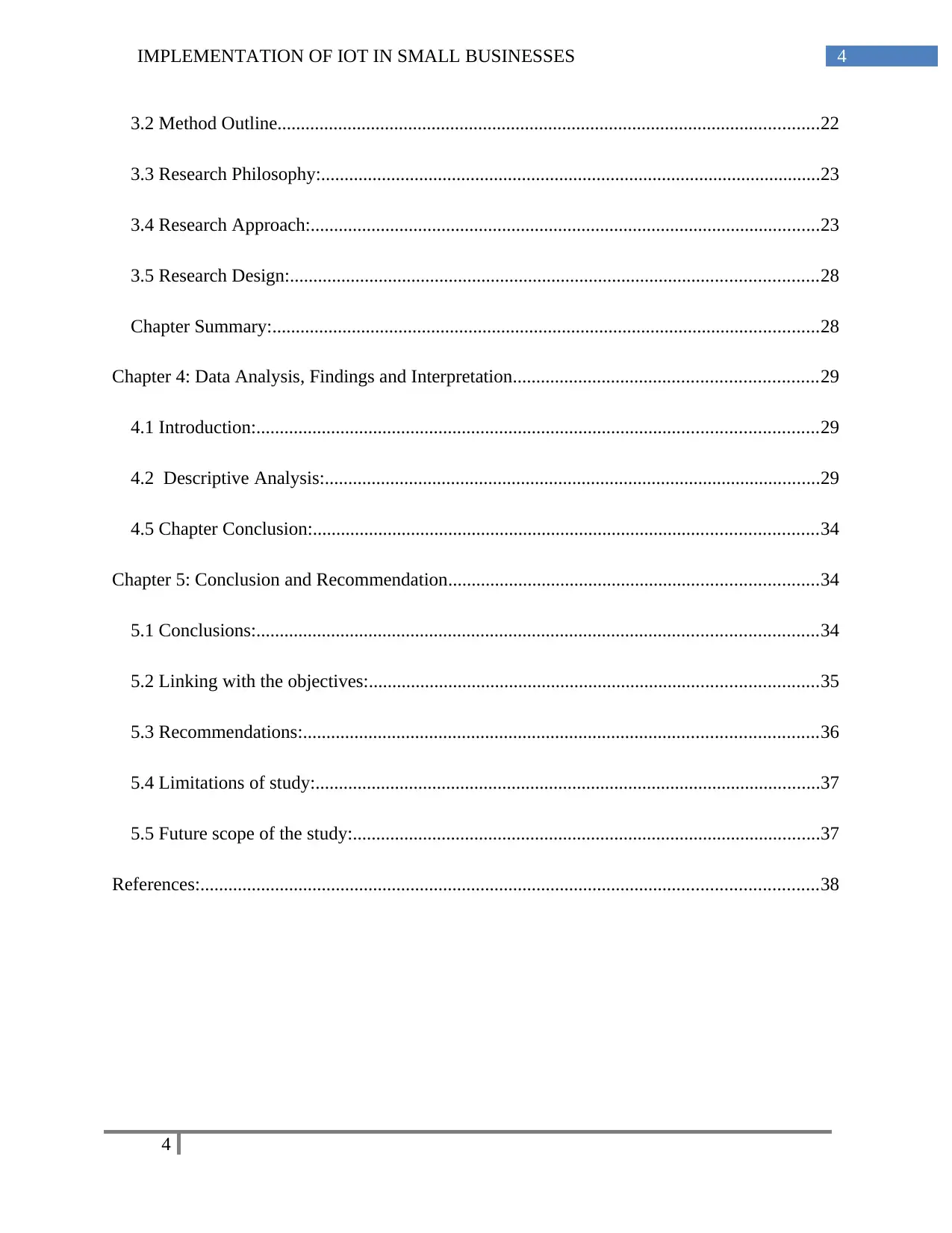
4IMPLEMENTATION OF IOT IN SMALL BUSINESSES
3.2 Method Outline....................................................................................................................22
3.3 Research Philosophy:...........................................................................................................23
3.4 Research Approach:.............................................................................................................23
3.5 Research Design:.................................................................................................................28
Chapter Summary:.....................................................................................................................28
Chapter 4: Data Analysis, Findings and Interpretation.................................................................29
4.1 Introduction:........................................................................................................................29
4.2 Descriptive Analysis:..........................................................................................................29
4.5 Chapter Conclusion:............................................................................................................34
Chapter 5: Conclusion and Recommendation...............................................................................34
5.1 Conclusions:........................................................................................................................34
5.2 Linking with the objectives:................................................................................................35
5.3 Recommendations:..............................................................................................................36
5.4 Limitations of study:............................................................................................................37
5.5 Future scope of the study:....................................................................................................37
References:....................................................................................................................................38
4
3.2 Method Outline....................................................................................................................22
3.3 Research Philosophy:...........................................................................................................23
3.4 Research Approach:.............................................................................................................23
3.5 Research Design:.................................................................................................................28
Chapter Summary:.....................................................................................................................28
Chapter 4: Data Analysis, Findings and Interpretation.................................................................29
4.1 Introduction:........................................................................................................................29
4.2 Descriptive Analysis:..........................................................................................................29
4.5 Chapter Conclusion:............................................................................................................34
Chapter 5: Conclusion and Recommendation...............................................................................34
5.1 Conclusions:........................................................................................................................34
5.2 Linking with the objectives:................................................................................................35
5.3 Recommendations:..............................................................................................................36
5.4 Limitations of study:............................................................................................................37
5.5 Future scope of the study:....................................................................................................37
References:....................................................................................................................................38
4
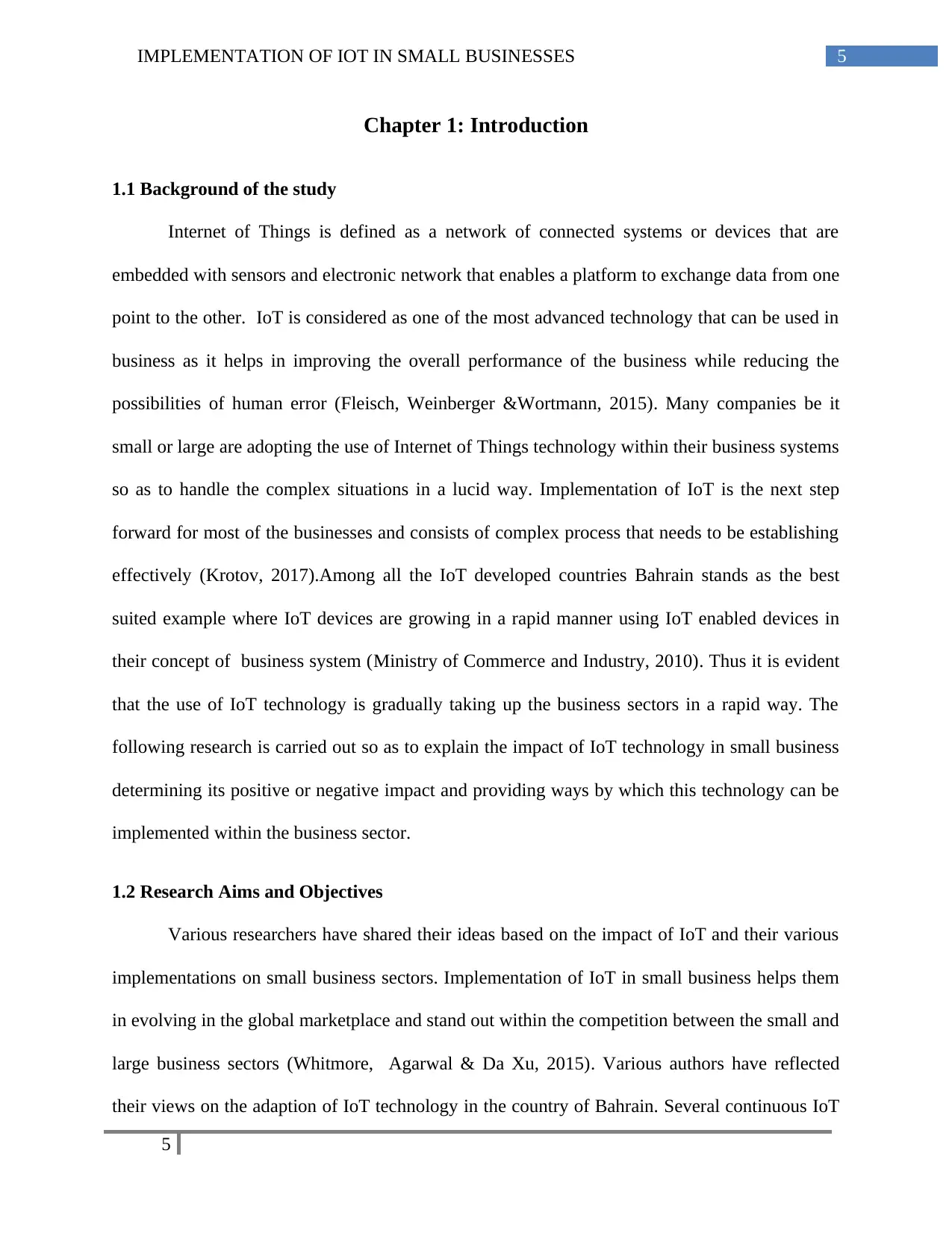
5IMPLEMENTATION OF IOT IN SMALL BUSINESSES
Chapter 1: Introduction
1.1 Background of the study
Internet of Things is defined as a network of connected systems or devices that are
embedded with sensors and electronic network that enables a platform to exchange data from one
point to the other. IoT is considered as one of the most advanced technology that can be used in
business as it helps in improving the overall performance of the business while reducing the
possibilities of human error (Fleisch, Weinberger &Wortmann, 2015). Many companies be it
small or large are adopting the use of Internet of Things technology within their business systems
so as to handle the complex situations in a lucid way. Implementation of IoT is the next step
forward for most of the businesses and consists of complex process that needs to be establishing
effectively (Krotov, 2017).Among all the IoT developed countries Bahrain stands as the best
suited example where IoT devices are growing in a rapid manner using IoT enabled devices in
their concept of business system (Ministry of Commerce and Industry, 2010). Thus it is evident
that the use of IoT technology is gradually taking up the business sectors in a rapid way. The
following research is carried out so as to explain the impact of IoT technology in small business
determining its positive or negative impact and providing ways by which this technology can be
implemented within the business sector.
1.2 Research Aims and Objectives
Various researchers have shared their ideas based on the impact of IoT and their various
implementations on small business sectors. Implementation of IoT in small business helps them
in evolving in the global marketplace and stand out within the competition between the small and
large business sectors (Whitmore, Agarwal & Da Xu, 2015). Various authors have reflected
their views on the adaption of IoT technology in the country of Bahrain. Several continuous IoT
5
Chapter 1: Introduction
1.1 Background of the study
Internet of Things is defined as a network of connected systems or devices that are
embedded with sensors and electronic network that enables a platform to exchange data from one
point to the other. IoT is considered as one of the most advanced technology that can be used in
business as it helps in improving the overall performance of the business while reducing the
possibilities of human error (Fleisch, Weinberger &Wortmann, 2015). Many companies be it
small or large are adopting the use of Internet of Things technology within their business systems
so as to handle the complex situations in a lucid way. Implementation of IoT is the next step
forward for most of the businesses and consists of complex process that needs to be establishing
effectively (Krotov, 2017).Among all the IoT developed countries Bahrain stands as the best
suited example where IoT devices are growing in a rapid manner using IoT enabled devices in
their concept of business system (Ministry of Commerce and Industry, 2010). Thus it is evident
that the use of IoT technology is gradually taking up the business sectors in a rapid way. The
following research is carried out so as to explain the impact of IoT technology in small business
determining its positive or negative impact and providing ways by which this technology can be
implemented within the business sector.
1.2 Research Aims and Objectives
Various researchers have shared their ideas based on the impact of IoT and their various
implementations on small business sectors. Implementation of IoT in small business helps them
in evolving in the global marketplace and stand out within the competition between the small and
large business sectors (Whitmore, Agarwal & Da Xu, 2015). Various authors have reflected
their views on the adaption of IoT technology in the country of Bahrain. Several continuous IoT
5
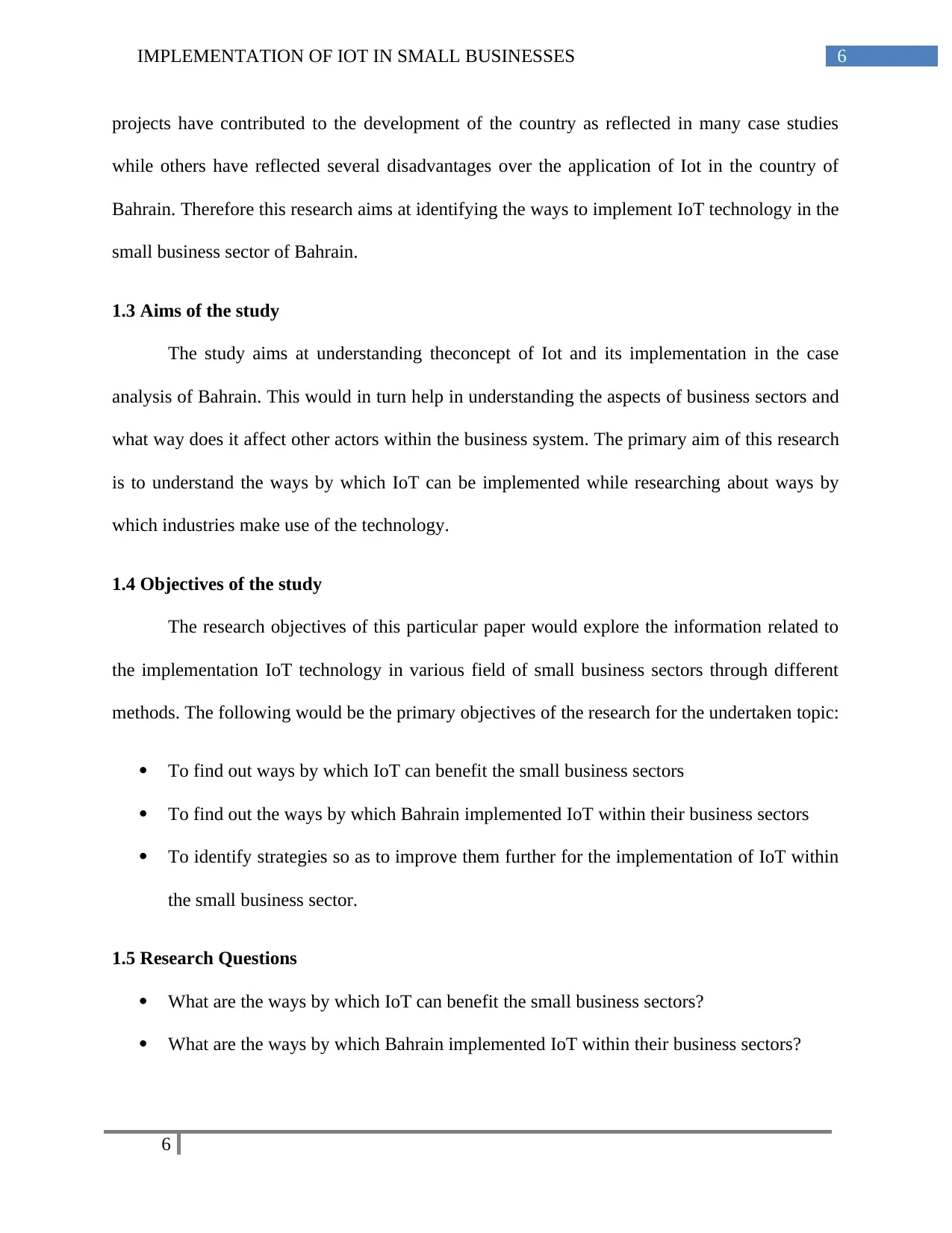
6IMPLEMENTATION OF IOT IN SMALL BUSINESSES
projects have contributed to the development of the country as reflected in many case studies
while others have reflected several disadvantages over the application of Iot in the country of
Bahrain. Therefore this research aims at identifying the ways to implement IoT technology in the
small business sector of Bahrain.
1.3 Aims of the study
The study aims at understanding theconcept of Iot and its implementation in the case
analysis of Bahrain. This would in turn help in understanding the aspects of business sectors and
what way does it affect other actors within the business system. The primary aim of this research
is to understand the ways by which IoT can be implemented while researching about ways by
which industries make use of the technology.
1.4 Objectives of the study
The research objectives of this particular paper would explore the information related to
the implementation IoT technology in various field of small business sectors through different
methods. The following would be the primary objectives of the research for the undertaken topic:
To find out ways by which IoT can benefit the small business sectors
To find out the ways by which Bahrain implemented IoT within their business sectors
To identify strategies so as to improve them further for the implementation of IoT within
the small business sector.
1.5 Research Questions
What are the ways by which IoT can benefit the small business sectors?
What are the ways by which Bahrain implemented IoT within their business sectors?
6
projects have contributed to the development of the country as reflected in many case studies
while others have reflected several disadvantages over the application of Iot in the country of
Bahrain. Therefore this research aims at identifying the ways to implement IoT technology in the
small business sector of Bahrain.
1.3 Aims of the study
The study aims at understanding theconcept of Iot and its implementation in the case
analysis of Bahrain. This would in turn help in understanding the aspects of business sectors and
what way does it affect other actors within the business system. The primary aim of this research
is to understand the ways by which IoT can be implemented while researching about ways by
which industries make use of the technology.
1.4 Objectives of the study
The research objectives of this particular paper would explore the information related to
the implementation IoT technology in various field of small business sectors through different
methods. The following would be the primary objectives of the research for the undertaken topic:
To find out ways by which IoT can benefit the small business sectors
To find out the ways by which Bahrain implemented IoT within their business sectors
To identify strategies so as to improve them further for the implementation of IoT within
the small business sector.
1.5 Research Questions
What are the ways by which IoT can benefit the small business sectors?
What are the ways by which Bahrain implemented IoT within their business sectors?
6
Paraphrase This Document
Need a fresh take? Get an instant paraphrase of this document with our AI Paraphraser
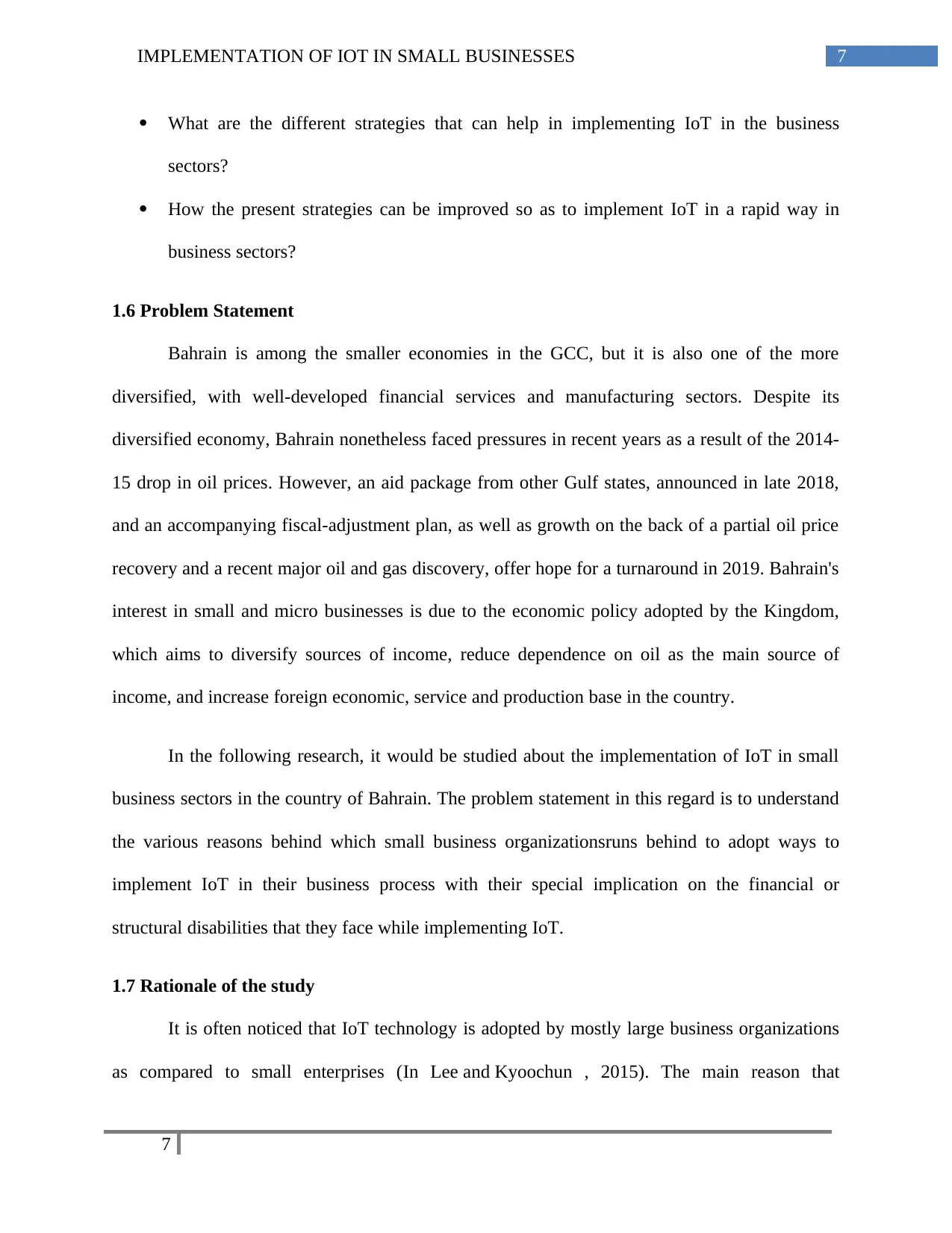
7IMPLEMENTATION OF IOT IN SMALL BUSINESSES
What are the different strategies that can help in implementing IoT in the business
sectors?
How the present strategies can be improved so as to implement IoT in a rapid way in
business sectors?
1.6 Problem Statement
Bahrain is among the smaller economies in the GCC, but it is also one of the more
diversified, with well-developed financial services and manufacturing sectors. Despite its
diversified economy, Bahrain nonetheless faced pressures in recent years as a result of the 2014-
15 drop in oil prices. However, an aid package from other Gulf states, announced in late 2018,
and an accompanying fiscal-adjustment plan, as well as growth on the back of a partial oil price
recovery and a recent major oil and gas discovery, offer hope for a turnaround in 2019. Bahrain's
interest in small and micro businesses is due to the economic policy adopted by the Kingdom,
which aims to diversify sources of income, reduce dependence on oil as the main source of
income, and increase foreign economic, service and production base in the country.
In the following research, it would be studied about the implementation of IoT in small
business sectors in the country of Bahrain. The problem statement in this regard is to understand
the various reasons behind which small business organizationsruns behind to adopt ways to
implement IoT in their business process with their special implication on the financial or
structural disabilities that they face while implementing IoT.
1.7 Rationale of the study
It is often noticed that IoT technology is adopted by mostly large business organizations
as compared to small enterprises (In Lee and Kyoochun , 2015). The main reason that
7
What are the different strategies that can help in implementing IoT in the business
sectors?
How the present strategies can be improved so as to implement IoT in a rapid way in
business sectors?
1.6 Problem Statement
Bahrain is among the smaller economies in the GCC, but it is also one of the more
diversified, with well-developed financial services and manufacturing sectors. Despite its
diversified economy, Bahrain nonetheless faced pressures in recent years as a result of the 2014-
15 drop in oil prices. However, an aid package from other Gulf states, announced in late 2018,
and an accompanying fiscal-adjustment plan, as well as growth on the back of a partial oil price
recovery and a recent major oil and gas discovery, offer hope for a turnaround in 2019. Bahrain's
interest in small and micro businesses is due to the economic policy adopted by the Kingdom,
which aims to diversify sources of income, reduce dependence on oil as the main source of
income, and increase foreign economic, service and production base in the country.
In the following research, it would be studied about the implementation of IoT in small
business sectors in the country of Bahrain. The problem statement in this regard is to understand
the various reasons behind which small business organizationsruns behind to adopt ways to
implement IoT in their business process with their special implication on the financial or
structural disabilities that they face while implementing IoT.
1.7 Rationale of the study
It is often noticed that IoT technology is adopted by mostly large business organizations
as compared to small enterprises (In Lee and Kyoochun , 2015). The main reason that
7
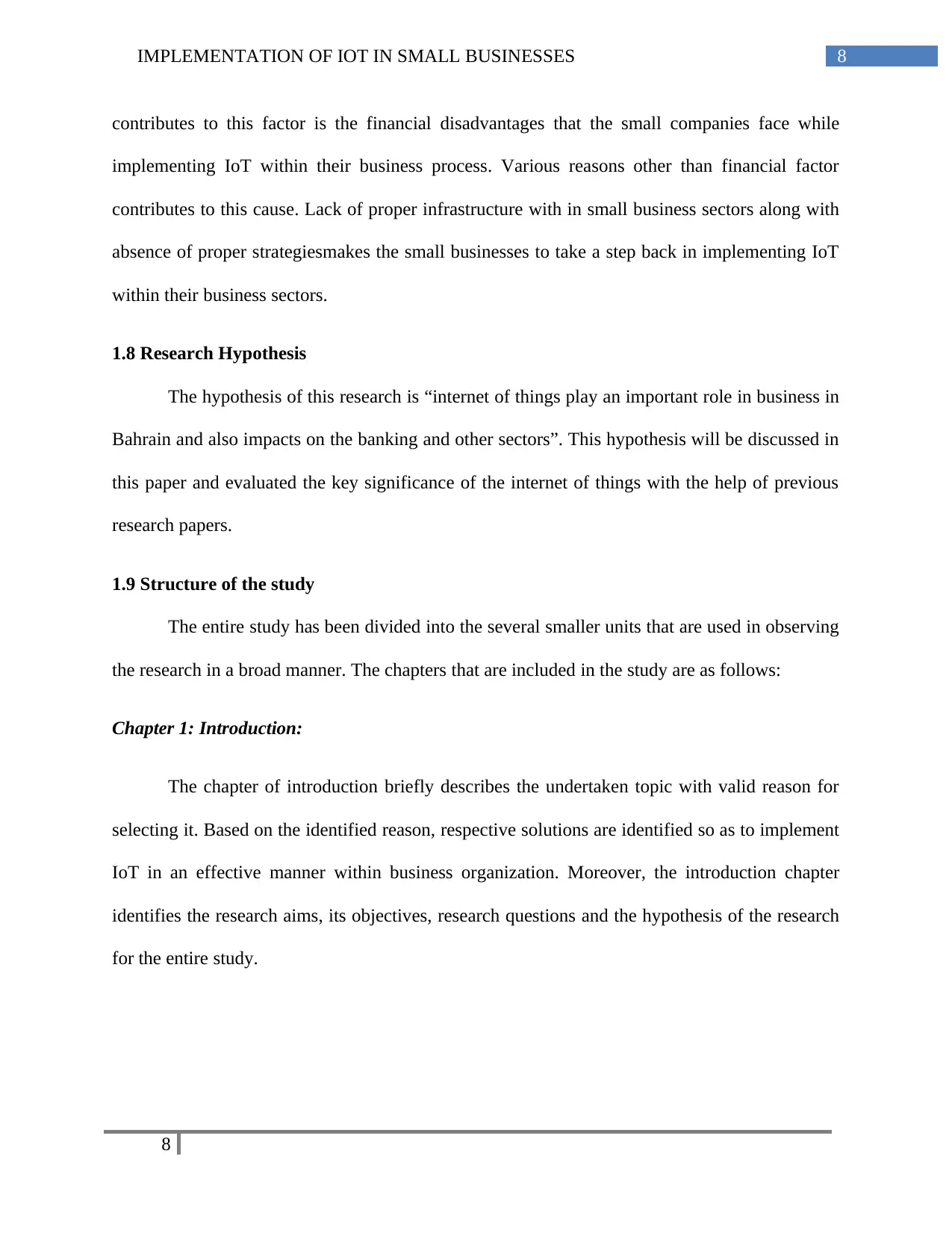
8IMPLEMENTATION OF IOT IN SMALL BUSINESSES
contributes to this factor is the financial disadvantages that the small companies face while
implementing IoT within their business process. Various reasons other than financial factor
contributes to this cause. Lack of proper infrastructure with in small business sectors along with
absence of proper strategiesmakes the small businesses to take a step back in implementing IoT
within their business sectors.
1.8 Research Hypothesis
The hypothesis of this research is “internet of things play an important role in business in
Bahrain and also impacts on the banking and other sectors”. This hypothesis will be discussed in
this paper and evaluated the key significance of the internet of things with the help of previous
research papers.
1.9 Structure of the study
The entire study has been divided into the several smaller units that are used in observing
the research in a broad manner. The chapters that are included in the study are as follows:
Chapter 1: Introduction:
The chapter of introduction briefly describes the undertaken topic with valid reason for
selecting it. Based on the identified reason, respective solutions are identified so as to implement
IoT in an effective manner within business organization. Moreover, the introduction chapter
identifies the research aims, its objectives, research questions and the hypothesis of the research
for the entire study.
8
contributes to this factor is the financial disadvantages that the small companies face while
implementing IoT within their business process. Various reasons other than financial factor
contributes to this cause. Lack of proper infrastructure with in small business sectors along with
absence of proper strategiesmakes the small businesses to take a step back in implementing IoT
within their business sectors.
1.8 Research Hypothesis
The hypothesis of this research is “internet of things play an important role in business in
Bahrain and also impacts on the banking and other sectors”. This hypothesis will be discussed in
this paper and evaluated the key significance of the internet of things with the help of previous
research papers.
1.9 Structure of the study
The entire study has been divided into the several smaller units that are used in observing
the research in a broad manner. The chapters that are included in the study are as follows:
Chapter 1: Introduction:
The chapter of introduction briefly describes the undertaken topic with valid reason for
selecting it. Based on the identified reason, respective solutions are identified so as to implement
IoT in an effective manner within business organization. Moreover, the introduction chapter
identifies the research aims, its objectives, research questions and the hypothesis of the research
for the entire study.
8
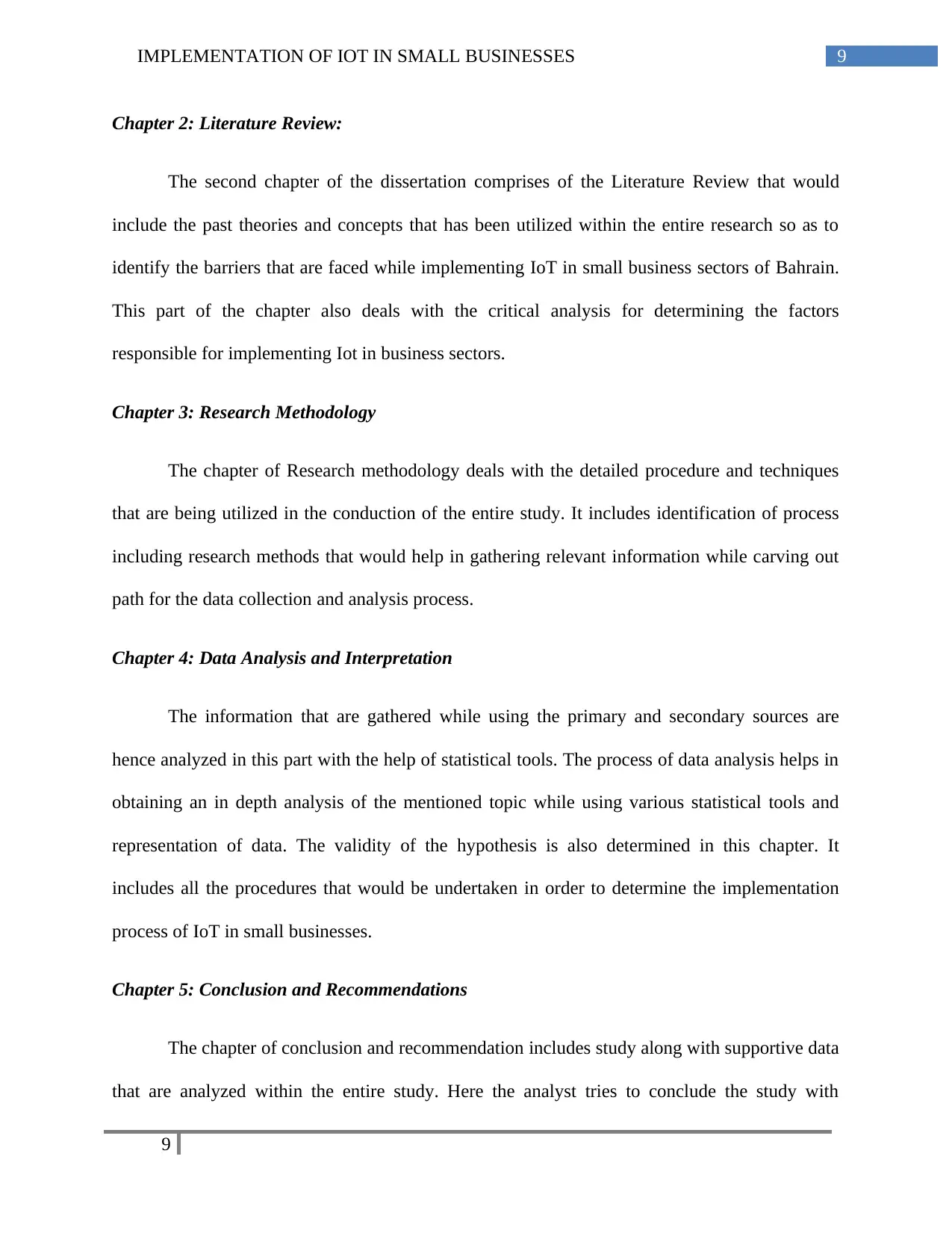
9IMPLEMENTATION OF IOT IN SMALL BUSINESSES
Chapter 2: Literature Review:
The second chapter of the dissertation comprises of the Literature Review that would
include the past theories and concepts that has been utilized within the entire research so as to
identify the barriers that are faced while implementing IoT in small business sectors of Bahrain.
This part of the chapter also deals with the critical analysis for determining the factors
responsible for implementing Iot in business sectors.
Chapter 3: Research Methodology
The chapter of Research methodology deals with the detailed procedure and techniques
that are being utilized in the conduction of the entire study. It includes identification of process
including research methods that would help in gathering relevant information while carving out
path for the data collection and analysis process.
Chapter 4: Data Analysis and Interpretation
The information that are gathered while using the primary and secondary sources are
hence analyzed in this part with the help of statistical tools. The process of data analysis helps in
obtaining an in depth analysis of the mentioned topic while using various statistical tools and
representation of data. The validity of the hypothesis is also determined in this chapter. It
includes all the procedures that would be undertaken in order to determine the implementation
process of IoT in small businesses.
Chapter 5: Conclusion and Recommendations
The chapter of conclusion and recommendation includes study along with supportive data
that are analyzed within the entire study. Here the analyst tries to conclude the study with
9
Chapter 2: Literature Review:
The second chapter of the dissertation comprises of the Literature Review that would
include the past theories and concepts that has been utilized within the entire research so as to
identify the barriers that are faced while implementing IoT in small business sectors of Bahrain.
This part of the chapter also deals with the critical analysis for determining the factors
responsible for implementing Iot in business sectors.
Chapter 3: Research Methodology
The chapter of Research methodology deals with the detailed procedure and techniques
that are being utilized in the conduction of the entire study. It includes identification of process
including research methods that would help in gathering relevant information while carving out
path for the data collection and analysis process.
Chapter 4: Data Analysis and Interpretation
The information that are gathered while using the primary and secondary sources are
hence analyzed in this part with the help of statistical tools. The process of data analysis helps in
obtaining an in depth analysis of the mentioned topic while using various statistical tools and
representation of data. The validity of the hypothesis is also determined in this chapter. It
includes all the procedures that would be undertaken in order to determine the implementation
process of IoT in small businesses.
Chapter 5: Conclusion and Recommendations
The chapter of conclusion and recommendation includes study along with supportive data
that are analyzed within the entire study. Here the analyst tries to conclude the study with
9
Secure Best Marks with AI Grader
Need help grading? Try our AI Grader for instant feedback on your assignments.
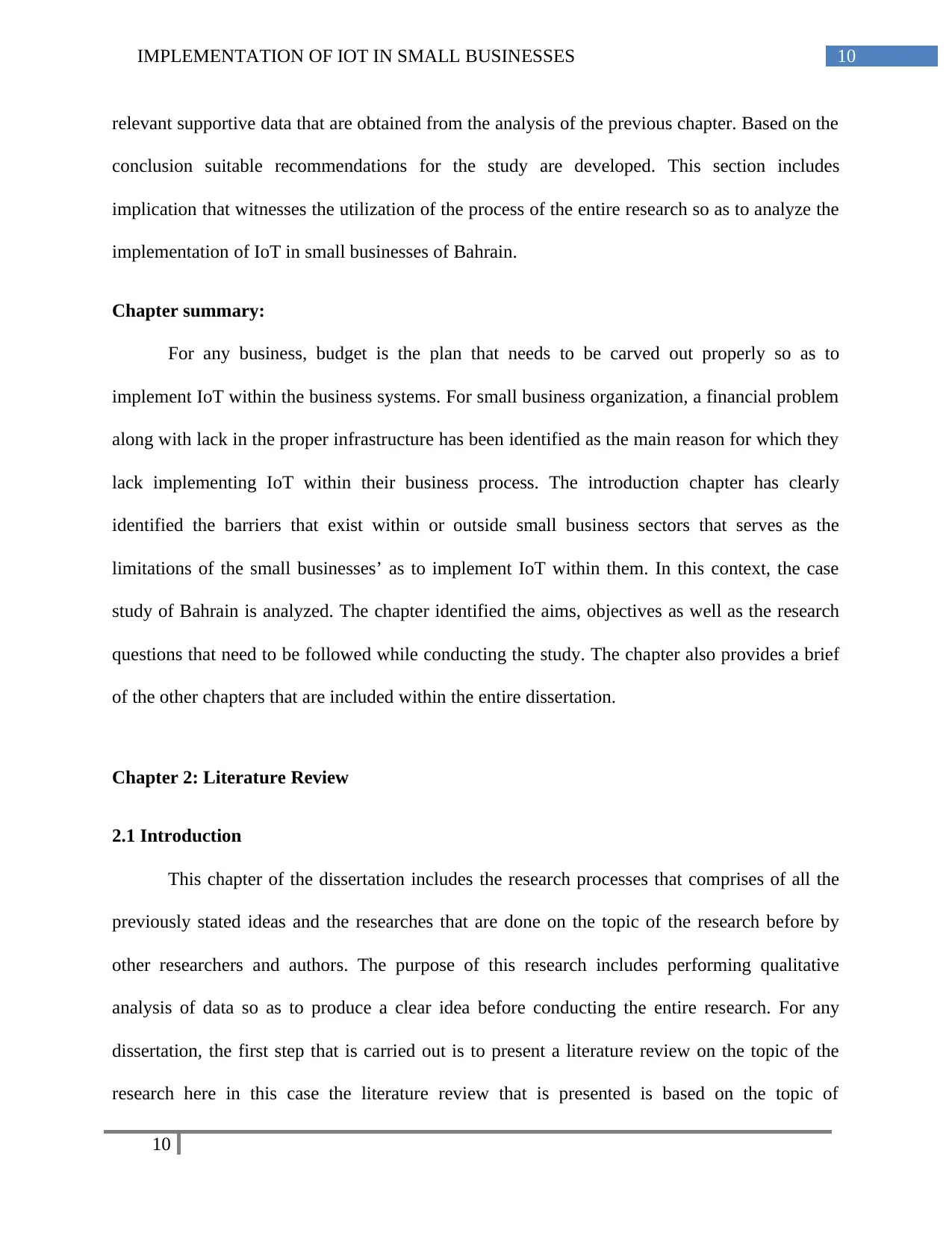
10IMPLEMENTATION OF IOT IN SMALL BUSINESSES
relevant supportive data that are obtained from the analysis of the previous chapter. Based on the
conclusion suitable recommendations for the study are developed. This section includes
implication that witnesses the utilization of the process of the entire research so as to analyze the
implementation of IoT in small businesses of Bahrain.
Chapter summary:
For any business, budget is the plan that needs to be carved out properly so as to
implement IoT within the business systems. For small business organization, a financial problem
along with lack in the proper infrastructure has been identified as the main reason for which they
lack implementing IoT within their business process. The introduction chapter has clearly
identified the barriers that exist within or outside small business sectors that serves as the
limitations of the small businesses’ as to implement IoT within them. In this context, the case
study of Bahrain is analyzed. The chapter identified the aims, objectives as well as the research
questions that need to be followed while conducting the study. The chapter also provides a brief
of the other chapters that are included within the entire dissertation.
Chapter 2: Literature Review
2.1 Introduction
This chapter of the dissertation includes the research processes that comprises of all the
previously stated ideas and the researches that are done on the topic of the research before by
other researchers and authors. The purpose of this research includes performing qualitative
analysis of data so as to produce a clear idea before conducting the entire research. For any
dissertation, the first step that is carried out is to present a literature review on the topic of the
research here in this case the literature review that is presented is based on the topic of
10
relevant supportive data that are obtained from the analysis of the previous chapter. Based on the
conclusion suitable recommendations for the study are developed. This section includes
implication that witnesses the utilization of the process of the entire research so as to analyze the
implementation of IoT in small businesses of Bahrain.
Chapter summary:
For any business, budget is the plan that needs to be carved out properly so as to
implement IoT within the business systems. For small business organization, a financial problem
along with lack in the proper infrastructure has been identified as the main reason for which they
lack implementing IoT within their business process. The introduction chapter has clearly
identified the barriers that exist within or outside small business sectors that serves as the
limitations of the small businesses’ as to implement IoT within them. In this context, the case
study of Bahrain is analyzed. The chapter identified the aims, objectives as well as the research
questions that need to be followed while conducting the study. The chapter also provides a brief
of the other chapters that are included within the entire dissertation.
Chapter 2: Literature Review
2.1 Introduction
This chapter of the dissertation includes the research processes that comprises of all the
previously stated ideas and the researches that are done on the topic of the research before by
other researchers and authors. The purpose of this research includes performing qualitative
analysis of data so as to produce a clear idea before conducting the entire research. For any
dissertation, the first step that is carried out is to present a literature review on the topic of the
research here in this case the literature review that is presented is based on the topic of
10
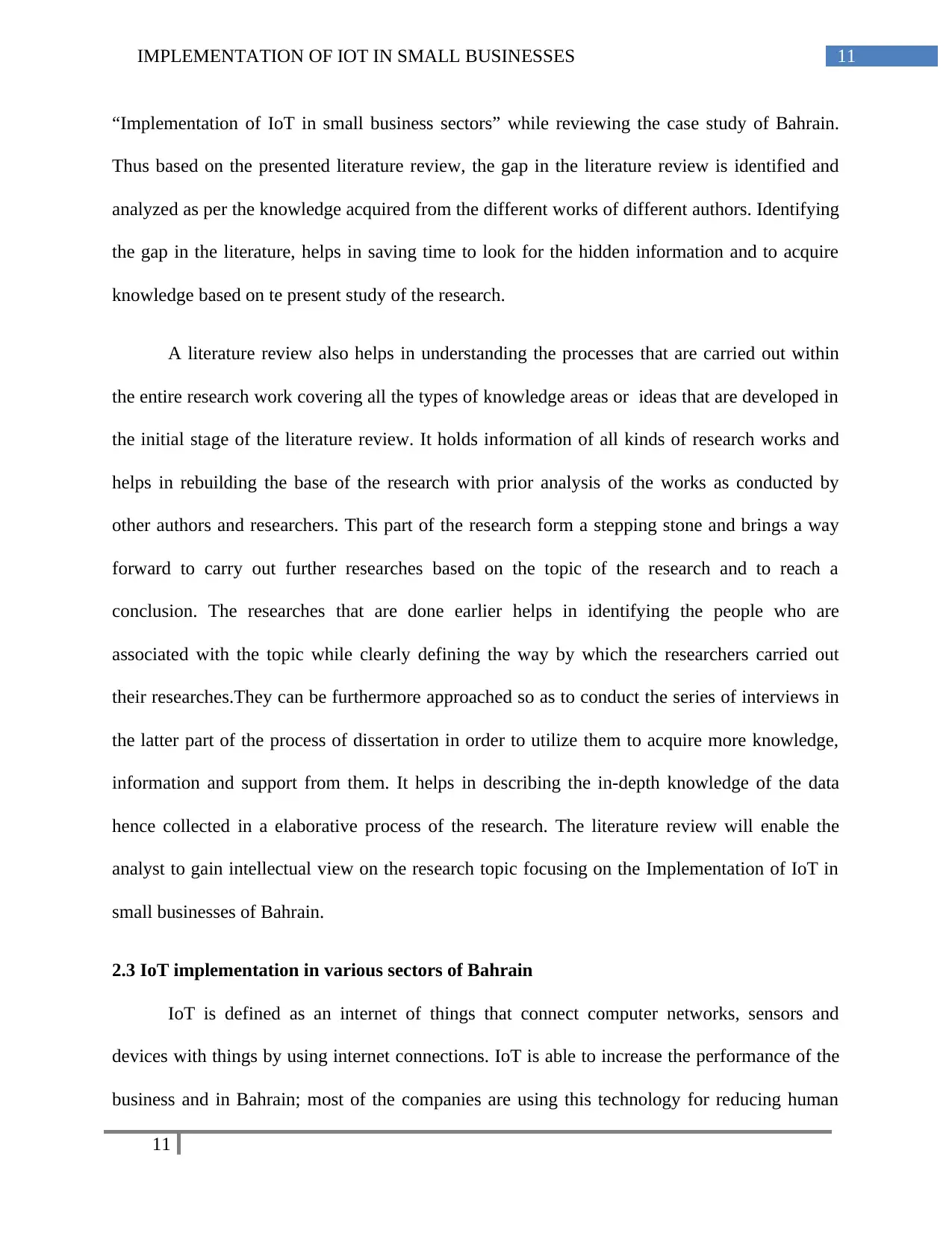
11IMPLEMENTATION OF IOT IN SMALL BUSINESSES
“Implementation of IoT in small business sectors” while reviewing the case study of Bahrain.
Thus based on the presented literature review, the gap in the literature review is identified and
analyzed as per the knowledge acquired from the different works of different authors. Identifying
the gap in the literature, helps in saving time to look for the hidden information and to acquire
knowledge based on te present study of the research.
A literature review also helps in understanding the processes that are carried out within
the entire research work covering all the types of knowledge areas or ideas that are developed in
the initial stage of the literature review. It holds information of all kinds of research works and
helps in rebuilding the base of the research with prior analysis of the works as conducted by
other authors and researchers. This part of the research form a stepping stone and brings a way
forward to carry out further researches based on the topic of the research and to reach a
conclusion. The researches that are done earlier helps in identifying the people who are
associated with the topic while clearly defining the way by which the researchers carried out
their researches.They can be furthermore approached so as to conduct the series of interviews in
the latter part of the process of dissertation in order to utilize them to acquire more knowledge,
information and support from them. It helps in describing the in-depth knowledge of the data
hence collected in a elaborative process of the research. The literature review will enable the
analyst to gain intellectual view on the research topic focusing on the Implementation of IoT in
small businesses of Bahrain.
2.3 IoT implementation in various sectors of Bahrain
IoT is defined as an internet of things that connect computer networks, sensors and
devices with things by using internet connections. IoT is able to increase the performance of the
business and in Bahrain; most of the companies are using this technology for reducing human
11
“Implementation of IoT in small business sectors” while reviewing the case study of Bahrain.
Thus based on the presented literature review, the gap in the literature review is identified and
analyzed as per the knowledge acquired from the different works of different authors. Identifying
the gap in the literature, helps in saving time to look for the hidden information and to acquire
knowledge based on te present study of the research.
A literature review also helps in understanding the processes that are carried out within
the entire research work covering all the types of knowledge areas or ideas that are developed in
the initial stage of the literature review. It holds information of all kinds of research works and
helps in rebuilding the base of the research with prior analysis of the works as conducted by
other authors and researchers. This part of the research form a stepping stone and brings a way
forward to carry out further researches based on the topic of the research and to reach a
conclusion. The researches that are done earlier helps in identifying the people who are
associated with the topic while clearly defining the way by which the researchers carried out
their researches.They can be furthermore approached so as to conduct the series of interviews in
the latter part of the process of dissertation in order to utilize them to acquire more knowledge,
information and support from them. It helps in describing the in-depth knowledge of the data
hence collected in a elaborative process of the research. The literature review will enable the
analyst to gain intellectual view on the research topic focusing on the Implementation of IoT in
small businesses of Bahrain.
2.3 IoT implementation in various sectors of Bahrain
IoT is defined as an internet of things that connect computer networks, sensors and
devices with things by using internet connections. IoT is able to increase the performance of the
business and in Bahrain; most of the companies are using this technology for reducing human
11
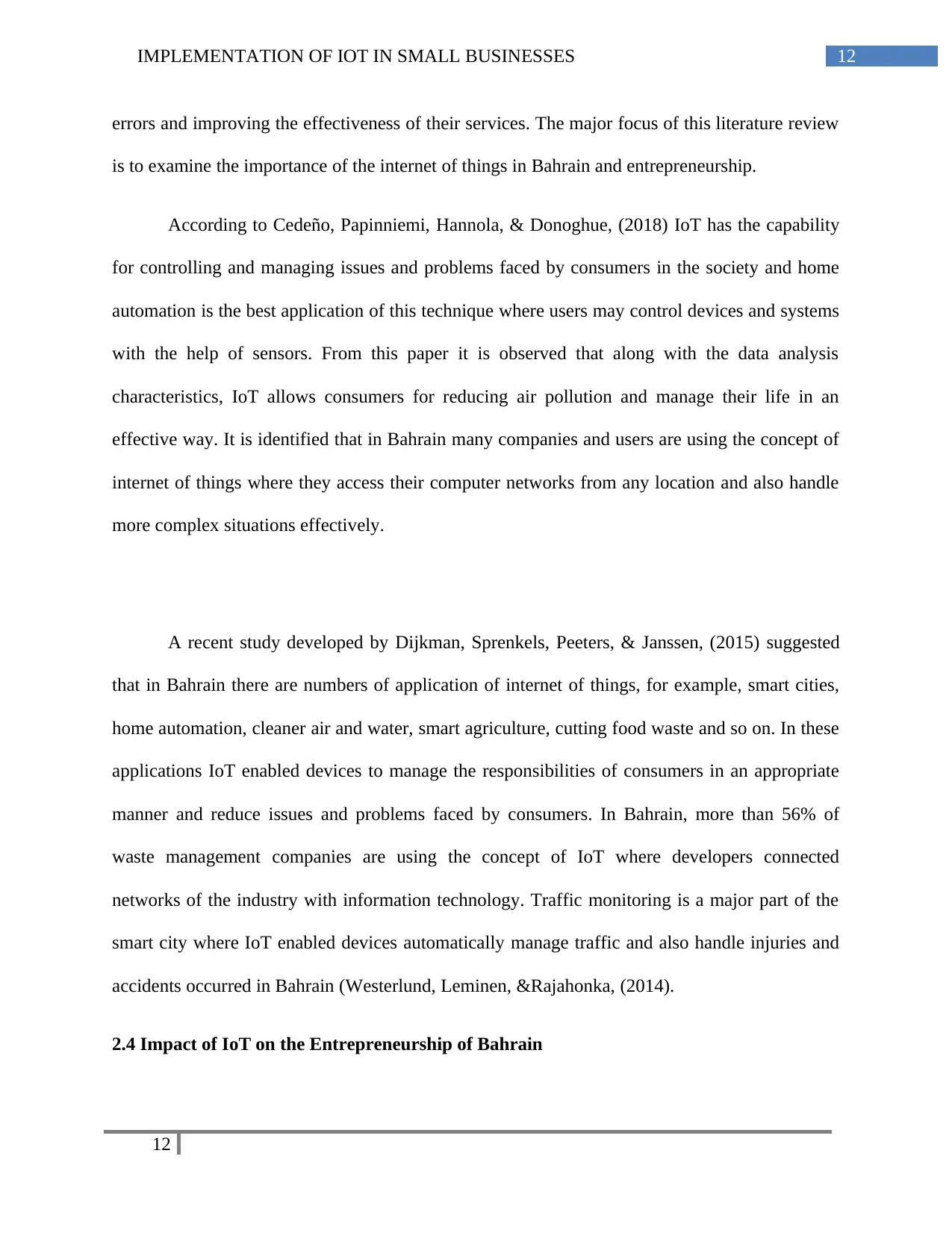
12IMPLEMENTATION OF IOT IN SMALL BUSINESSES
errors and improving the effectiveness of their services. The major focus of this literature review
is to examine the importance of the internet of things in Bahrain and entrepreneurship.
According to Cedeño, Papinniemi, Hannola, & Donoghue, (2018) IoT has the capability
for controlling and managing issues and problems faced by consumers in the society and home
automation is the best application of this technique where users may control devices and systems
with the help of sensors. From this paper it is observed that along with the data analysis
characteristics, IoT allows consumers for reducing air pollution and manage their life in an
effective way. It is identified that in Bahrain many companies and users are using the concept of
internet of things where they access their computer networks from any location and also handle
more complex situations effectively.
A recent study developed by Dijkman, Sprenkels, Peeters, & Janssen, (2015) suggested
that in Bahrain there are numbers of application of internet of things, for example, smart cities,
home automation, cleaner air and water, smart agriculture, cutting food waste and so on. In these
applications IoT enabled devices to manage the responsibilities of consumers in an appropriate
manner and reduce issues and problems faced by consumers. In Bahrain, more than 56% of
waste management companies are using the concept of IoT where developers connected
networks of the industry with information technology. Traffic monitoring is a major part of the
smart city where IoT enabled devices automatically manage traffic and also handle injuries and
accidents occurred in Bahrain (Westerlund, Leminen, &Rajahonka, (2014).
2.4 Impact of IoT on the Entrepreneurship of Bahrain
12
errors and improving the effectiveness of their services. The major focus of this literature review
is to examine the importance of the internet of things in Bahrain and entrepreneurship.
According to Cedeño, Papinniemi, Hannola, & Donoghue, (2018) IoT has the capability
for controlling and managing issues and problems faced by consumers in the society and home
automation is the best application of this technique where users may control devices and systems
with the help of sensors. From this paper it is observed that along with the data analysis
characteristics, IoT allows consumers for reducing air pollution and manage their life in an
effective way. It is identified that in Bahrain many companies and users are using the concept of
internet of things where they access their computer networks from any location and also handle
more complex situations effectively.
A recent study developed by Dijkman, Sprenkels, Peeters, & Janssen, (2015) suggested
that in Bahrain there are numbers of application of internet of things, for example, smart cities,
home automation, cleaner air and water, smart agriculture, cutting food waste and so on. In these
applications IoT enabled devices to manage the responsibilities of consumers in an appropriate
manner and reduce issues and problems faced by consumers. In Bahrain, more than 56% of
waste management companies are using the concept of IoT where developers connected
networks of the industry with information technology. Traffic monitoring is a major part of the
smart city where IoT enabled devices automatically manage traffic and also handle injuries and
accidents occurred in Bahrain (Westerlund, Leminen, &Rajahonka, (2014).
2.4 Impact of IoT on the Entrepreneurship of Bahrain
12
Paraphrase This Document
Need a fresh take? Get an instant paraphrase of this document with our AI Paraphraser
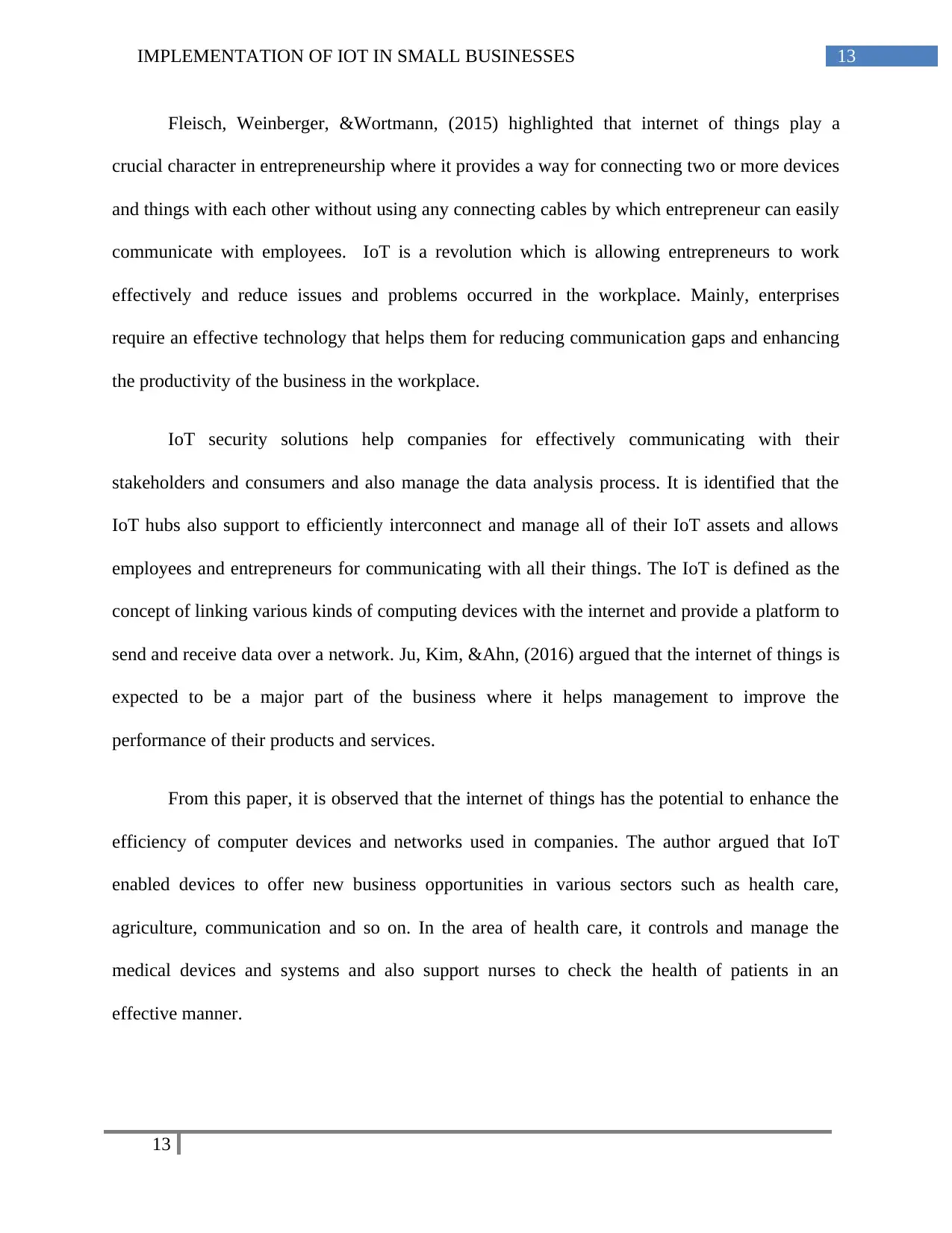
13IMPLEMENTATION OF IOT IN SMALL BUSINESSES
Fleisch, Weinberger, &Wortmann, (2015) highlighted that internet of things play a
crucial character in entrepreneurship where it provides a way for connecting two or more devices
and things with each other without using any connecting cables by which entrepreneur can easily
communicate with employees. IoT is a revolution which is allowing entrepreneurs to work
effectively and reduce issues and problems occurred in the workplace. Mainly, enterprises
require an effective technology that helps them for reducing communication gaps and enhancing
the productivity of the business in the workplace.
IoT security solutions help companies for effectively communicating with their
stakeholders and consumers and also manage the data analysis process. It is identified that the
IoT hubs also support to efficiently interconnect and manage all of their IoT assets and allows
employees and entrepreneurs for communicating with all their things. The IoT is defined as the
concept of linking various kinds of computing devices with the internet and provide a platform to
send and receive data over a network. Ju, Kim, &Ahn, (2016) argued that the internet of things is
expected to be a major part of the business where it helps management to improve the
performance of their products and services.
From this paper, it is observed that the internet of things has the potential to enhance the
efficiency of computer devices and networks used in companies. The author argued that IoT
enabled devices to offer new business opportunities in various sectors such as health care,
agriculture, communication and so on. In the area of health care, it controls and manage the
medical devices and systems and also support nurses to check the health of patients in an
effective manner.
13
Fleisch, Weinberger, &Wortmann, (2015) highlighted that internet of things play a
crucial character in entrepreneurship where it provides a way for connecting two or more devices
and things with each other without using any connecting cables by which entrepreneur can easily
communicate with employees. IoT is a revolution which is allowing entrepreneurs to work
effectively and reduce issues and problems occurred in the workplace. Mainly, enterprises
require an effective technology that helps them for reducing communication gaps and enhancing
the productivity of the business in the workplace.
IoT security solutions help companies for effectively communicating with their
stakeholders and consumers and also manage the data analysis process. It is identified that the
IoT hubs also support to efficiently interconnect and manage all of their IoT assets and allows
employees and entrepreneurs for communicating with all their things. The IoT is defined as the
concept of linking various kinds of computing devices with the internet and provide a platform to
send and receive data over a network. Ju, Kim, &Ahn, (2016) argued that the internet of things is
expected to be a major part of the business where it helps management to improve the
performance of their products and services.
From this paper, it is observed that the internet of things has the potential to enhance the
efficiency of computer devices and networks used in companies. The author argued that IoT
enabled devices to offer new business opportunities in various sectors such as health care,
agriculture, communication and so on. In the area of health care, it controls and manage the
medical devices and systems and also support nurses to check the health of patients in an
effective manner.
13
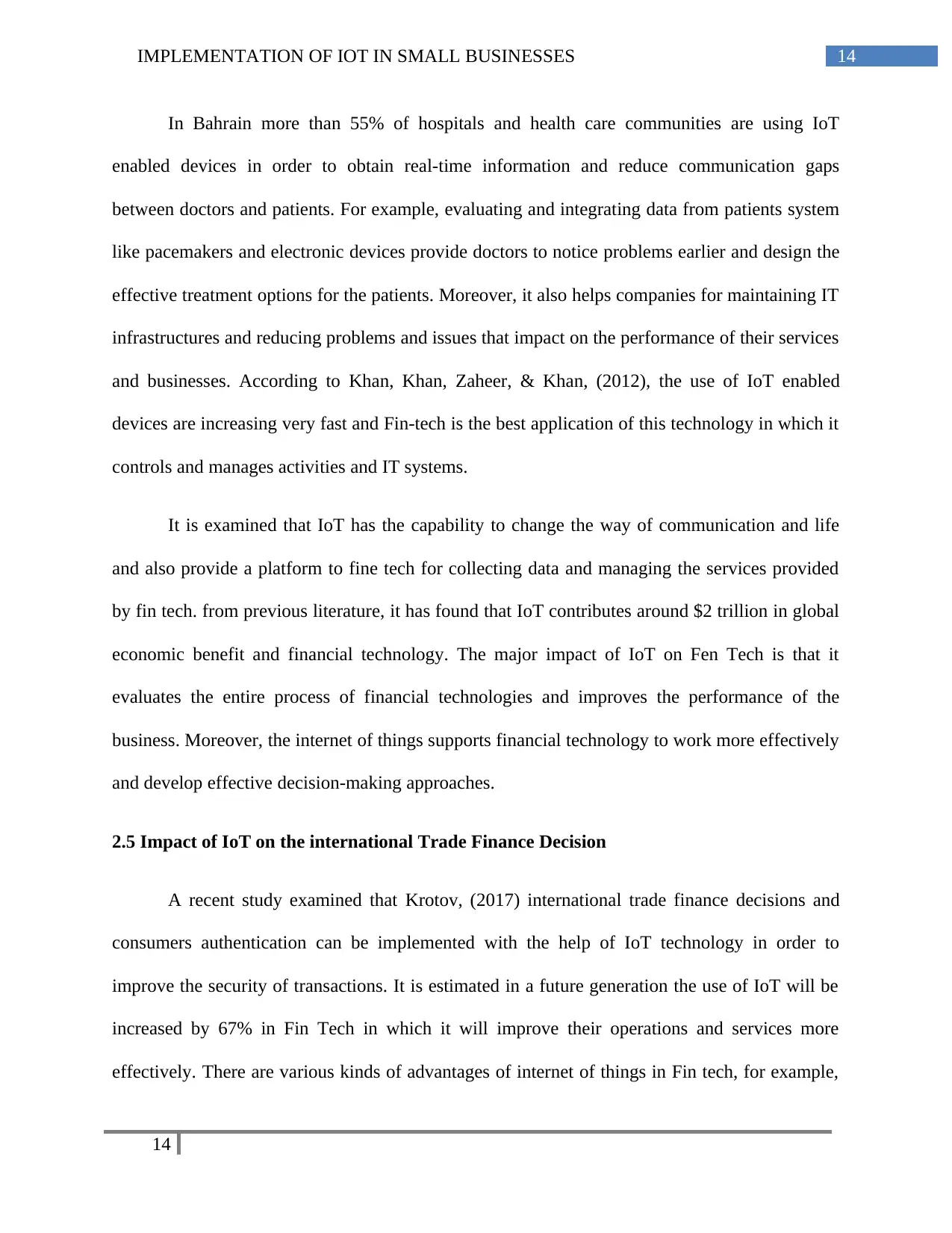
14IMPLEMENTATION OF IOT IN SMALL BUSINESSES
In Bahrain more than 55% of hospitals and health care communities are using IoT
enabled devices in order to obtain real-time information and reduce communication gaps
between doctors and patients. For example, evaluating and integrating data from patients system
like pacemakers and electronic devices provide doctors to notice problems earlier and design the
effective treatment options for the patients. Moreover, it also helps companies for maintaining IT
infrastructures and reducing problems and issues that impact on the performance of their services
and businesses. According to Khan, Khan, Zaheer, & Khan, (2012), the use of IoT enabled
devices are increasing very fast and Fin-tech is the best application of this technology in which it
controls and manages activities and IT systems.
It is examined that IoT has the capability to change the way of communication and life
and also provide a platform to fine tech for collecting data and managing the services provided
by fin tech. from previous literature, it has found that IoT contributes around $2 trillion in global
economic benefit and financial technology. The major impact of IoT on Fen Tech is that it
evaluates the entire process of financial technologies and improves the performance of the
business. Moreover, the internet of things supports financial technology to work more effectively
and develop effective decision-making approaches.
2.5 Impact of IoT on the international Trade Finance Decision
A recent study examined that Krotov, (2017) international trade finance decisions and
consumers authentication can be implemented with the help of IoT technology in order to
improve the security of transactions. It is estimated in a future generation the use of IoT will be
increased by 67% in Fin Tech in which it will improve their operations and services more
effectively. There are various kinds of advantages of internet of things in Fin tech, for example,
14
In Bahrain more than 55% of hospitals and health care communities are using IoT
enabled devices in order to obtain real-time information and reduce communication gaps
between doctors and patients. For example, evaluating and integrating data from patients system
like pacemakers and electronic devices provide doctors to notice problems earlier and design the
effective treatment options for the patients. Moreover, it also helps companies for maintaining IT
infrastructures and reducing problems and issues that impact on the performance of their services
and businesses. According to Khan, Khan, Zaheer, & Khan, (2012), the use of IoT enabled
devices are increasing very fast and Fin-tech is the best application of this technology in which it
controls and manages activities and IT systems.
It is examined that IoT has the capability to change the way of communication and life
and also provide a platform to fine tech for collecting data and managing the services provided
by fin tech. from previous literature, it has found that IoT contributes around $2 trillion in global
economic benefit and financial technology. The major impact of IoT on Fen Tech is that it
evaluates the entire process of financial technologies and improves the performance of the
business. Moreover, the internet of things supports financial technology to work more effectively
and develop effective decision-making approaches.
2.5 Impact of IoT on the international Trade Finance Decision
A recent study examined that Krotov, (2017) international trade finance decisions and
consumers authentication can be implemented with the help of IoT technology in order to
improve the security of transactions. It is estimated in a future generation the use of IoT will be
increased by 67% in Fin Tech in which it will improve their operations and services more
effectively. There are various kinds of advantages of internet of things in Fin tech, for example,
14
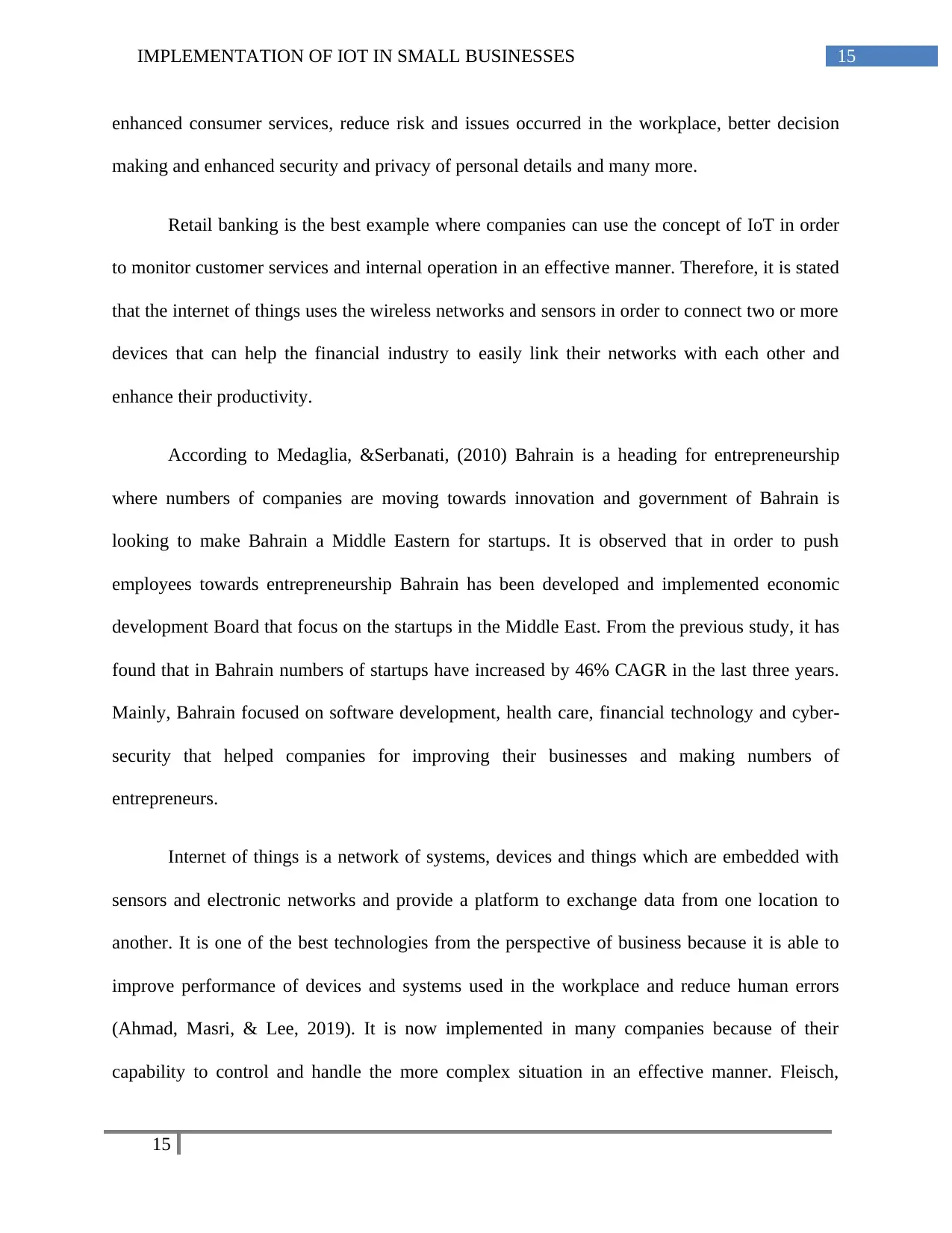
15IMPLEMENTATION OF IOT IN SMALL BUSINESSES
enhanced consumer services, reduce risk and issues occurred in the workplace, better decision
making and enhanced security and privacy of personal details and many more.
Retail banking is the best example where companies can use the concept of IoT in order
to monitor customer services and internal operation in an effective manner. Therefore, it is stated
that the internet of things uses the wireless networks and sensors in order to connect two or more
devices that can help the financial industry to easily link their networks with each other and
enhance their productivity.
According to Medaglia, &Serbanati, (2010) Bahrain is a heading for entrepreneurship
where numbers of companies are moving towards innovation and government of Bahrain is
looking to make Bahrain a Middle Eastern for startups. It is observed that in order to push
employees towards entrepreneurship Bahrain has been developed and implemented economic
development Board that focus on the startups in the Middle East. From the previous study, it has
found that in Bahrain numbers of startups have increased by 46% CAGR in the last three years.
Mainly, Bahrain focused on software development, health care, financial technology and cyber-
security that helped companies for improving their businesses and making numbers of
entrepreneurs.
Internet of things is a network of systems, devices and things which are embedded with
sensors and electronic networks and provide a platform to exchange data from one location to
another. It is one of the best technologies from the perspective of business because it is able to
improve performance of devices and systems used in the workplace and reduce human errors
(Ahmad, Masri, & Lee, 2019). It is now implemented in many companies because of their
capability to control and handle the more complex situation in an effective manner. Fleisch,
15
enhanced consumer services, reduce risk and issues occurred in the workplace, better decision
making and enhanced security and privacy of personal details and many more.
Retail banking is the best example where companies can use the concept of IoT in order
to monitor customer services and internal operation in an effective manner. Therefore, it is stated
that the internet of things uses the wireless networks and sensors in order to connect two or more
devices that can help the financial industry to easily link their networks with each other and
enhance their productivity.
According to Medaglia, &Serbanati, (2010) Bahrain is a heading for entrepreneurship
where numbers of companies are moving towards innovation and government of Bahrain is
looking to make Bahrain a Middle Eastern for startups. It is observed that in order to push
employees towards entrepreneurship Bahrain has been developed and implemented economic
development Board that focus on the startups in the Middle East. From the previous study, it has
found that in Bahrain numbers of startups have increased by 46% CAGR in the last three years.
Mainly, Bahrain focused on software development, health care, financial technology and cyber-
security that helped companies for improving their businesses and making numbers of
entrepreneurs.
Internet of things is a network of systems, devices and things which are embedded with
sensors and electronic networks and provide a platform to exchange data from one location to
another. It is one of the best technologies from the perspective of business because it is able to
improve performance of devices and systems used in the workplace and reduce human errors
(Ahmad, Masri, & Lee, 2019). It is now implemented in many companies because of their
capability to control and handle the more complex situation in an effective manner. Fleisch,
15
Secure Best Marks with AI Grader
Need help grading? Try our AI Grader for instant feedback on your assignments.
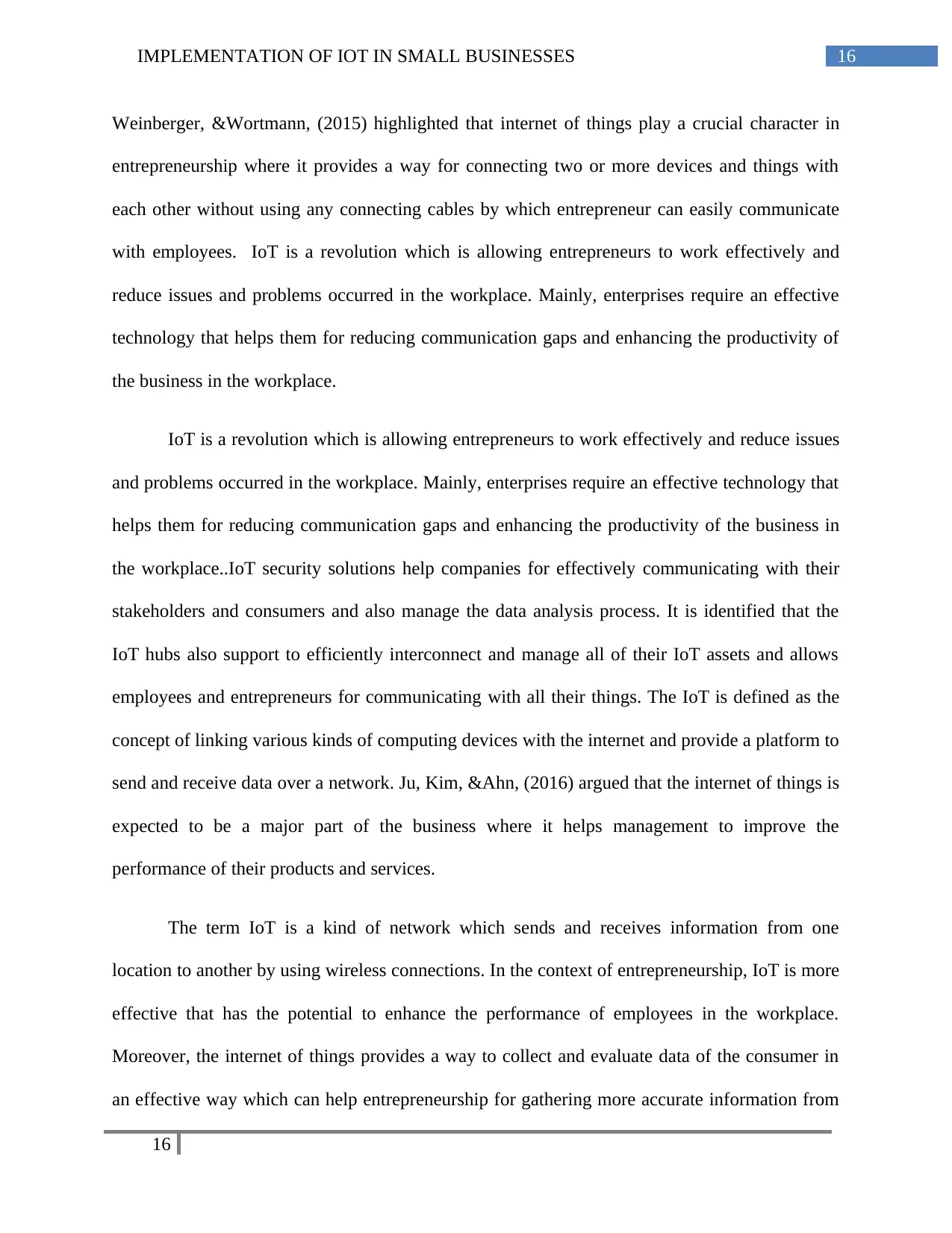
16IMPLEMENTATION OF IOT IN SMALL BUSINESSES
Weinberger, &Wortmann, (2015) highlighted that internet of things play a crucial character in
entrepreneurship where it provides a way for connecting two or more devices and things with
each other without using any connecting cables by which entrepreneur can easily communicate
with employees. IoT is a revolution which is allowing entrepreneurs to work effectively and
reduce issues and problems occurred in the workplace. Mainly, enterprises require an effective
technology that helps them for reducing communication gaps and enhancing the productivity of
the business in the workplace.
IoT is a revolution which is allowing entrepreneurs to work effectively and reduce issues
and problems occurred in the workplace. Mainly, enterprises require an effective technology that
helps them for reducing communication gaps and enhancing the productivity of the business in
the workplace..IoT security solutions help companies for effectively communicating with their
stakeholders and consumers and also manage the data analysis process. It is identified that the
IoT hubs also support to efficiently interconnect and manage all of their IoT assets and allows
employees and entrepreneurs for communicating with all their things. The IoT is defined as the
concept of linking various kinds of computing devices with the internet and provide a platform to
send and receive data over a network. Ju, Kim, &Ahn, (2016) argued that the internet of things is
expected to be a major part of the business where it helps management to improve the
performance of their products and services.
The term IoT is a kind of network which sends and receives information from one
location to another by using wireless connections. In the context of entrepreneurship, IoT is more
effective that has the potential to enhance the performance of employees in the workplace.
Moreover, the internet of things provides a way to collect and evaluate data of the consumer in
an effective way which can help entrepreneurship for gathering more accurate information from
16
Weinberger, &Wortmann, (2015) highlighted that internet of things play a crucial character in
entrepreneurship where it provides a way for connecting two or more devices and things with
each other without using any connecting cables by which entrepreneur can easily communicate
with employees. IoT is a revolution which is allowing entrepreneurs to work effectively and
reduce issues and problems occurred in the workplace. Mainly, enterprises require an effective
technology that helps them for reducing communication gaps and enhancing the productivity of
the business in the workplace.
IoT is a revolution which is allowing entrepreneurs to work effectively and reduce issues
and problems occurred in the workplace. Mainly, enterprises require an effective technology that
helps them for reducing communication gaps and enhancing the productivity of the business in
the workplace..IoT security solutions help companies for effectively communicating with their
stakeholders and consumers and also manage the data analysis process. It is identified that the
IoT hubs also support to efficiently interconnect and manage all of their IoT assets and allows
employees and entrepreneurs for communicating with all their things. The IoT is defined as the
concept of linking various kinds of computing devices with the internet and provide a platform to
send and receive data over a network. Ju, Kim, &Ahn, (2016) argued that the internet of things is
expected to be a major part of the business where it helps management to improve the
performance of their products and services.
The term IoT is a kind of network which sends and receives information from one
location to another by using wireless connections. In the context of entrepreneurship, IoT is more
effective that has the potential to enhance the performance of employees in the workplace.
Moreover, the internet of things provides a way to collect and evaluate data of the consumer in
an effective way which can help entrepreneurship for gathering more accurate information from
16
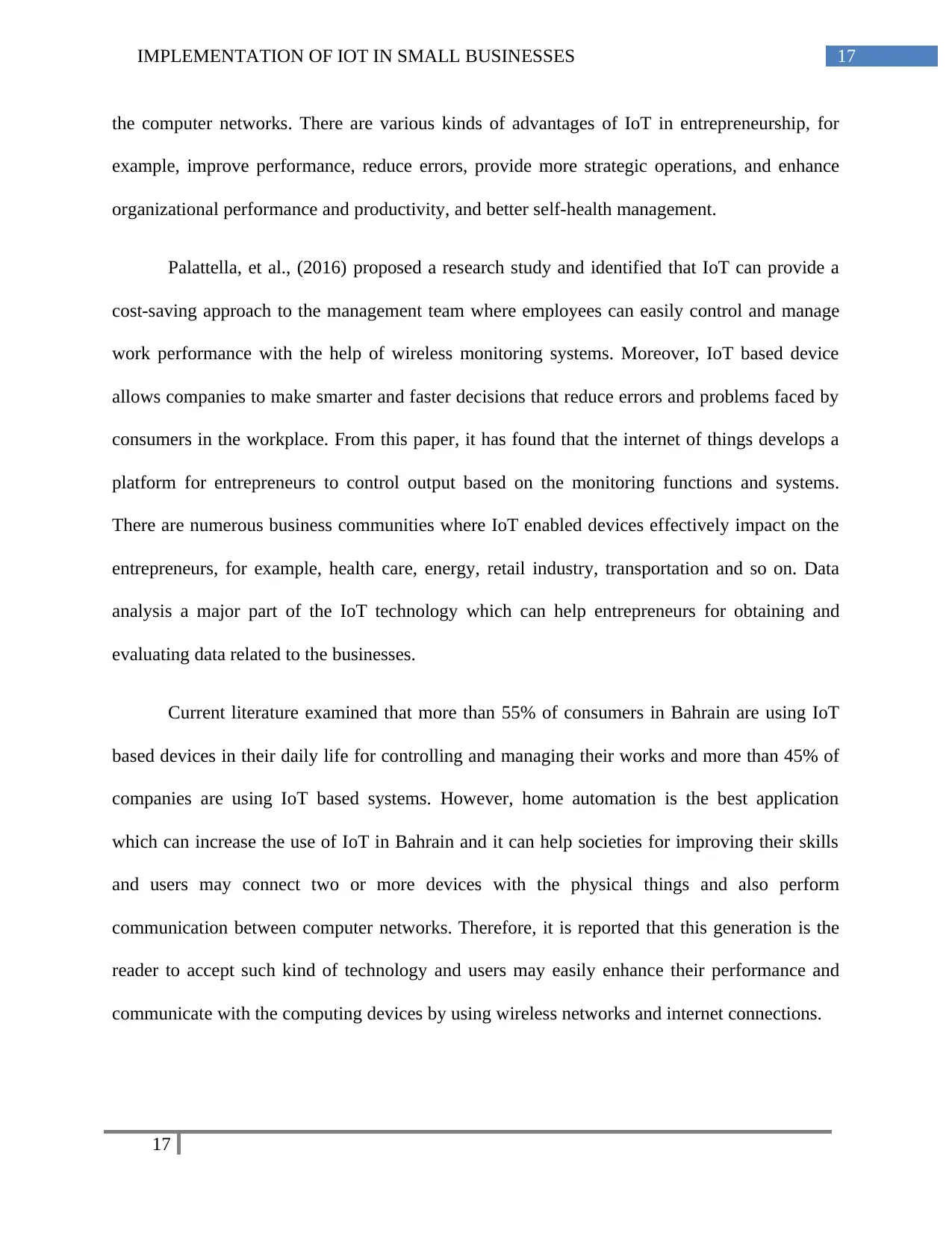
17IMPLEMENTATION OF IOT IN SMALL BUSINESSES
the computer networks. There are various kinds of advantages of IoT in entrepreneurship, for
example, improve performance, reduce errors, provide more strategic operations, and enhance
organizational performance and productivity, and better self-health management.
Palattella, et al., (2016) proposed a research study and identified that IoT can provide a
cost-saving approach to the management team where employees can easily control and manage
work performance with the help of wireless monitoring systems. Moreover, IoT based device
allows companies to make smarter and faster decisions that reduce errors and problems faced by
consumers in the workplace. From this paper, it has found that the internet of things develops a
platform for entrepreneurs to control output based on the monitoring functions and systems.
There are numerous business communities where IoT enabled devices effectively impact on the
entrepreneurs, for example, health care, energy, retail industry, transportation and so on. Data
analysis a major part of the IoT technology which can help entrepreneurs for obtaining and
evaluating data related to the businesses.
Current literature examined that more than 55% of consumers in Bahrain are using IoT
based devices in their daily life for controlling and managing their works and more than 45% of
companies are using IoT based systems. However, home automation is the best application
which can increase the use of IoT in Bahrain and it can help societies for improving their skills
and users may connect two or more devices with the physical things and also perform
communication between computer networks. Therefore, it is reported that this generation is the
reader to accept such kind of technology and users may easily enhance their performance and
communicate with the computing devices by using wireless networks and internet connections.
17
the computer networks. There are various kinds of advantages of IoT in entrepreneurship, for
example, improve performance, reduce errors, provide more strategic operations, and enhance
organizational performance and productivity, and better self-health management.
Palattella, et al., (2016) proposed a research study and identified that IoT can provide a
cost-saving approach to the management team where employees can easily control and manage
work performance with the help of wireless monitoring systems. Moreover, IoT based device
allows companies to make smarter and faster decisions that reduce errors and problems faced by
consumers in the workplace. From this paper, it has found that the internet of things develops a
platform for entrepreneurs to control output based on the monitoring functions and systems.
There are numerous business communities where IoT enabled devices effectively impact on the
entrepreneurs, for example, health care, energy, retail industry, transportation and so on. Data
analysis a major part of the IoT technology which can help entrepreneurs for obtaining and
evaluating data related to the businesses.
Current literature examined that more than 55% of consumers in Bahrain are using IoT
based devices in their daily life for controlling and managing their works and more than 45% of
companies are using IoT based systems. However, home automation is the best application
which can increase the use of IoT in Bahrain and it can help societies for improving their skills
and users may connect two or more devices with the physical things and also perform
communication between computer networks. Therefore, it is reported that this generation is the
reader to accept such kind of technology and users may easily enhance their performance and
communicate with the computing devices by using wireless networks and internet connections.
17
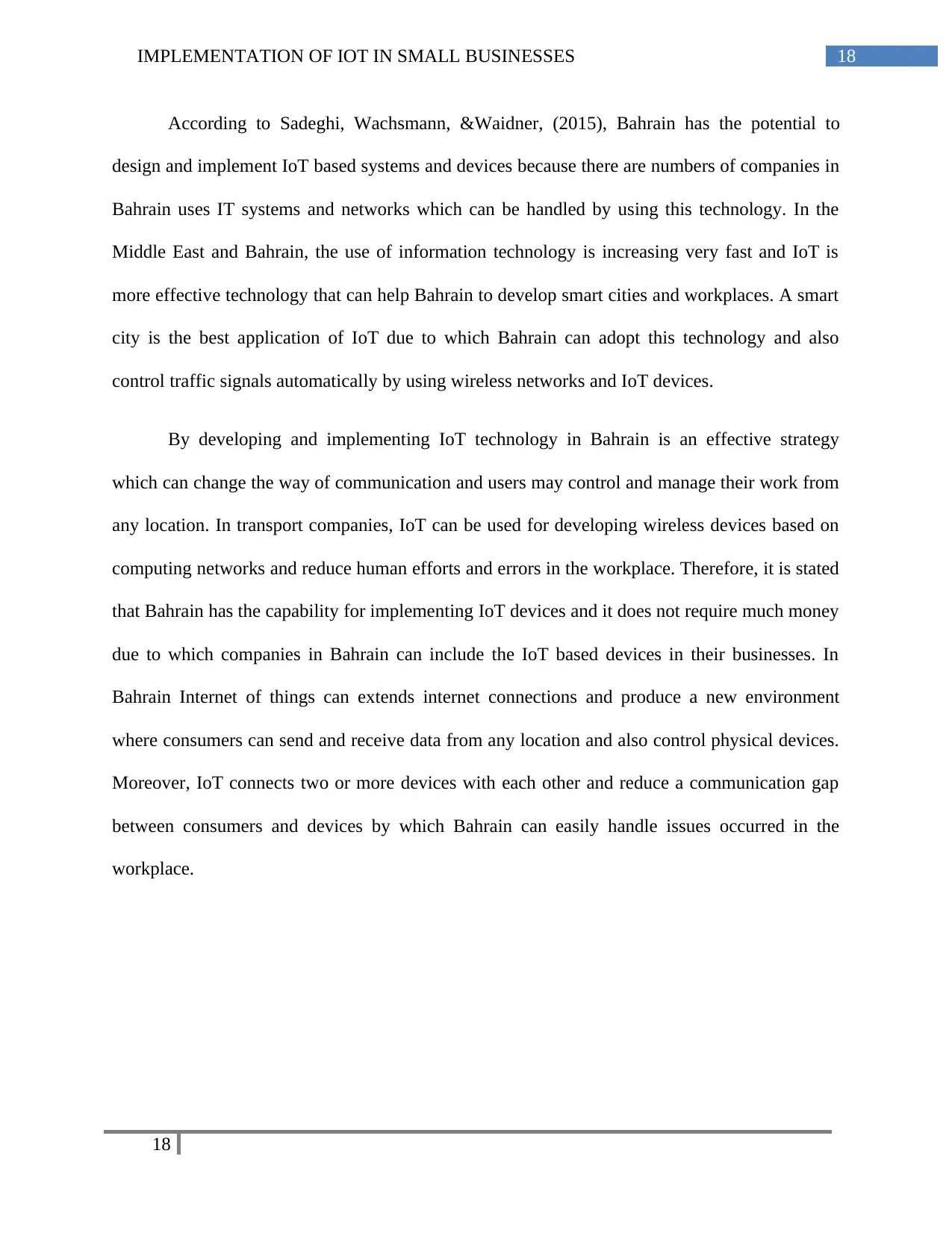
18IMPLEMENTATION OF IOT IN SMALL BUSINESSES
According to Sadeghi, Wachsmann, &Waidner, (2015), Bahrain has the potential to
design and implement IoT based systems and devices because there are numbers of companies in
Bahrain uses IT systems and networks which can be handled by using this technology. In the
Middle East and Bahrain, the use of information technology is increasing very fast and IoT is
more effective technology that can help Bahrain to develop smart cities and workplaces. A smart
city is the best application of IoT due to which Bahrain can adopt this technology and also
control traffic signals automatically by using wireless networks and IoT devices.
By developing and implementing IoT technology in Bahrain is an effective strategy
which can change the way of communication and users may control and manage their work from
any location. In transport companies, IoT can be used for developing wireless devices based on
computing networks and reduce human efforts and errors in the workplace. Therefore, it is stated
that Bahrain has the capability for implementing IoT devices and it does not require much money
due to which companies in Bahrain can include the IoT based devices in their businesses. In
Bahrain Internet of things can extends internet connections and produce a new environment
where consumers can send and receive data from any location and also control physical devices.
Moreover, IoT connects two or more devices with each other and reduce a communication gap
between consumers and devices by which Bahrain can easily handle issues occurred in the
workplace.
18
According to Sadeghi, Wachsmann, &Waidner, (2015), Bahrain has the potential to
design and implement IoT based systems and devices because there are numbers of companies in
Bahrain uses IT systems and networks which can be handled by using this technology. In the
Middle East and Bahrain, the use of information technology is increasing very fast and IoT is
more effective technology that can help Bahrain to develop smart cities and workplaces. A smart
city is the best application of IoT due to which Bahrain can adopt this technology and also
control traffic signals automatically by using wireless networks and IoT devices.
By developing and implementing IoT technology in Bahrain is an effective strategy
which can change the way of communication and users may control and manage their work from
any location. In transport companies, IoT can be used for developing wireless devices based on
computing networks and reduce human efforts and errors in the workplace. Therefore, it is stated
that Bahrain has the capability for implementing IoT devices and it does not require much money
due to which companies in Bahrain can include the IoT based devices in their businesses. In
Bahrain Internet of things can extends internet connections and produce a new environment
where consumers can send and receive data from any location and also control physical devices.
Moreover, IoT connects two or more devices with each other and reduce a communication gap
between consumers and devices by which Bahrain can easily handle issues occurred in the
workplace.
18
Paraphrase This Document
Need a fresh take? Get an instant paraphrase of this document with our AI Paraphraser
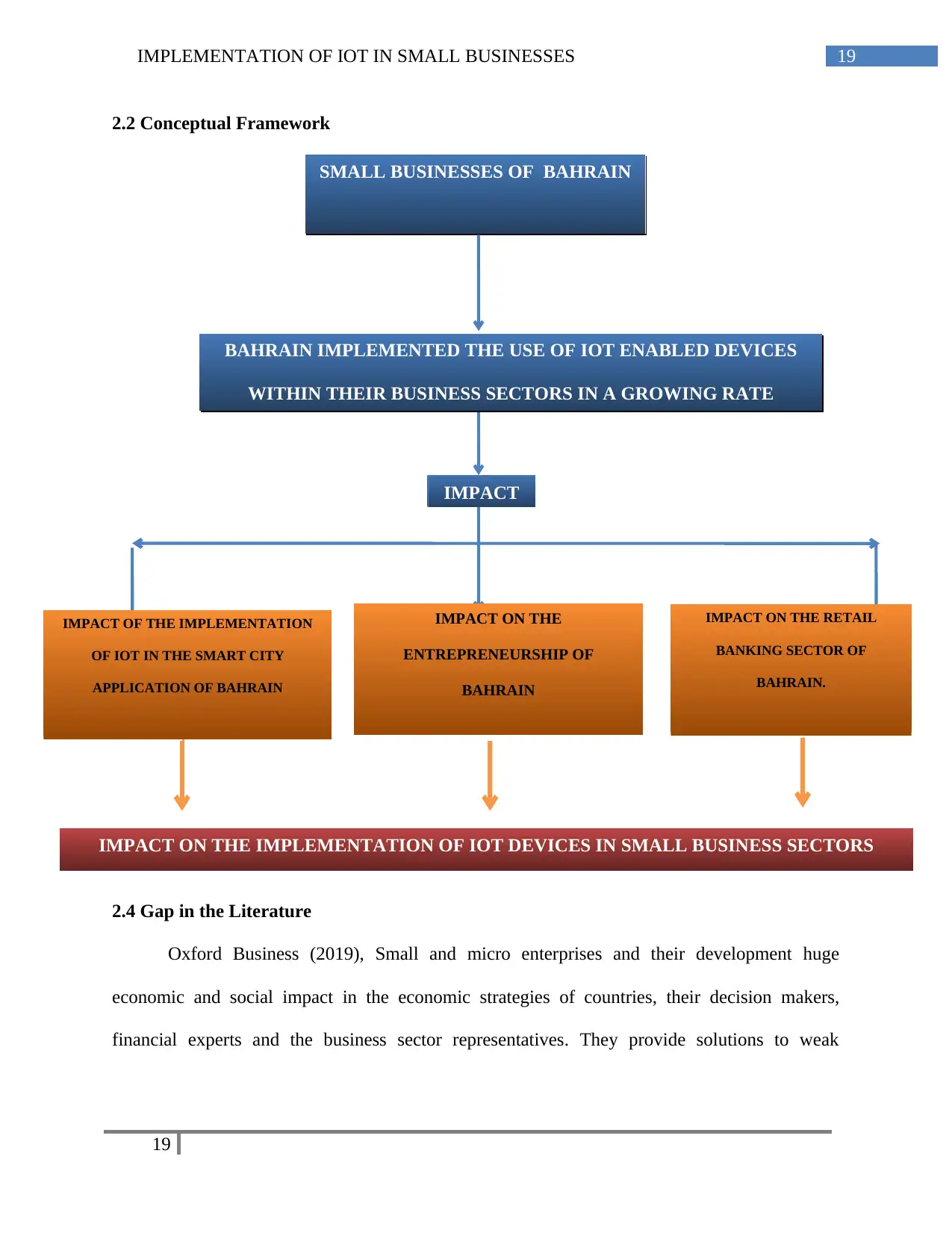
19IMPLEMENTATION OF IOT IN SMALL BUSINESSES
2.2 Conceptual Framework
2.4 Gap in the Literature
Oxford Business (2019), Small and micro enterprises and their development huge
economic and social impact in the economic strategies of countries, their decision makers,
financial experts and the business sector representatives. They provide solutions to weak
19
SMALL BUSINESSES OF BAHRAIN
BAHRAIN IMPLEMENTED THE USE OF IOT ENABLED DEVICES
WITHIN THEIR BUSINESS SECTORS IN A GROWING RATE
IMPACT
IMPACT OF THE IMPLEMENTATION
OF IOT IN THE SMART CITY
APPLICATION OF BAHRAIN
IMPACT ON THE
ENTREPRENEURSHIP OF
BAHRAIN
IMPACT ON THE RETAIL
BANKING SECTOR OF
BAHRAIN.
IMPACT ON THE IMPLEMENTATION OF IOT DEVICES IN SMALL BUSINESS SECTORS
2.2 Conceptual Framework
2.4 Gap in the Literature
Oxford Business (2019), Small and micro enterprises and their development huge
economic and social impact in the economic strategies of countries, their decision makers,
financial experts and the business sector representatives. They provide solutions to weak
19
SMALL BUSINESSES OF BAHRAIN
BAHRAIN IMPLEMENTED THE USE OF IOT ENABLED DEVICES
WITHIN THEIR BUSINESS SECTORS IN A GROWING RATE
IMPACT
IMPACT OF THE IMPLEMENTATION
OF IOT IN THE SMART CITY
APPLICATION OF BAHRAIN
IMPACT ON THE
ENTREPRENEURSHIP OF
BAHRAIN
IMPACT ON THE RETAIL
BANKING SECTOR OF
BAHRAIN.
IMPACT ON THE IMPLEMENTATION OF IOT DEVICES IN SMALL BUSINESS SECTORS
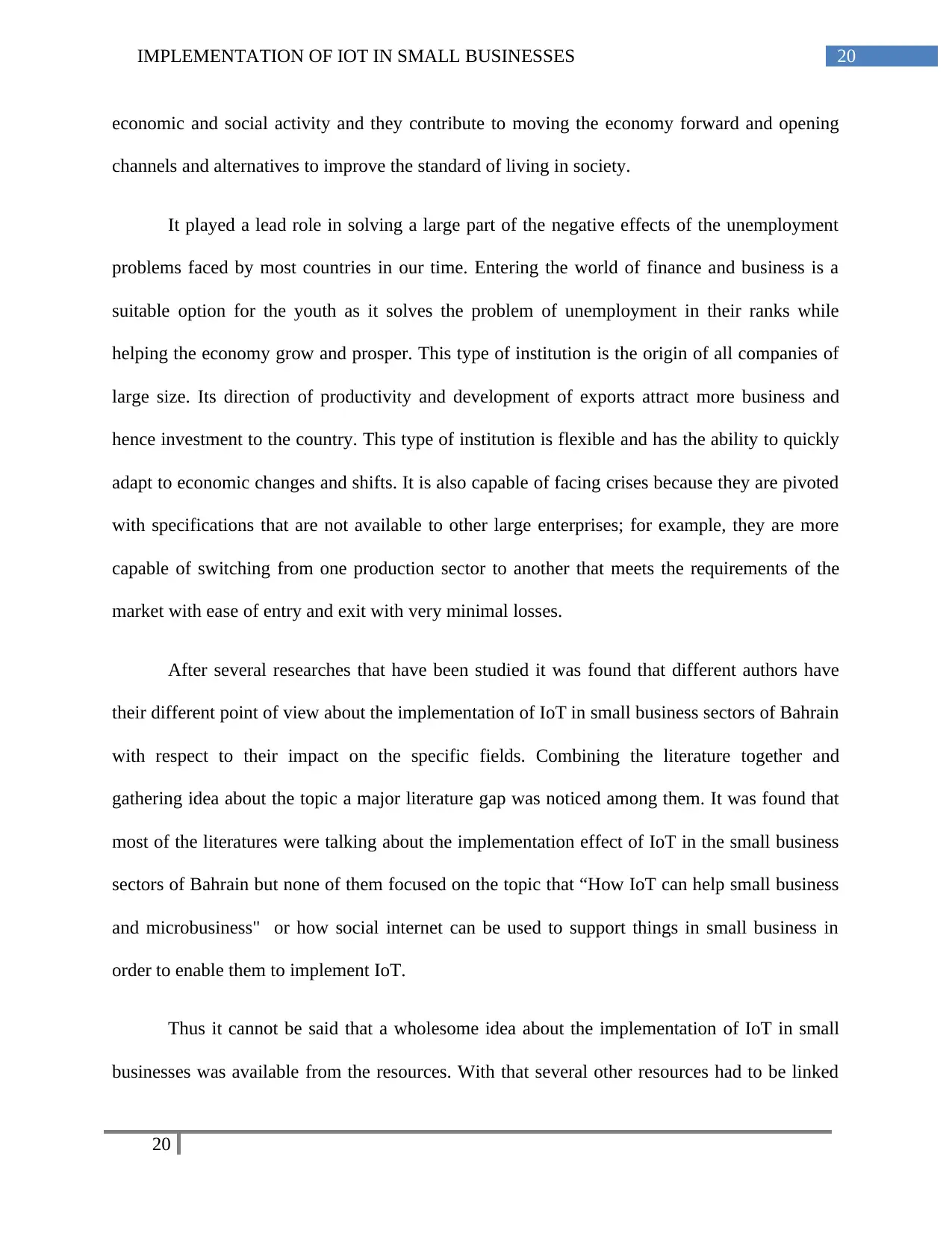
20IMPLEMENTATION OF IOT IN SMALL BUSINESSES
economic and social activity and they contribute to moving the economy forward and opening
channels and alternatives to improve the standard of living in society.
It played a lead role in solving a large part of the negative effects of the unemployment
problems faced by most countries in our time. Entering the world of finance and business is a
suitable option for the youth as it solves the problem of unemployment in their ranks while
helping the economy grow and prosper. This type of institution is the origin of all companies of
large size. Its direction of productivity and development of exports attract more business and
hence investment to the country. This type of institution is flexible and has the ability to quickly
adapt to economic changes and shifts. It is also capable of facing crises because they are pivoted
with specifications that are not available to other large enterprises; for example, they are more
capable of switching from one production sector to another that meets the requirements of the
market with ease of entry and exit with very minimal losses.
After several researches that have been studied it was found that different authors have
their different point of view about the implementation of IoT in small business sectors of Bahrain
with respect to their impact on the specific fields. Combining the literature together and
gathering idea about the topic a major literature gap was noticed among them. It was found that
most of the literatures were talking about the implementation effect of IoT in the small business
sectors of Bahrain but none of them focused on the topic that “How IoT can help small business
and microbusiness" or how social internet can be used to support things in small business in
order to enable them to implement IoT.
Thus it cannot be said that a wholesome idea about the implementation of IoT in small
businesses was available from the resources. With that several other resources had to be linked
20
economic and social activity and they contribute to moving the economy forward and opening
channels and alternatives to improve the standard of living in society.
It played a lead role in solving a large part of the negative effects of the unemployment
problems faced by most countries in our time. Entering the world of finance and business is a
suitable option for the youth as it solves the problem of unemployment in their ranks while
helping the economy grow and prosper. This type of institution is the origin of all companies of
large size. Its direction of productivity and development of exports attract more business and
hence investment to the country. This type of institution is flexible and has the ability to quickly
adapt to economic changes and shifts. It is also capable of facing crises because they are pivoted
with specifications that are not available to other large enterprises; for example, they are more
capable of switching from one production sector to another that meets the requirements of the
market with ease of entry and exit with very minimal losses.
After several researches that have been studied it was found that different authors have
their different point of view about the implementation of IoT in small business sectors of Bahrain
with respect to their impact on the specific fields. Combining the literature together and
gathering idea about the topic a major literature gap was noticed among them. It was found that
most of the literatures were talking about the implementation effect of IoT in the small business
sectors of Bahrain but none of them focused on the topic that “How IoT can help small business
and microbusiness" or how social internet can be used to support things in small business in
order to enable them to implement IoT.
Thus it cannot be said that a wholesome idea about the implementation of IoT in small
businesses was available from the resources. With that several other resources had to be linked
20
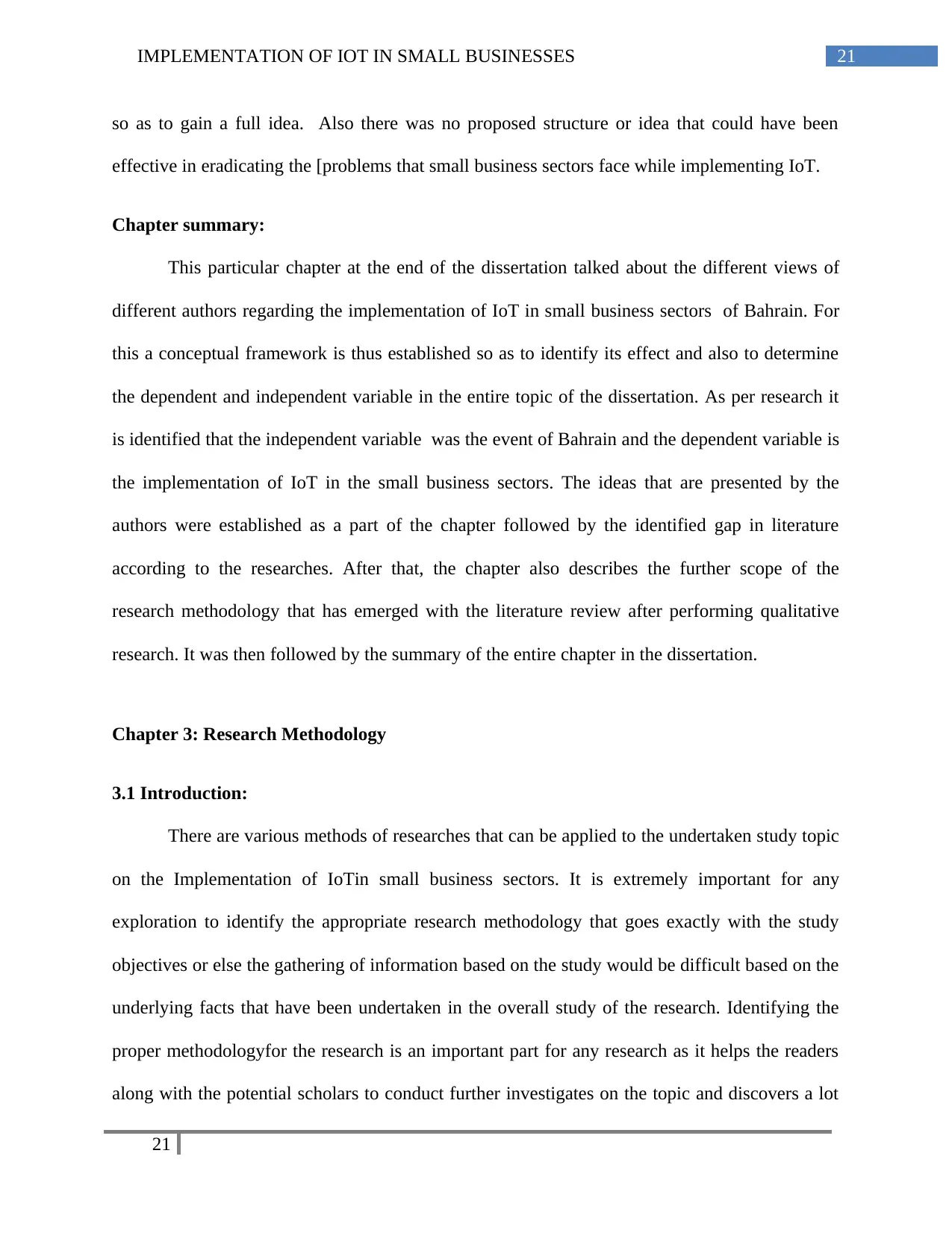
21IMPLEMENTATION OF IOT IN SMALL BUSINESSES
so as to gain a full idea. Also there was no proposed structure or idea that could have been
effective in eradicating the [problems that small business sectors face while implementing IoT.
Chapter summary:
This particular chapter at the end of the dissertation talked about the different views of
different authors regarding the implementation of IoT in small business sectors of Bahrain. For
this a conceptual framework is thus established so as to identify its effect and also to determine
the dependent and independent variable in the entire topic of the dissertation. As per research it
is identified that the independent variable was the event of Bahrain and the dependent variable is
the implementation of IoT in the small business sectors. The ideas that are presented by the
authors were established as a part of the chapter followed by the identified gap in literature
according to the researches. After that, the chapter also describes the further scope of the
research methodology that has emerged with the literature review after performing qualitative
research. It was then followed by the summary of the entire chapter in the dissertation.
Chapter 3: Research Methodology
3.1 Introduction:
There are various methods of researches that can be applied to the undertaken study topic
on the Implementation of IoTin small business sectors. It is extremely important for any
exploration to identify the appropriate research methodology that goes exactly with the study
objectives or else the gathering of information based on the study would be difficult based on the
underlying facts that have been undertaken in the overall study of the research. Identifying the
proper methodologyfor the research is an important part for any research as it helps the readers
along with the potential scholars to conduct further investigates on the topic and discovers a lot
21
so as to gain a full idea. Also there was no proposed structure or idea that could have been
effective in eradicating the [problems that small business sectors face while implementing IoT.
Chapter summary:
This particular chapter at the end of the dissertation talked about the different views of
different authors regarding the implementation of IoT in small business sectors of Bahrain. For
this a conceptual framework is thus established so as to identify its effect and also to determine
the dependent and independent variable in the entire topic of the dissertation. As per research it
is identified that the independent variable was the event of Bahrain and the dependent variable is
the implementation of IoT in the small business sectors. The ideas that are presented by the
authors were established as a part of the chapter followed by the identified gap in literature
according to the researches. After that, the chapter also describes the further scope of the
research methodology that has emerged with the literature review after performing qualitative
research. It was then followed by the summary of the entire chapter in the dissertation.
Chapter 3: Research Methodology
3.1 Introduction:
There are various methods of researches that can be applied to the undertaken study topic
on the Implementation of IoTin small business sectors. It is extremely important for any
exploration to identify the appropriate research methodology that goes exactly with the study
objectives or else the gathering of information based on the study would be difficult based on the
underlying facts that have been undertaken in the overall study of the research. Identifying the
proper methodologyfor the research is an important part for any research as it helps the readers
along with the potential scholars to conduct further investigates on the topic and discovers a lot
21
Secure Best Marks with AI Grader
Need help grading? Try our AI Grader for instant feedback on your assignments.
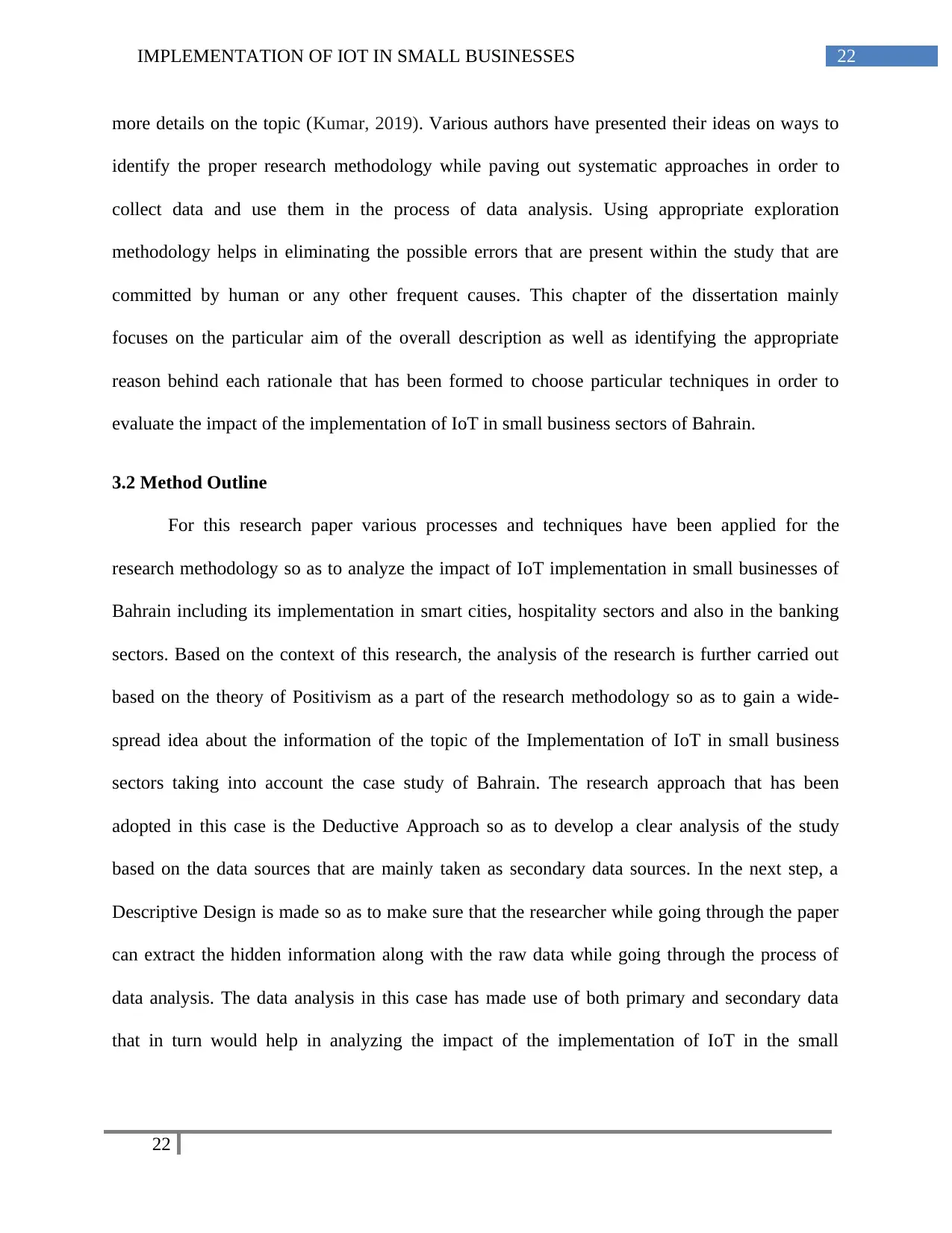
22IMPLEMENTATION OF IOT IN SMALL BUSINESSES
more details on the topic (Kumar, 2019). Various authors have presented their ideas on ways to
identify the proper research methodology while paving out systematic approaches in order to
collect data and use them in the process of data analysis. Using appropriate exploration
methodology helps in eliminating the possible errors that are present within the study that are
committed by human or any other frequent causes. This chapter of the dissertation mainly
focuses on the particular aim of the overall description as well as identifying the appropriate
reason behind each rationale that has been formed to choose particular techniques in order to
evaluate the impact of the implementation of IoT in small business sectors of Bahrain.
3.2 Method Outline
For this research paper various processes and techniques have been applied for the
research methodology so as to analyze the impact of IoT implementation in small businesses of
Bahrain including its implementation in smart cities, hospitality sectors and also in the banking
sectors. Based on the context of this research, the analysis of the research is further carried out
based on the theory of Positivism as a part of the research methodology so as to gain a wide-
spread idea about the information of the topic of the Implementation of IoT in small business
sectors taking into account the case study of Bahrain. The research approach that has been
adopted in this case is the Deductive Approach so as to develop a clear analysis of the study
based on the data sources that are mainly taken as secondary data sources. In the next step, a
Descriptive Design is made so as to make sure that the researcher while going through the paper
can extract the hidden information along with the raw data while going through the process of
data analysis. The data analysis in this case has made use of both primary and secondary data
that in turn would help in analyzing the impact of the implementation of IoT in the small
22
more details on the topic (Kumar, 2019). Various authors have presented their ideas on ways to
identify the proper research methodology while paving out systematic approaches in order to
collect data and use them in the process of data analysis. Using appropriate exploration
methodology helps in eliminating the possible errors that are present within the study that are
committed by human or any other frequent causes. This chapter of the dissertation mainly
focuses on the particular aim of the overall description as well as identifying the appropriate
reason behind each rationale that has been formed to choose particular techniques in order to
evaluate the impact of the implementation of IoT in small business sectors of Bahrain.
3.2 Method Outline
For this research paper various processes and techniques have been applied for the
research methodology so as to analyze the impact of IoT implementation in small businesses of
Bahrain including its implementation in smart cities, hospitality sectors and also in the banking
sectors. Based on the context of this research, the analysis of the research is further carried out
based on the theory of Positivism as a part of the research methodology so as to gain a wide-
spread idea about the information of the topic of the Implementation of IoT in small business
sectors taking into account the case study of Bahrain. The research approach that has been
adopted in this case is the Deductive Approach so as to develop a clear analysis of the study
based on the data sources that are mainly taken as secondary data sources. In the next step, a
Descriptive Design is made so as to make sure that the researcher while going through the paper
can extract the hidden information along with the raw data while going through the process of
data analysis. The data analysis in this case has made use of both primary and secondary data
that in turn would help in analyzing the impact of the implementation of IoT in the small
22
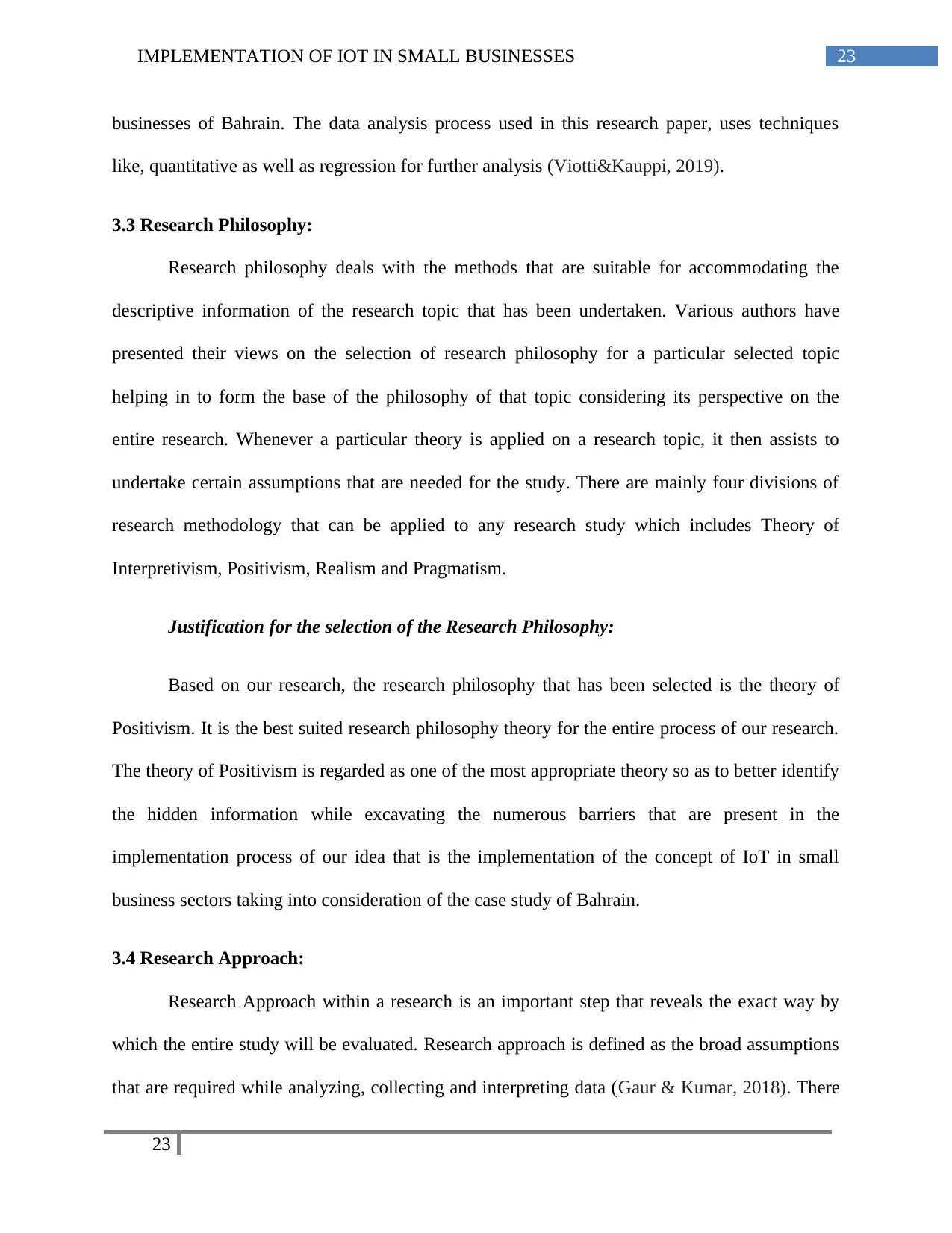
23IMPLEMENTATION OF IOT IN SMALL BUSINESSES
businesses of Bahrain. The data analysis process used in this research paper, uses techniques
like, quantitative as well as regression for further analysis (Viotti&Kauppi, 2019).
3.3 Research Philosophy:
Research philosophy deals with the methods that are suitable for accommodating the
descriptive information of the research topic that has been undertaken. Various authors have
presented their views on the selection of research philosophy for a particular selected topic
helping in to form the base of the philosophy of that topic considering its perspective on the
entire research. Whenever a particular theory is applied on a research topic, it then assists to
undertake certain assumptions that are needed for the study. There are mainly four divisions of
research methodology that can be applied to any research study which includes Theory of
Interpretivism, Positivism, Realism and Pragmatism.
Justification for the selection of the Research Philosophy:
Based on our research, the research philosophy that has been selected is the theory of
Positivism. It is the best suited research philosophy theory for the entire process of our research.
The theory of Positivism is regarded as one of the most appropriate theory so as to better identify
the hidden information while excavating the numerous barriers that are present in the
implementation process of our idea that is the implementation of the concept of IoT in small
business sectors taking into consideration of the case study of Bahrain.
3.4 Research Approach:
Research Approach within a research is an important step that reveals the exact way by
which the entire study will be evaluated. Research approach is defined as the broad assumptions
that are required while analyzing, collecting and interpreting data (Gaur & Kumar, 2018). There
23
businesses of Bahrain. The data analysis process used in this research paper, uses techniques
like, quantitative as well as regression for further analysis (Viotti&Kauppi, 2019).
3.3 Research Philosophy:
Research philosophy deals with the methods that are suitable for accommodating the
descriptive information of the research topic that has been undertaken. Various authors have
presented their views on the selection of research philosophy for a particular selected topic
helping in to form the base of the philosophy of that topic considering its perspective on the
entire research. Whenever a particular theory is applied on a research topic, it then assists to
undertake certain assumptions that are needed for the study. There are mainly four divisions of
research methodology that can be applied to any research study which includes Theory of
Interpretivism, Positivism, Realism and Pragmatism.
Justification for the selection of the Research Philosophy:
Based on our research, the research philosophy that has been selected is the theory of
Positivism. It is the best suited research philosophy theory for the entire process of our research.
The theory of Positivism is regarded as one of the most appropriate theory so as to better identify
the hidden information while excavating the numerous barriers that are present in the
implementation process of our idea that is the implementation of the concept of IoT in small
business sectors taking into consideration of the case study of Bahrain.
3.4 Research Approach:
Research Approach within a research is an important step that reveals the exact way by
which the entire study will be evaluated. Research approach is defined as the broad assumptions
that are required while analyzing, collecting and interpreting data (Gaur & Kumar, 2018). There
23
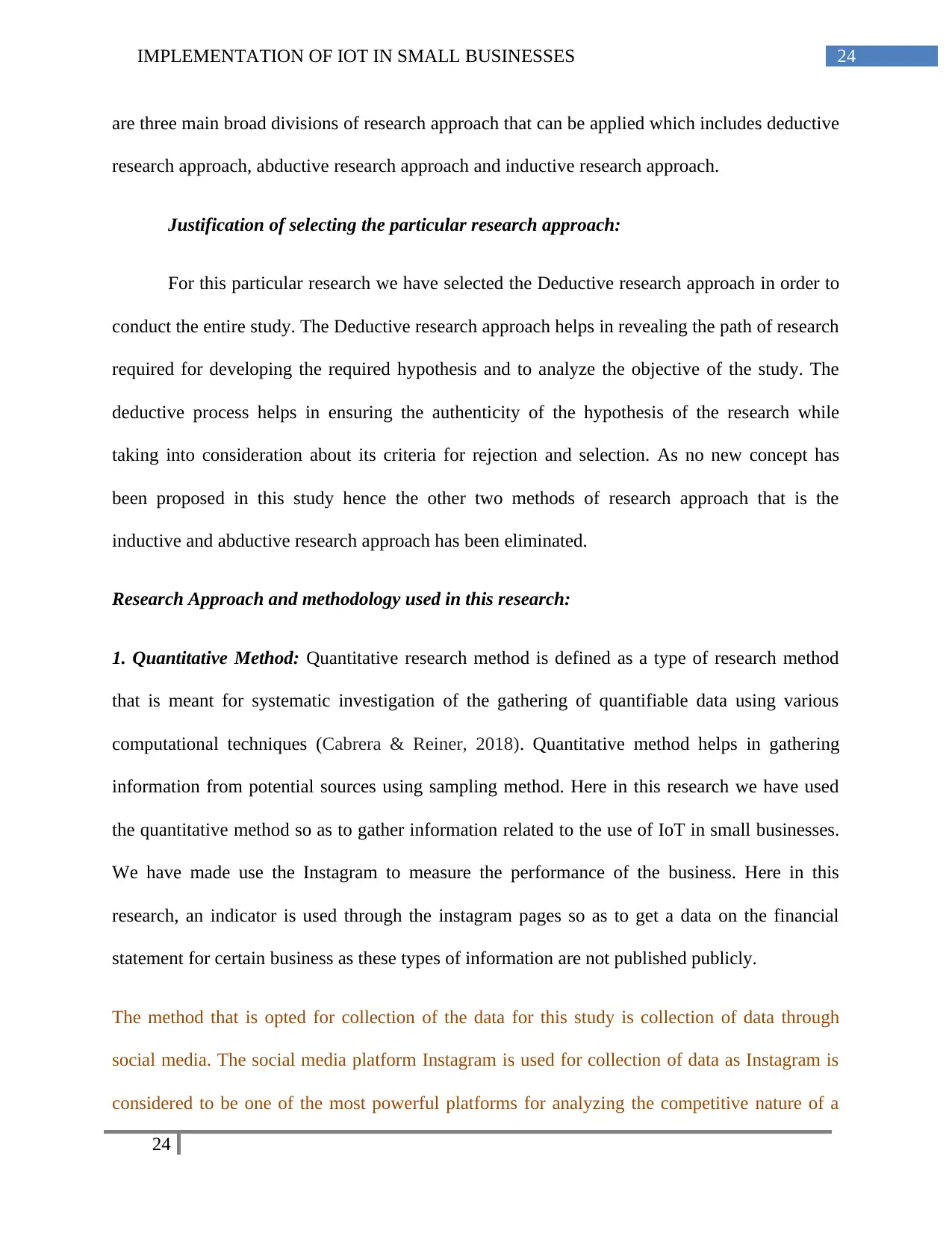
24IMPLEMENTATION OF IOT IN SMALL BUSINESSES
are three main broad divisions of research approach that can be applied which includes deductive
research approach, abductive research approach and inductive research approach.
Justification of selecting the particular research approach:
For this particular research we have selected the Deductive research approach in order to
conduct the entire study. The Deductive research approach helps in revealing the path of research
required for developing the required hypothesis and to analyze the objective of the study. The
deductive process helps in ensuring the authenticity of the hypothesis of the research while
taking into consideration about its criteria for rejection and selection. As no new concept has
been proposed in this study hence the other two methods of research approach that is the
inductive and abductive research approach has been eliminated.
Research Approach and methodology used in this research:
1. Quantitative Method: Quantitative research method is defined as a type of research method
that is meant for systematic investigation of the gathering of quantifiable data using various
computational techniques (Cabrera & Reiner, 2018). Quantitative method helps in gathering
information from potential sources using sampling method. Here in this research we have used
the quantitative method so as to gather information related to the use of IoT in small businesses.
We have made use the Instagram to measure the performance of the business. Here in this
research, an indicator is used through the instagram pages so as to get a data on the financial
statement for certain business as these types of information are not published publicly.
The method that is opted for collection of the data for this study is collection of data through
social media. The social media platform Instagram is used for collection of data as Instagram is
considered to be one of the most powerful platforms for analyzing the competitive nature of a
24
are three main broad divisions of research approach that can be applied which includes deductive
research approach, abductive research approach and inductive research approach.
Justification of selecting the particular research approach:
For this particular research we have selected the Deductive research approach in order to
conduct the entire study. The Deductive research approach helps in revealing the path of research
required for developing the required hypothesis and to analyze the objective of the study. The
deductive process helps in ensuring the authenticity of the hypothesis of the research while
taking into consideration about its criteria for rejection and selection. As no new concept has
been proposed in this study hence the other two methods of research approach that is the
inductive and abductive research approach has been eliminated.
Research Approach and methodology used in this research:
1. Quantitative Method: Quantitative research method is defined as a type of research method
that is meant for systematic investigation of the gathering of quantifiable data using various
computational techniques (Cabrera & Reiner, 2018). Quantitative method helps in gathering
information from potential sources using sampling method. Here in this research we have used
the quantitative method so as to gather information related to the use of IoT in small businesses.
We have made use the Instagram to measure the performance of the business. Here in this
research, an indicator is used through the instagram pages so as to get a data on the financial
statement for certain business as these types of information are not published publicly.
The method that is opted for collection of the data for this study is collection of data through
social media. The social media platform Instagram is used for collection of data as Instagram is
considered to be one of the most powerful platforms for analyzing the competitive nature of a
24
Paraphrase This Document
Need a fresh take? Get an instant paraphrase of this document with our AI Paraphraser
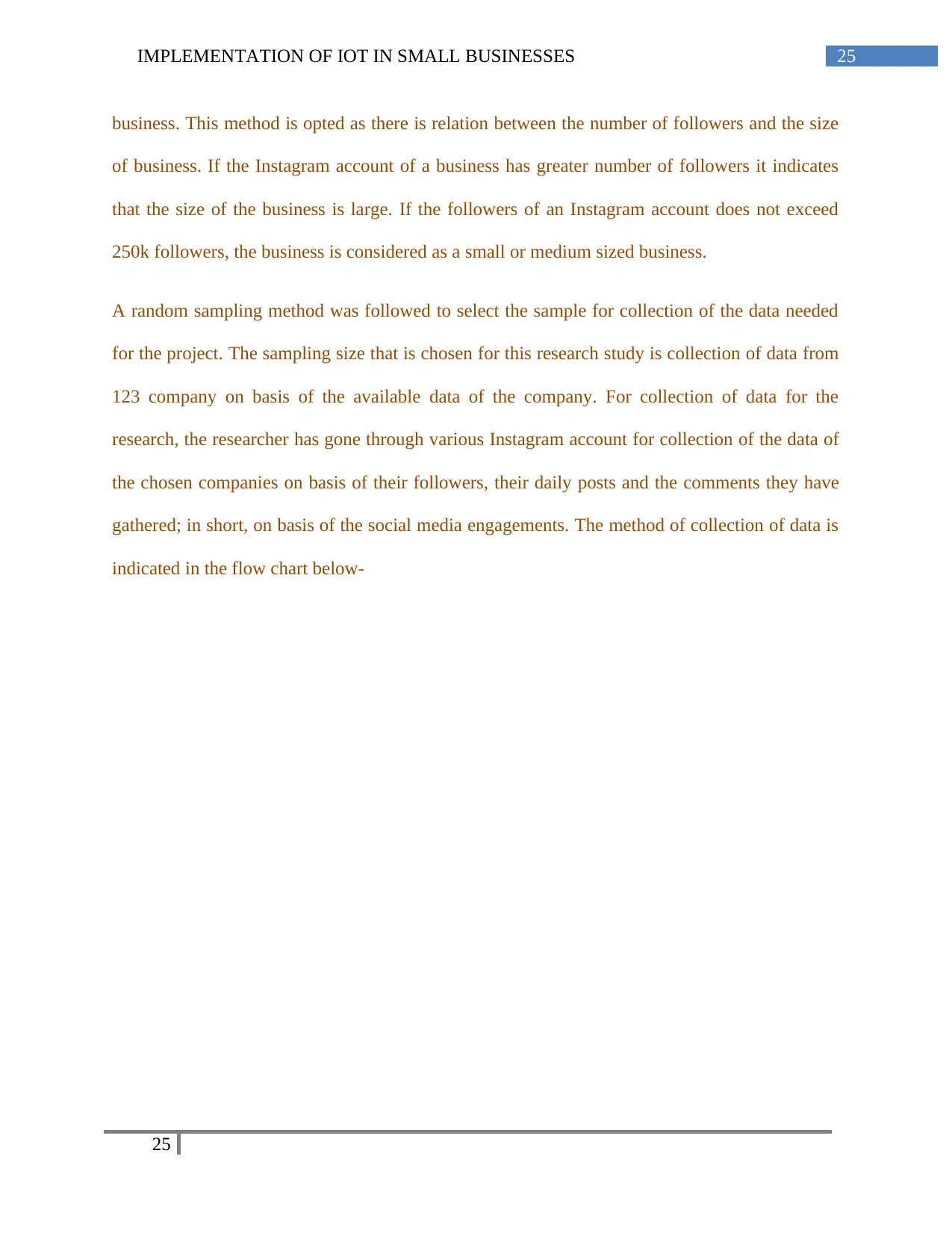
25IMPLEMENTATION OF IOT IN SMALL BUSINESSES
business. This method is opted as there is relation between the number of followers and the size
of business. If the Instagram account of a business has greater number of followers it indicates
that the size of the business is large. If the followers of an Instagram account does not exceed
250k followers, the business is considered as a small or medium sized business.
A random sampling method was followed to select the sample for collection of the data needed
for the project. The sampling size that is chosen for this research study is collection of data from
123 company on basis of the available data of the company. For collection of data for the
research, the researcher has gone through various Instagram account for collection of the data of
the chosen companies on basis of their followers, their daily posts and the comments they have
gathered; in short, on basis of the social media engagements. The method of collection of data is
indicated in the flow chart below-
25
business. This method is opted as there is relation between the number of followers and the size
of business. If the Instagram account of a business has greater number of followers it indicates
that the size of the business is large. If the followers of an Instagram account does not exceed
250k followers, the business is considered as a small or medium sized business.
A random sampling method was followed to select the sample for collection of the data needed
for the project. The sampling size that is chosen for this research study is collection of data from
123 company on basis of the available data of the company. For collection of data for the
research, the researcher has gone through various Instagram account for collection of the data of
the chosen companies on basis of their followers, their daily posts and the comments they have
gathered; in short, on basis of the social media engagements. The method of collection of data is
indicated in the flow chart below-
25
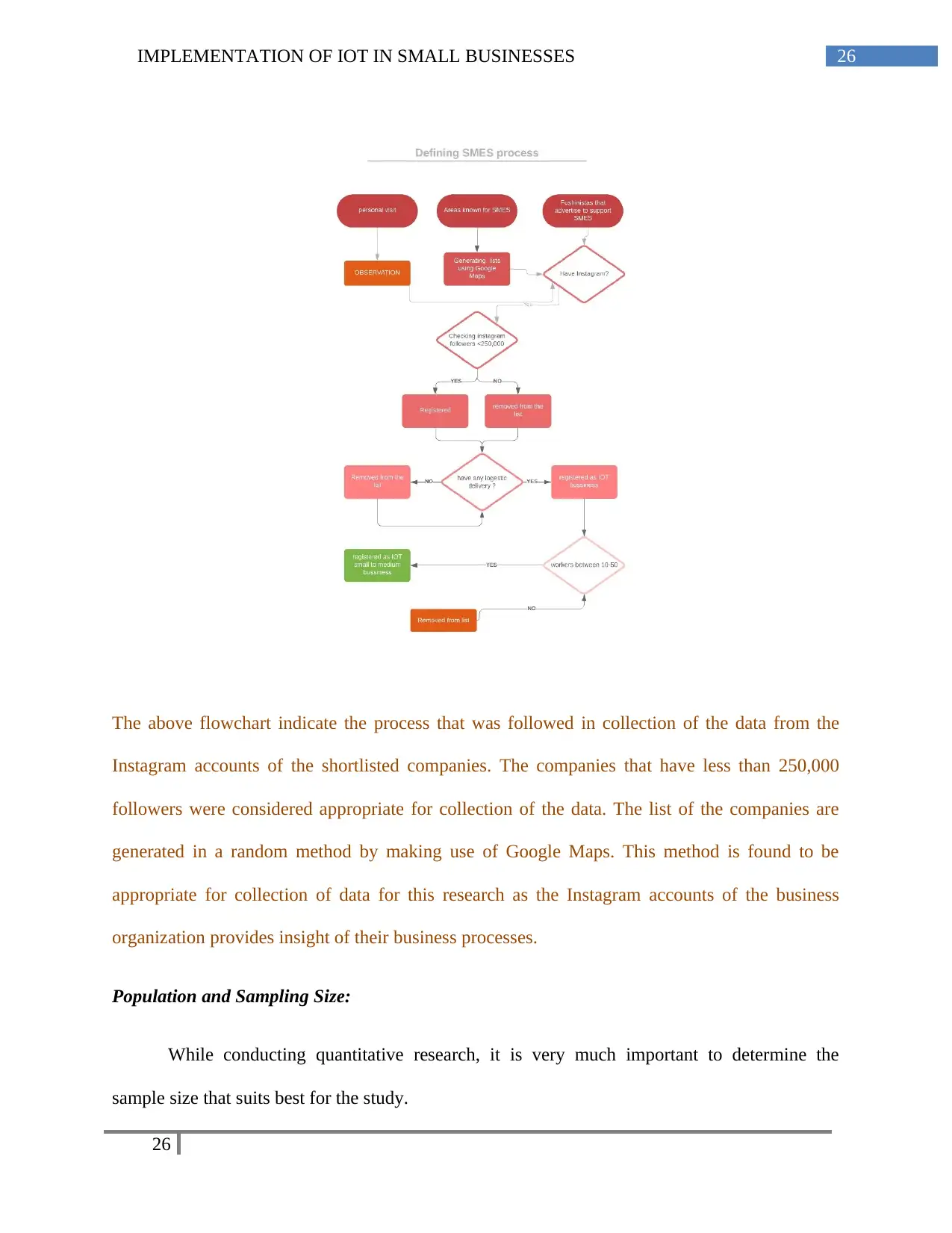
26IMPLEMENTATION OF IOT IN SMALL BUSINESSES
The above flowchart indicate the process that was followed in collection of the data from the
Instagram accounts of the shortlisted companies. The companies that have less than 250,000
followers were considered appropriate for collection of the data. The list of the companies are
generated in a random method by making use of Google Maps. This method is found to be
appropriate for collection of data for this research as the Instagram accounts of the business
organization provides insight of their business processes.
Population and Sampling Size:
While conducting quantitative research, it is very much important to determine the
sample size that suits best for the study.
26
The above flowchart indicate the process that was followed in collection of the data from the
Instagram accounts of the shortlisted companies. The companies that have less than 250,000
followers were considered appropriate for collection of the data. The list of the companies are
generated in a random method by making use of Google Maps. This method is found to be
appropriate for collection of data for this research as the Instagram accounts of the business
organization provides insight of their business processes.
Population and Sampling Size:
While conducting quantitative research, it is very much important to determine the
sample size that suits best for the study.
26
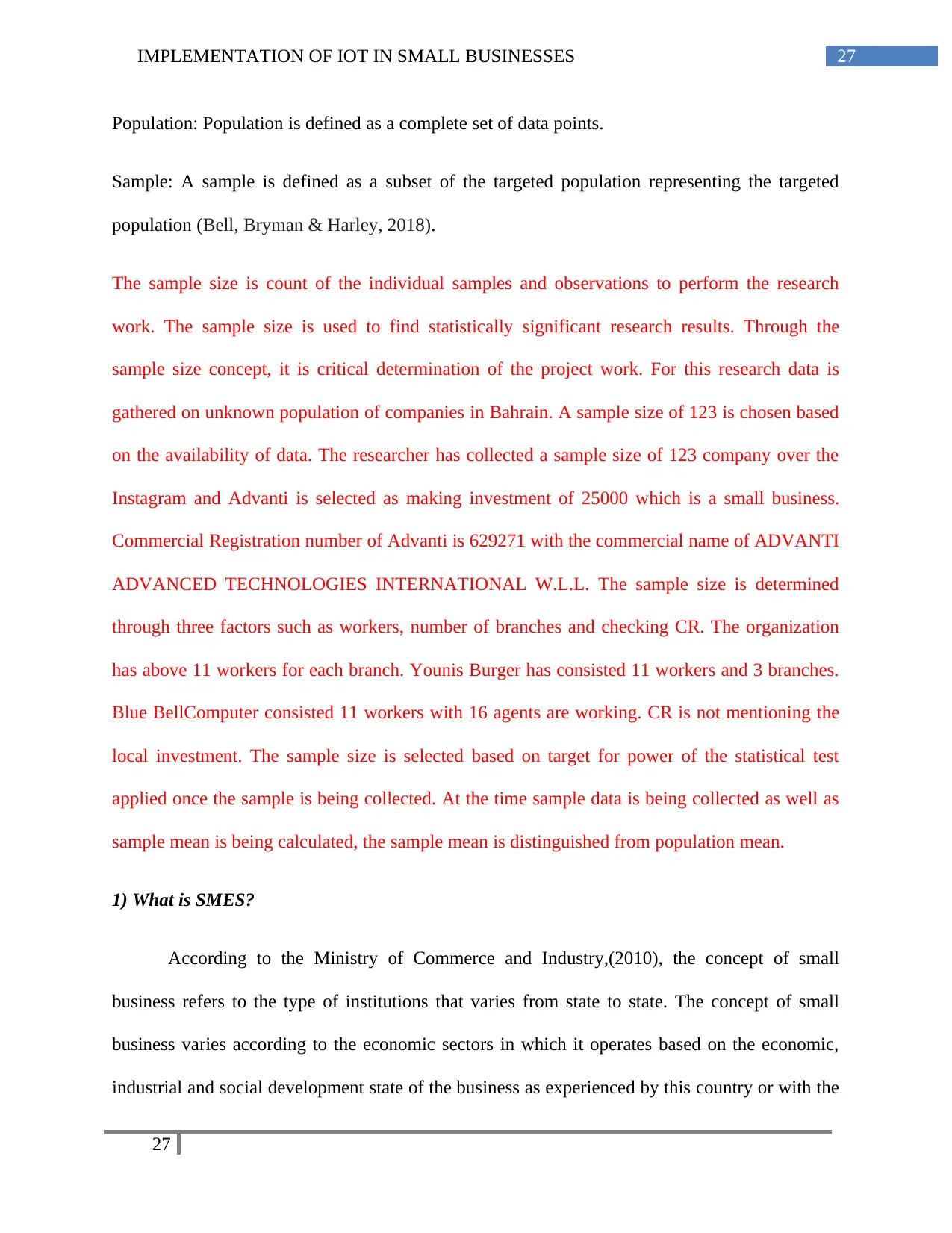
27IMPLEMENTATION OF IOT IN SMALL BUSINESSES
Population: Population is defined as a complete set of data points.
Sample: A sample is defined as a subset of the targeted population representing the targeted
population (Bell, Bryman & Harley, 2018).
The sample size is count of the individual samples and observations to perform the research
work. The sample size is used to find statistically significant research results. Through the
sample size concept, it is critical determination of the project work. For this research data is
gathered on unknown population of companies in Bahrain. A sample size of 123 is chosen based
on the availability of data. The researcher has collected a sample size of 123 company over the
Instagram and Advanti is selected as making investment of 25000 which is a small business.
Commercial Registration number of Advanti is 629271 with the commercial name of ADVANTI
ADVANCED TECHNOLOGIES INTERNATIONAL W.L.L. The sample size is determined
through three factors such as workers, number of branches and checking CR. The organization
has above 11 workers for each branch. Younis Burger has consisted 11 workers and 3 branches.
Blue BellComputer consisted 11 workers with 16 agents are working. CR is not mentioning the
local investment. The sample size is selected based on target for power of the statistical test
applied once the sample is being collected. At the time sample data is being collected as well as
sample mean is being calculated, the sample mean is distinguished from population mean.
1) What is SMES?
According to the Ministry of Commerce and Industry,(2010), the concept of small
business refers to the type of institutions that varies from state to state. The concept of small
business varies according to the economic sectors in which it operates based on the economic,
industrial and social development state of the business as experienced by this country or with the
27
Population: Population is defined as a complete set of data points.
Sample: A sample is defined as a subset of the targeted population representing the targeted
population (Bell, Bryman & Harley, 2018).
The sample size is count of the individual samples and observations to perform the research
work. The sample size is used to find statistically significant research results. Through the
sample size concept, it is critical determination of the project work. For this research data is
gathered on unknown population of companies in Bahrain. A sample size of 123 is chosen based
on the availability of data. The researcher has collected a sample size of 123 company over the
Instagram and Advanti is selected as making investment of 25000 which is a small business.
Commercial Registration number of Advanti is 629271 with the commercial name of ADVANTI
ADVANCED TECHNOLOGIES INTERNATIONAL W.L.L. The sample size is determined
through three factors such as workers, number of branches and checking CR. The organization
has above 11 workers for each branch. Younis Burger has consisted 11 workers and 3 branches.
Blue BellComputer consisted 11 workers with 16 agents are working. CR is not mentioning the
local investment. The sample size is selected based on target for power of the statistical test
applied once the sample is being collected. At the time sample data is being collected as well as
sample mean is being calculated, the sample mean is distinguished from population mean.
1) What is SMES?
According to the Ministry of Commerce and Industry,(2010), the concept of small
business refers to the type of institutions that varies from state to state. The concept of small
business varies according to the economic sectors in which it operates based on the economic,
industrial and social development state of the business as experienced by this country or with the
27
Secure Best Marks with AI Grader
Need help grading? Try our AI Grader for instant feedback on your assignments.
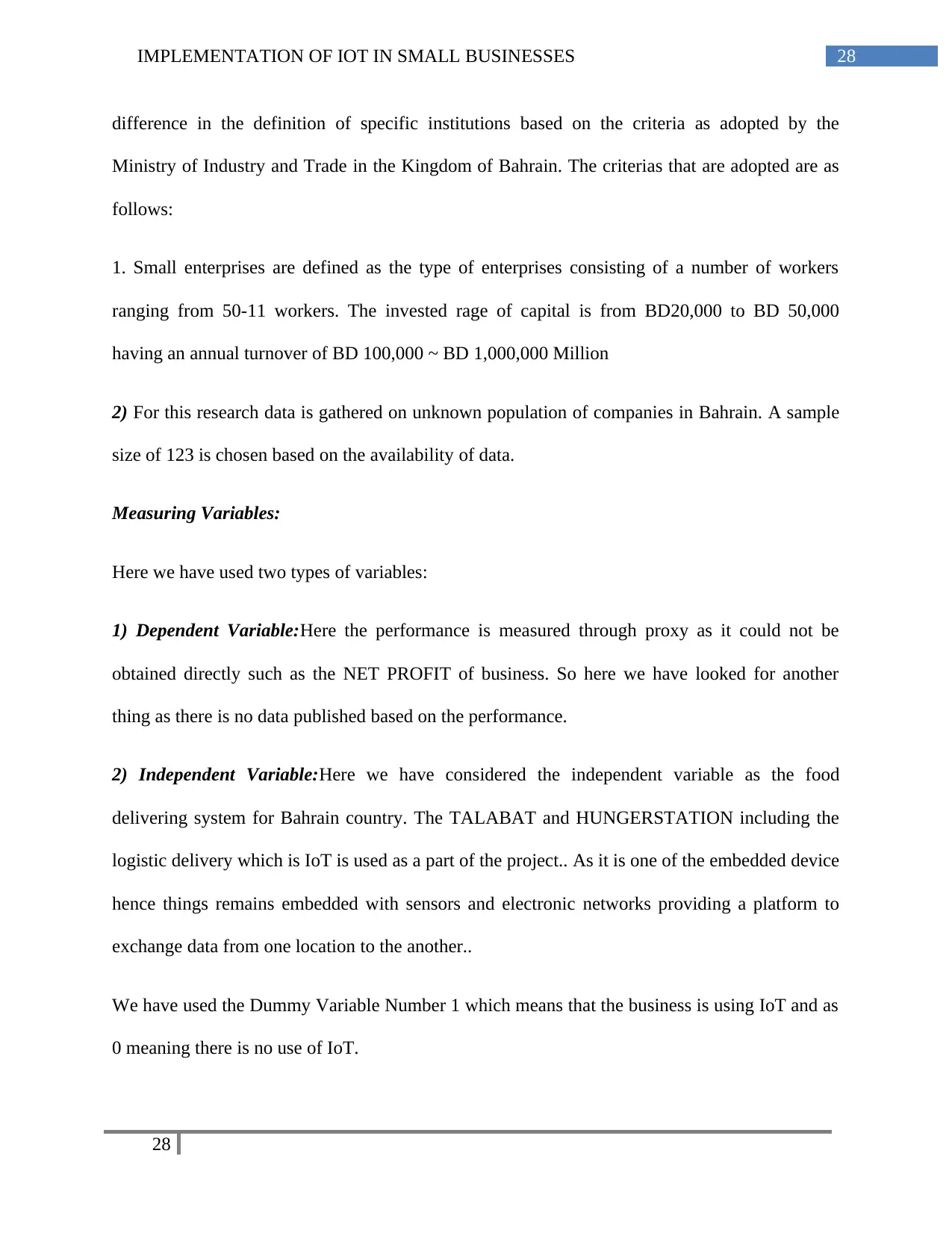
28IMPLEMENTATION OF IOT IN SMALL BUSINESSES
difference in the definition of specific institutions based on the criteria as adopted by the
Ministry of Industry and Trade in the Kingdom of Bahrain. The criterias that are adopted are as
follows:
1. Small enterprises are defined as the type of enterprises consisting of a number of workers
ranging from 50-11 workers. The invested rage of capital is from BD20,000 to BD 50,000
having an annual turnover of BD 100,000 ~ BD 1,000,000 Million
2) For this research data is gathered on unknown population of companies in Bahrain. A sample
size of 123 is chosen based on the availability of data.
Measuring Variables:
Here we have used two types of variables:
1) Dependent Variable:Here the performance is measured through proxy as it could not be
obtained directly such as the NET PROFIT of business. So here we have looked for another
thing as there is no data published based on the performance.
2) Independent Variable:Here we have considered the independent variable as the food
delivering system for Bahrain country. The TALABAT and HUNGERSTATION including the
logistic delivery which is IoT is used as a part of the project.. As it is one of the embedded device
hence things remains embedded with sensors and electronic networks providing a platform to
exchange data from one location to the another..
We have used the Dummy Variable Number 1 which means that the business is using IoT and as
0 meaning there is no use of IoT.
28
difference in the definition of specific institutions based on the criteria as adopted by the
Ministry of Industry and Trade in the Kingdom of Bahrain. The criterias that are adopted are as
follows:
1. Small enterprises are defined as the type of enterprises consisting of a number of workers
ranging from 50-11 workers. The invested rage of capital is from BD20,000 to BD 50,000
having an annual turnover of BD 100,000 ~ BD 1,000,000 Million
2) For this research data is gathered on unknown population of companies in Bahrain. A sample
size of 123 is chosen based on the availability of data.
Measuring Variables:
Here we have used two types of variables:
1) Dependent Variable:Here the performance is measured through proxy as it could not be
obtained directly such as the NET PROFIT of business. So here we have looked for another
thing as there is no data published based on the performance.
2) Independent Variable:Here we have considered the independent variable as the food
delivering system for Bahrain country. The TALABAT and HUNGERSTATION including the
logistic delivery which is IoT is used as a part of the project.. As it is one of the embedded device
hence things remains embedded with sensors and electronic networks providing a platform to
exchange data from one location to the another..
We have used the Dummy Variable Number 1 which means that the business is using IoT and as
0 meaning there is no use of IoT.
28
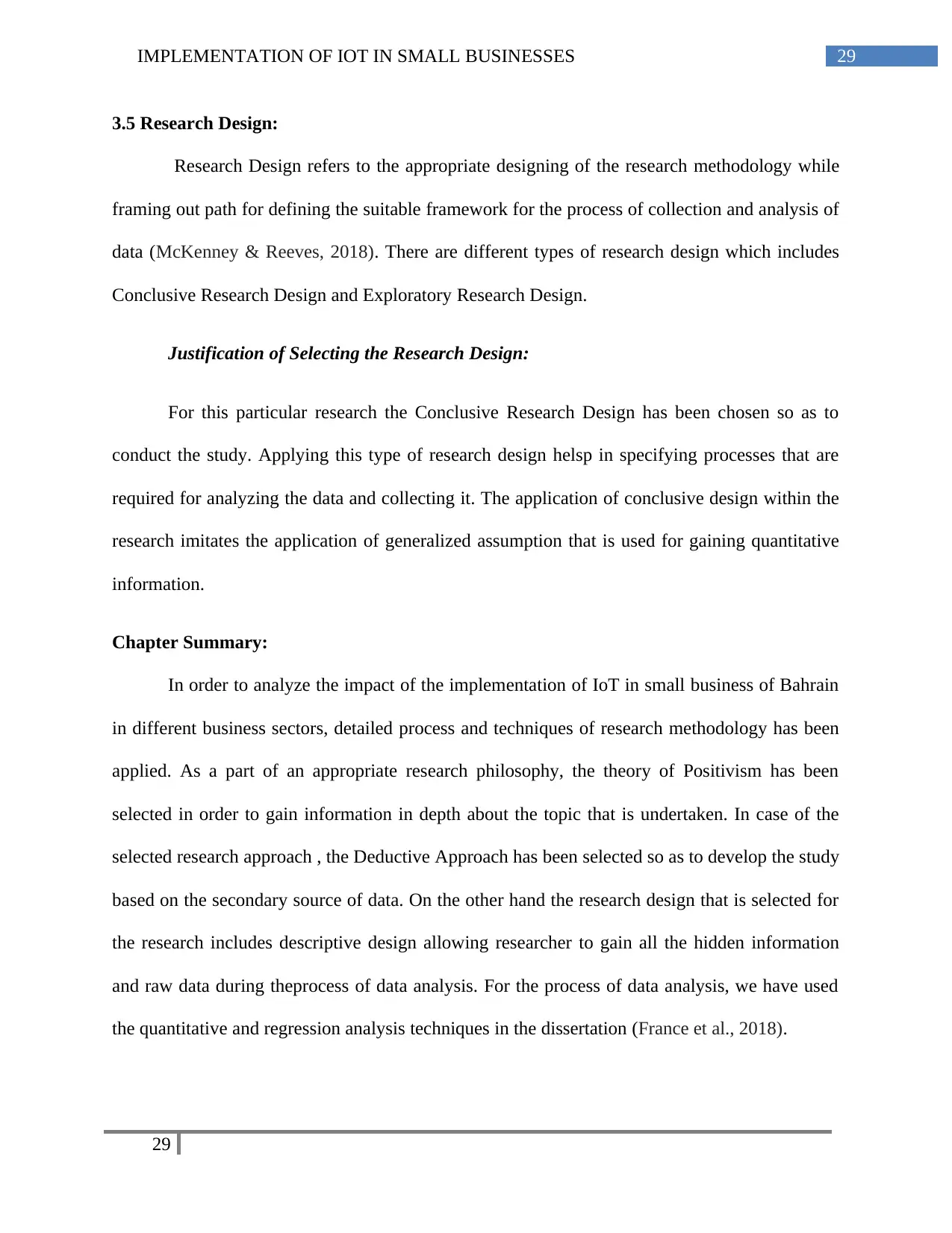
29IMPLEMENTATION OF IOT IN SMALL BUSINESSES
3.5 Research Design:
Research Design refers to the appropriate designing of the research methodology while
framing out path for defining the suitable framework for the process of collection and analysis of
data (McKenney & Reeves, 2018). There are different types of research design which includes
Conclusive Research Design and Exploratory Research Design.
Justification of Selecting the Research Design:
For this particular research the Conclusive Research Design has been chosen so as to
conduct the study. Applying this type of research design helsp in specifying processes that are
required for analyzing the data and collecting it. The application of conclusive design within the
research imitates the application of generalized assumption that is used for gaining quantitative
information.
Chapter Summary:
In order to analyze the impact of the implementation of IoT in small business of Bahrain
in different business sectors, detailed process and techniques of research methodology has been
applied. As a part of an appropriate research philosophy, the theory of Positivism has been
selected in order to gain information in depth about the topic that is undertaken. In case of the
selected research approach , the Deductive Approach has been selected so as to develop the study
based on the secondary source of data. On the other hand the research design that is selected for
the research includes descriptive design allowing researcher to gain all the hidden information
and raw data during theprocess of data analysis. For the process of data analysis, we have used
the quantitative and regression analysis techniques in the dissertation (France et al., 2018).
29
3.5 Research Design:
Research Design refers to the appropriate designing of the research methodology while
framing out path for defining the suitable framework for the process of collection and analysis of
data (McKenney & Reeves, 2018). There are different types of research design which includes
Conclusive Research Design and Exploratory Research Design.
Justification of Selecting the Research Design:
For this particular research the Conclusive Research Design has been chosen so as to
conduct the study. Applying this type of research design helsp in specifying processes that are
required for analyzing the data and collecting it. The application of conclusive design within the
research imitates the application of generalized assumption that is used for gaining quantitative
information.
Chapter Summary:
In order to analyze the impact of the implementation of IoT in small business of Bahrain
in different business sectors, detailed process and techniques of research methodology has been
applied. As a part of an appropriate research philosophy, the theory of Positivism has been
selected in order to gain information in depth about the topic that is undertaken. In case of the
selected research approach , the Deductive Approach has been selected so as to develop the study
based on the secondary source of data. On the other hand the research design that is selected for
the research includes descriptive design allowing researcher to gain all the hidden information
and raw data during theprocess of data analysis. For the process of data analysis, we have used
the quantitative and regression analysis techniques in the dissertation (France et al., 2018).
29
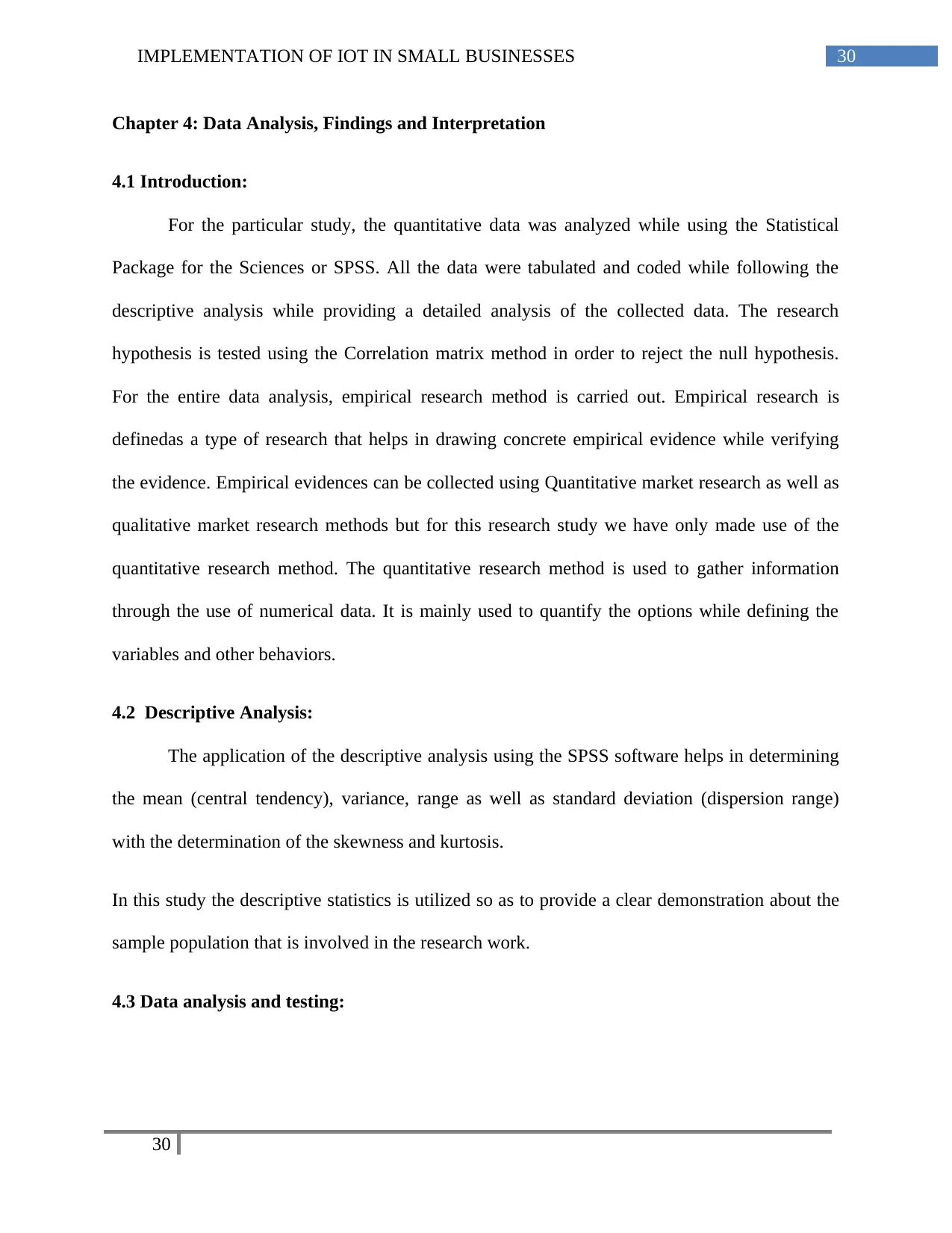
30IMPLEMENTATION OF IOT IN SMALL BUSINESSES
Chapter 4: Data Analysis, Findings and Interpretation
4.1 Introduction:
For the particular study, the quantitative data was analyzed while using the Statistical
Package for the Sciences or SPSS. All the data were tabulated and coded while following the
descriptive analysis while providing a detailed analysis of the collected data. The research
hypothesis is tested using the Correlation matrix method in order to reject the null hypothesis.
For the entire data analysis, empirical research method is carried out. Empirical research is
definedas a type of research that helps in drawing concrete empirical evidence while verifying
the evidence. Empirical evidences can be collected using Quantitative market research as well as
qualitative market research methods but for this research study we have only made use of the
quantitative research method. The quantitative research method is used to gather information
through the use of numerical data. It is mainly used to quantify the options while defining the
variables and other behaviors.
4.2 Descriptive Analysis:
The application of the descriptive analysis using the SPSS software helps in determining
the mean (central tendency), variance, range as well as standard deviation (dispersion range)
with the determination of the skewness and kurtosis.
In this study the descriptive statistics is utilized so as to provide a clear demonstration about the
sample population that is involved in the research work.
4.3 Data analysis and testing:
30
Chapter 4: Data Analysis, Findings and Interpretation
4.1 Introduction:
For the particular study, the quantitative data was analyzed while using the Statistical
Package for the Sciences or SPSS. All the data were tabulated and coded while following the
descriptive analysis while providing a detailed analysis of the collected data. The research
hypothesis is tested using the Correlation matrix method in order to reject the null hypothesis.
For the entire data analysis, empirical research method is carried out. Empirical research is
definedas a type of research that helps in drawing concrete empirical evidence while verifying
the evidence. Empirical evidences can be collected using Quantitative market research as well as
qualitative market research methods but for this research study we have only made use of the
quantitative research method. The quantitative research method is used to gather information
through the use of numerical data. It is mainly used to quantify the options while defining the
variables and other behaviors.
4.2 Descriptive Analysis:
The application of the descriptive analysis using the SPSS software helps in determining
the mean (central tendency), variance, range as well as standard deviation (dispersion range)
with the determination of the skewness and kurtosis.
In this study the descriptive statistics is utilized so as to provide a clear demonstration about the
sample population that is involved in the research work.
4.3 Data analysis and testing:
30
Paraphrase This Document
Need a fresh take? Get an instant paraphrase of this document with our AI Paraphraser
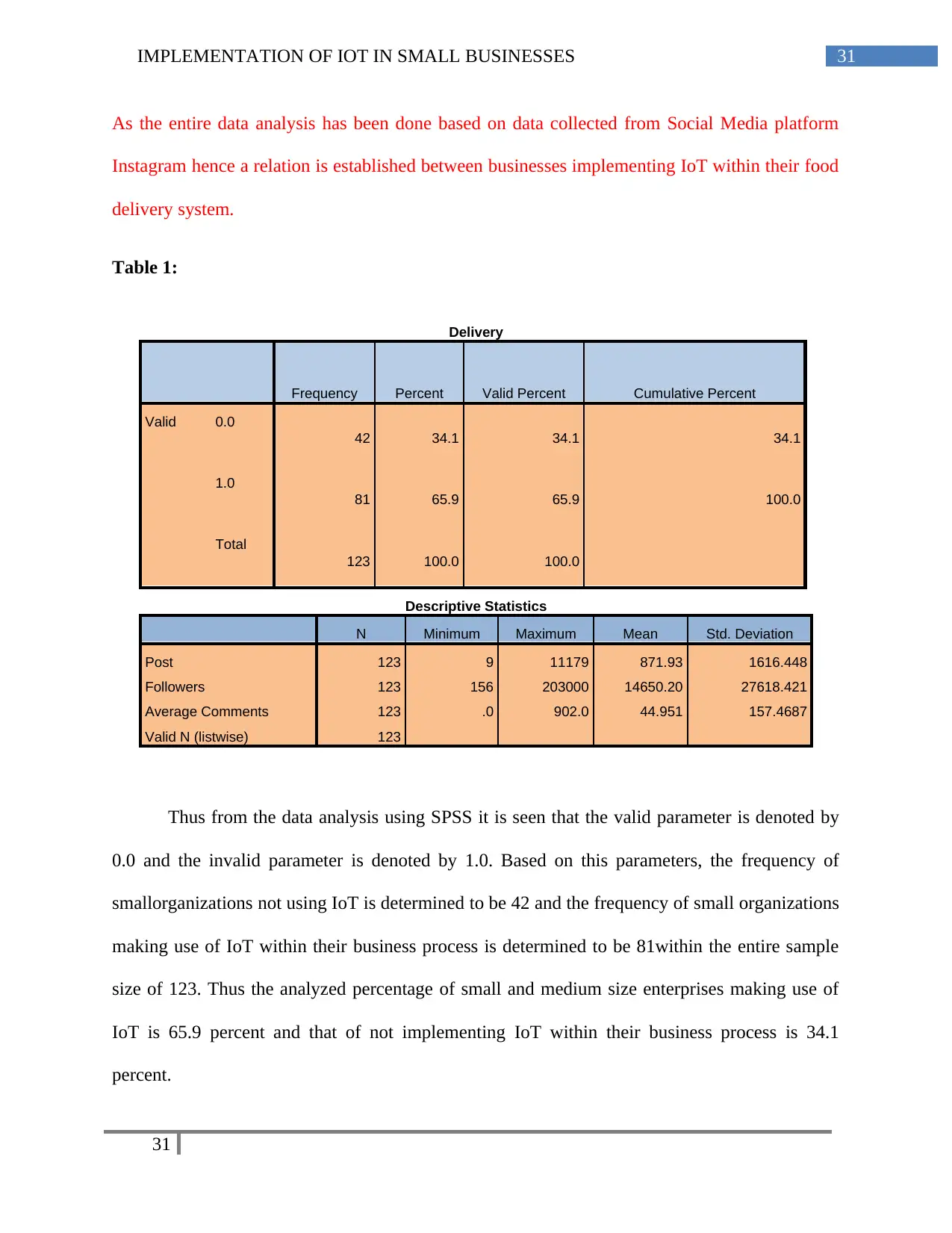
31IMPLEMENTATION OF IOT IN SMALL BUSINESSES
As the entire data analysis has been done based on data collected from Social Media platform
Instagram hence a relation is established between businesses implementing IoT within their food
delivery system.
Table 1:
Delivery
Frequency Percent Valid Percent Cumulative Percent
Valid 0.0
42 34.1 34.1 34.1
1.0
81 65.9 65.9 100.0
Total
123 100.0 100.0
Descriptive Statistics
N Minimum Maximum Mean Std. Deviation
Post 123 9 11179 871.93 1616.448
Followers 123 156 203000 14650.20 27618.421
Average Comments 123 .0 902.0 44.951 157.4687
Valid N (listwise) 123
Thus from the data analysis using SPSS it is seen that the valid parameter is denoted by
0.0 and the invalid parameter is denoted by 1.0. Based on this parameters, the frequency of
smallorganizations not using IoT is determined to be 42 and the frequency of small organizations
making use of IoT within their business process is determined to be 81within the entire sample
size of 123. Thus the analyzed percentage of small and medium size enterprises making use of
IoT is 65.9 percent and that of not implementing IoT within their business process is 34.1
percent.
31
As the entire data analysis has been done based on data collected from Social Media platform
Instagram hence a relation is established between businesses implementing IoT within their food
delivery system.
Table 1:
Delivery
Frequency Percent Valid Percent Cumulative Percent
Valid 0.0
42 34.1 34.1 34.1
1.0
81 65.9 65.9 100.0
Total
123 100.0 100.0
Descriptive Statistics
N Minimum Maximum Mean Std. Deviation
Post 123 9 11179 871.93 1616.448
Followers 123 156 203000 14650.20 27618.421
Average Comments 123 .0 902.0 44.951 157.4687
Valid N (listwise) 123
Thus from the data analysis using SPSS it is seen that the valid parameter is denoted by
0.0 and the invalid parameter is denoted by 1.0. Based on this parameters, the frequency of
smallorganizations not using IoT is determined to be 42 and the frequency of small organizations
making use of IoT within their business process is determined to be 81within the entire sample
size of 123. Thus the analyzed percentage of small and medium size enterprises making use of
IoT is 65.9 percent and that of not implementing IoT within their business process is 34.1
percent.
31
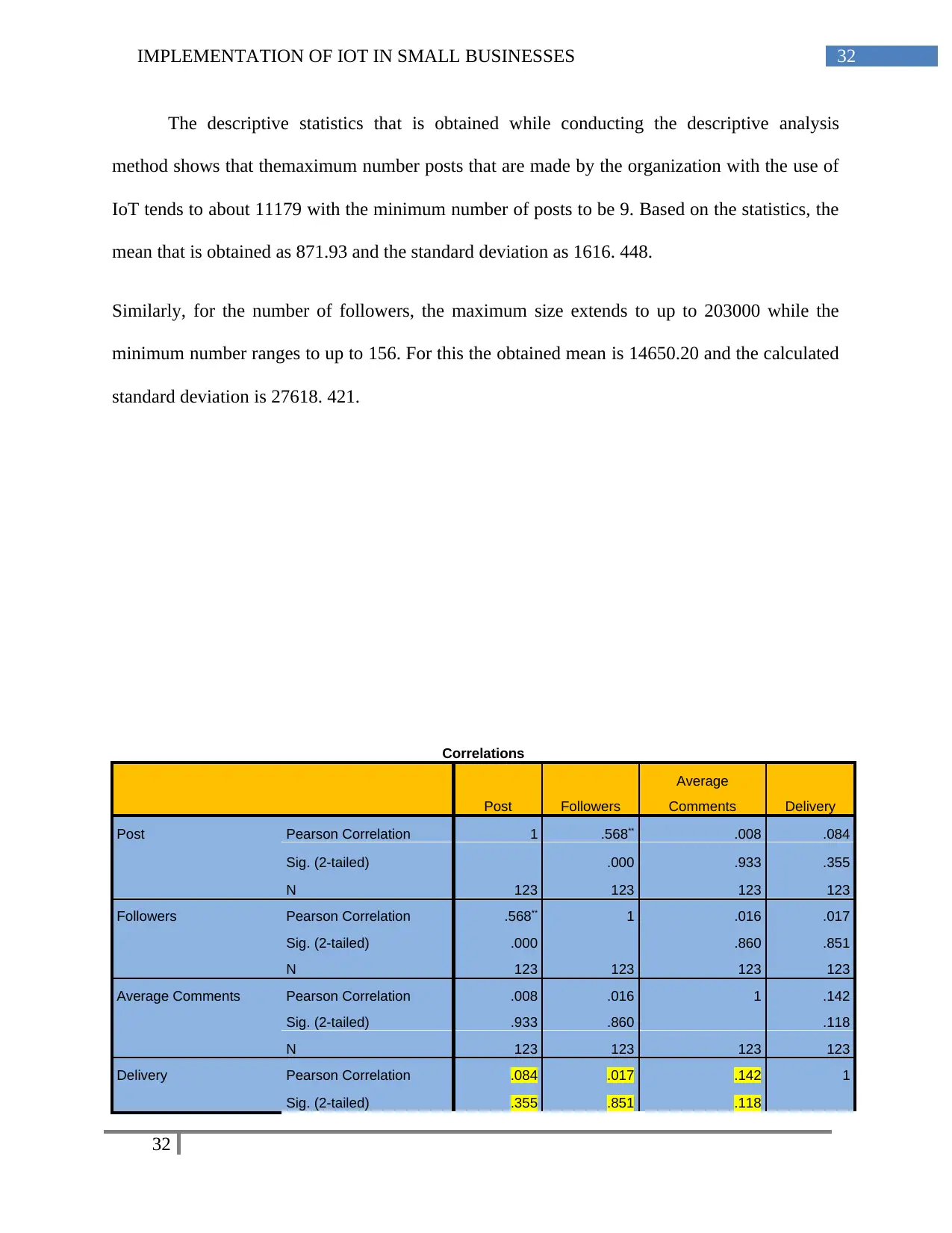
32IMPLEMENTATION OF IOT IN SMALL BUSINESSES
The descriptive statistics that is obtained while conducting the descriptive analysis
method shows that themaximum number posts that are made by the organization with the use of
IoT tends to about 11179 with the minimum number of posts to be 9. Based on the statistics, the
mean that is obtained as 871.93 and the standard deviation as 1616. 448.
Similarly, for the number of followers, the maximum size extends to up to 203000 while the
minimum number ranges to up to 156. For this the obtained mean is 14650.20 and the calculated
standard deviation is 27618. 421.
Correlations
Post Followers
Average
Comments Delivery
Post Pearson Correlation 1 .568** .008 .084
Sig. (2-tailed) .000 .933 .355
N 123 123 123 123
Followers Pearson Correlation .568** 1 .016 .017
Sig. (2-tailed) .000 .860 .851
N 123 123 123 123
Average Comments Pearson Correlation .008 .016 1 .142
Sig. (2-tailed) .933 .860 .118
N 123 123 123 123
Delivery Pearson Correlation .084 .017 .142 1
Sig. (2-tailed) .355 .851 .118
32
The descriptive statistics that is obtained while conducting the descriptive analysis
method shows that themaximum number posts that are made by the organization with the use of
IoT tends to about 11179 with the minimum number of posts to be 9. Based on the statistics, the
mean that is obtained as 871.93 and the standard deviation as 1616. 448.
Similarly, for the number of followers, the maximum size extends to up to 203000 while the
minimum number ranges to up to 156. For this the obtained mean is 14650.20 and the calculated
standard deviation is 27618. 421.
Correlations
Post Followers
Average
Comments Delivery
Post Pearson Correlation 1 .568** .008 .084
Sig. (2-tailed) .000 .933 .355
N 123 123 123 123
Followers Pearson Correlation .568** 1 .016 .017
Sig. (2-tailed) .000 .860 .851
N 123 123 123 123
Average Comments Pearson Correlation .008 .016 1 .142
Sig. (2-tailed) .933 .860 .118
N 123 123 123 123
Delivery Pearson Correlation .084 .017 .142 1
Sig. (2-tailed) .355 .851 .118
32
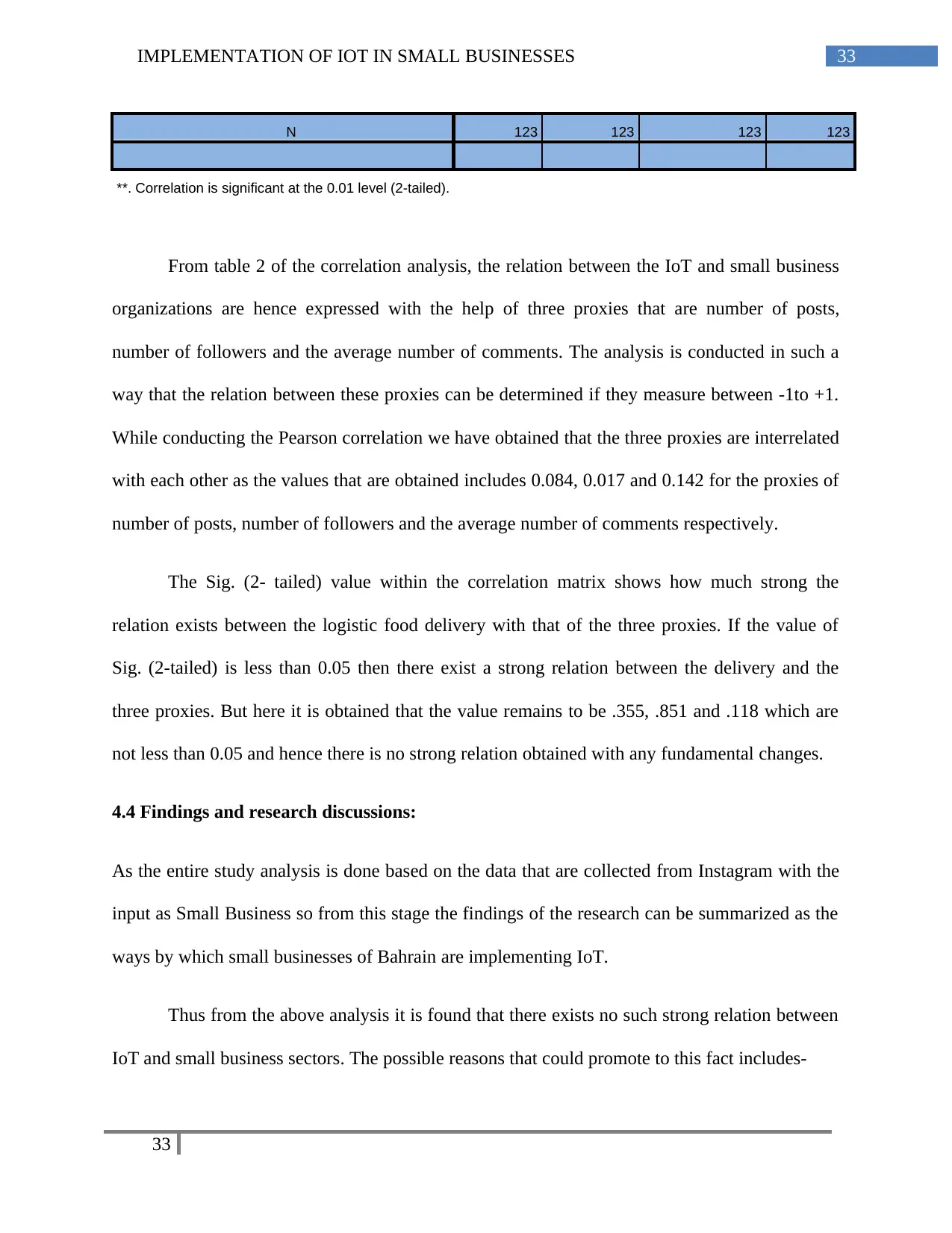
33IMPLEMENTATION OF IOT IN SMALL BUSINESSES
N 123 123 123 123
**. Correlation is significant at the 0.01 level (2-tailed).
From table 2 of the correlation analysis, the relation between the IoT and small business
organizations are hence expressed with the help of three proxies that are number of posts,
number of followers and the average number of comments. The analysis is conducted in such a
way that the relation between these proxies can be determined if they measure between -1to +1.
While conducting the Pearson correlation we have obtained that the three proxies are interrelated
with each other as the values that are obtained includes 0.084, 0.017 and 0.142 for the proxies of
number of posts, number of followers and the average number of comments respectively.
The Sig. (2- tailed) value within the correlation matrix shows how much strong the
relation exists between the logistic food delivery with that of the three proxies. If the value of
Sig. (2-tailed) is less than 0.05 then there exist a strong relation between the delivery and the
three proxies. But here it is obtained that the value remains to be .355, .851 and .118 which are
not less than 0.05 and hence there is no strong relation obtained with any fundamental changes.
4.4 Findings and research discussions:
As the entire study analysis is done based on the data that are collected from Instagram with the
input as Small Business so from this stage the findings of the research can be summarized as the
ways by which small businesses of Bahrain are implementing IoT.
Thus from the above analysis it is found that there exists no such strong relation between
IoT and small business sectors. The possible reasons that could promote to this fact includes-
33
N 123 123 123 123
**. Correlation is significant at the 0.01 level (2-tailed).
From table 2 of the correlation analysis, the relation between the IoT and small business
organizations are hence expressed with the help of three proxies that are number of posts,
number of followers and the average number of comments. The analysis is conducted in such a
way that the relation between these proxies can be determined if they measure between -1to +1.
While conducting the Pearson correlation we have obtained that the three proxies are interrelated
with each other as the values that are obtained includes 0.084, 0.017 and 0.142 for the proxies of
number of posts, number of followers and the average number of comments respectively.
The Sig. (2- tailed) value within the correlation matrix shows how much strong the
relation exists between the logistic food delivery with that of the three proxies. If the value of
Sig. (2-tailed) is less than 0.05 then there exist a strong relation between the delivery and the
three proxies. But here it is obtained that the value remains to be .355, .851 and .118 which are
not less than 0.05 and hence there is no strong relation obtained with any fundamental changes.
4.4 Findings and research discussions:
As the entire study analysis is done based on the data that are collected from Instagram with the
input as Small Business so from this stage the findings of the research can be summarized as the
ways by which small businesses of Bahrain are implementing IoT.
Thus from the above analysis it is found that there exists no such strong relation between
IoT and small business sectors. The possible reasons that could promote to this fact includes-
33
Secure Best Marks with AI Grader
Need help grading? Try our AI Grader for instant feedback on your assignments.
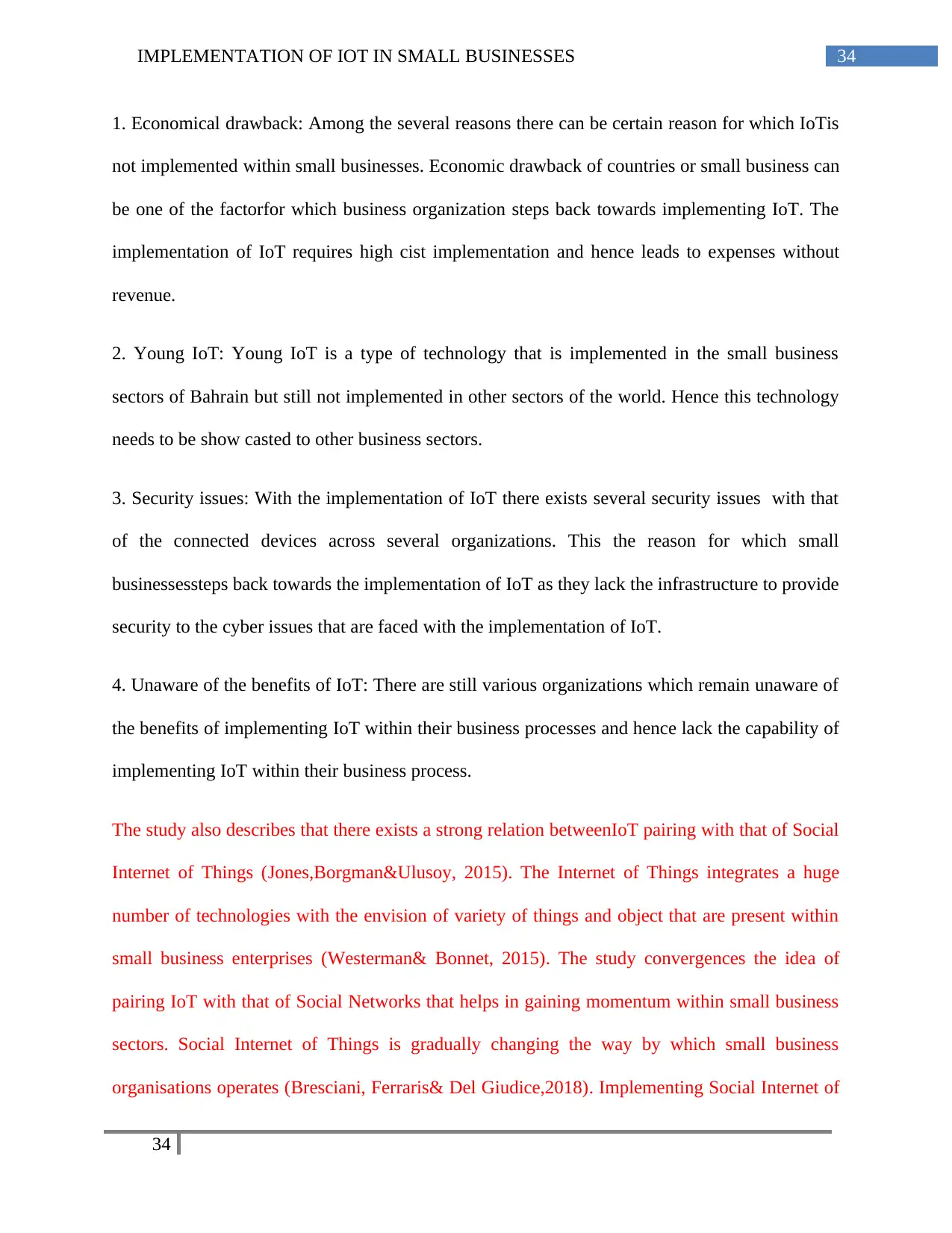
34IMPLEMENTATION OF IOT IN SMALL BUSINESSES
1. Economical drawback: Among the several reasons there can be certain reason for which IoTis
not implemented within small businesses. Economic drawback of countries or small business can
be one of the factorfor which business organization steps back towards implementing IoT. The
implementation of IoT requires high cist implementation and hence leads to expenses without
revenue.
2. Young IoT: Young IoT is a type of technology that is implemented in the small business
sectors of Bahrain but still not implemented in other sectors of the world. Hence this technology
needs to be show casted to other business sectors.
3. Security issues: With the implementation of IoT there exists several security issues with that
of the connected devices across several organizations. This the reason for which small
businessessteps back towards the implementation of IoT as they lack the infrastructure to provide
security to the cyber issues that are faced with the implementation of IoT.
4. Unaware of the benefits of IoT: There are still various organizations which remain unaware of
the benefits of implementing IoT within their business processes and hence lack the capability of
implementing IoT within their business process.
The study also describes that there exists a strong relation betweenIoT pairing with that of Social
Internet of Things (Jones,Borgman&Ulusoy, 2015). The Internet of Things integrates a huge
number of technologies with the envision of variety of things and object that are present within
small business enterprises (Westerman& Bonnet, 2015). The study convergences the idea of
pairing IoT with that of Social Networks that helps in gaining momentum within small business
sectors. Social Internet of Things is gradually changing the way by which small business
organisations operates (Bresciani, Ferraris& Del Giudice,2018). Implementing Social Internet of
34
1. Economical drawback: Among the several reasons there can be certain reason for which IoTis
not implemented within small businesses. Economic drawback of countries or small business can
be one of the factorfor which business organization steps back towards implementing IoT. The
implementation of IoT requires high cist implementation and hence leads to expenses without
revenue.
2. Young IoT: Young IoT is a type of technology that is implemented in the small business
sectors of Bahrain but still not implemented in other sectors of the world. Hence this technology
needs to be show casted to other business sectors.
3. Security issues: With the implementation of IoT there exists several security issues with that
of the connected devices across several organizations. This the reason for which small
businessessteps back towards the implementation of IoT as they lack the infrastructure to provide
security to the cyber issues that are faced with the implementation of IoT.
4. Unaware of the benefits of IoT: There are still various organizations which remain unaware of
the benefits of implementing IoT within their business processes and hence lack the capability of
implementing IoT within their business process.
The study also describes that there exists a strong relation betweenIoT pairing with that of Social
Internet of Things (Jones,Borgman&Ulusoy, 2015). The Internet of Things integrates a huge
number of technologies with the envision of variety of things and object that are present within
small business enterprises (Westerman& Bonnet, 2015). The study convergences the idea of
pairing IoT with that of Social Networks that helps in gaining momentum within small business
sectors. Social Internet of Things is gradually changing the way by which small business
organisations operates (Bresciani, Ferraris& Del Giudice,2018). Implementing Social Internet of
34
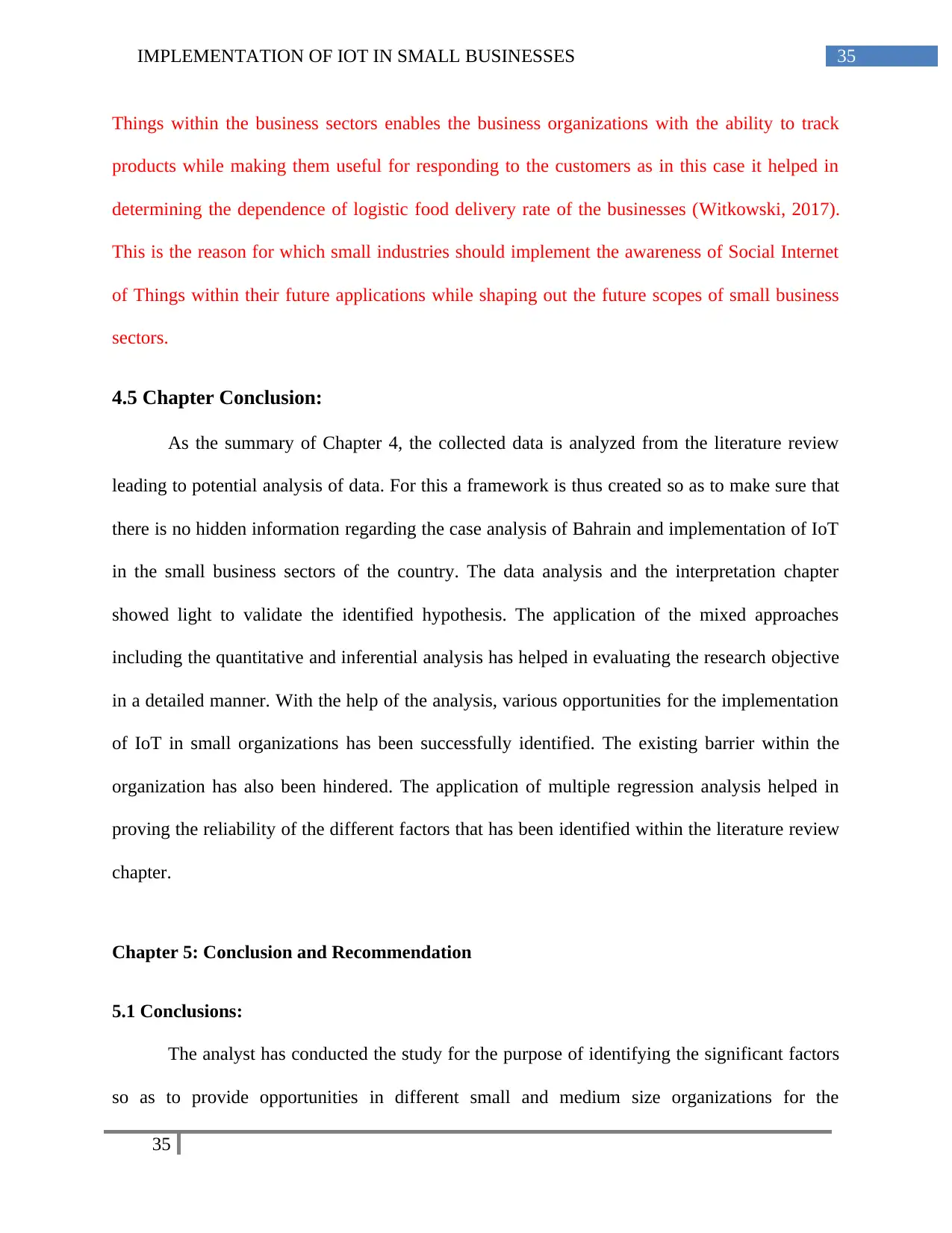
35IMPLEMENTATION OF IOT IN SMALL BUSINESSES
Things within the business sectors enables the business organizations with the ability to track
products while making them useful for responding to the customers as in this case it helped in
determining the dependence of logistic food delivery rate of the businesses (Witkowski, 2017).
This is the reason for which small industries should implement the awareness of Social Internet
of Things within their future applications while shaping out the future scopes of small business
sectors.
4.5 Chapter Conclusion:
As the summary of Chapter 4, the collected data is analyzed from the literature review
leading to potential analysis of data. For this a framework is thus created so as to make sure that
there is no hidden information regarding the case analysis of Bahrain and implementation of IoT
in the small business sectors of the country. The data analysis and the interpretation chapter
showed light to validate the identified hypothesis. The application of the mixed approaches
including the quantitative and inferential analysis has helped in evaluating the research objective
in a detailed manner. With the help of the analysis, various opportunities for the implementation
of IoT in small organizations has been successfully identified. The existing barrier within the
organization has also been hindered. The application of multiple regression analysis helped in
proving the reliability of the different factors that has been identified within the literature review
chapter.
Chapter 5: Conclusion and Recommendation
5.1 Conclusions:
The analyst has conducted the study for the purpose of identifying the significant factors
so as to provide opportunities in different small and medium size organizations for the
35
Things within the business sectors enables the business organizations with the ability to track
products while making them useful for responding to the customers as in this case it helped in
determining the dependence of logistic food delivery rate of the businesses (Witkowski, 2017).
This is the reason for which small industries should implement the awareness of Social Internet
of Things within their future applications while shaping out the future scopes of small business
sectors.
4.5 Chapter Conclusion:
As the summary of Chapter 4, the collected data is analyzed from the literature review
leading to potential analysis of data. For this a framework is thus created so as to make sure that
there is no hidden information regarding the case analysis of Bahrain and implementation of IoT
in the small business sectors of the country. The data analysis and the interpretation chapter
showed light to validate the identified hypothesis. The application of the mixed approaches
including the quantitative and inferential analysis has helped in evaluating the research objective
in a detailed manner. With the help of the analysis, various opportunities for the implementation
of IoT in small organizations has been successfully identified. The existing barrier within the
organization has also been hindered. The application of multiple regression analysis helped in
proving the reliability of the different factors that has been identified within the literature review
chapter.
Chapter 5: Conclusion and Recommendation
5.1 Conclusions:
The analyst has conducted the study for the purpose of identifying the significant factors
so as to provide opportunities in different small and medium size organizations for the
35
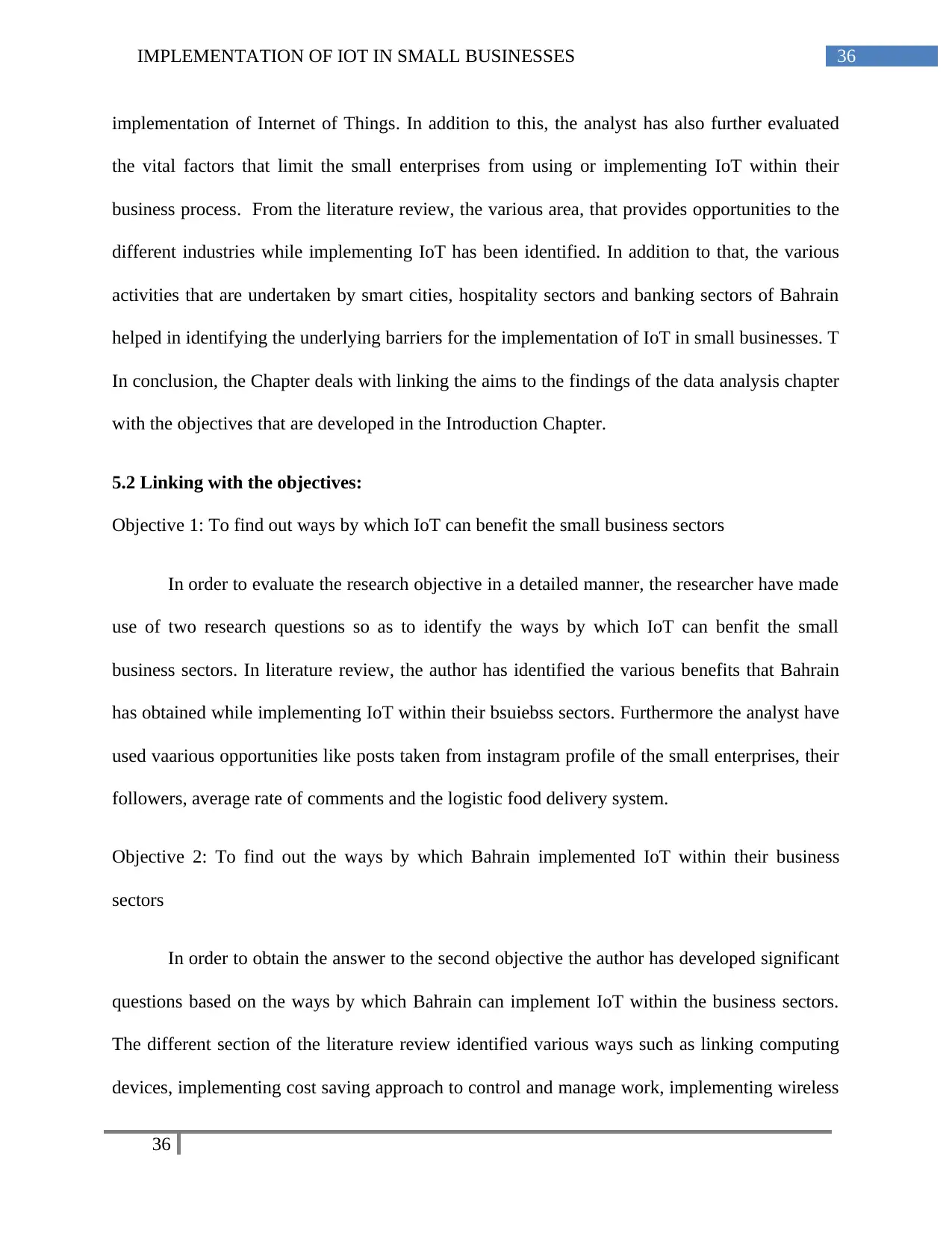
36IMPLEMENTATION OF IOT IN SMALL BUSINESSES
implementation of Internet of Things. In addition to this, the analyst has also further evaluated
the vital factors that limit the small enterprises from using or implementing IoT within their
business process. From the literature review, the various area, that provides opportunities to the
different industries while implementing IoT has been identified. In addition to that, the various
activities that are undertaken by smart cities, hospitality sectors and banking sectors of Bahrain
helped in identifying the underlying barriers for the implementation of IoT in small businesses. T
In conclusion, the Chapter deals with linking the aims to the findings of the data analysis chapter
with the objectives that are developed in the Introduction Chapter.
5.2 Linking with the objectives:
Objective 1: To find out ways by which IoT can benefit the small business sectors
In order to evaluate the research objective in a detailed manner, the researcher have made
use of two research questions so as to identify the ways by which IoT can benfit the small
business sectors. In literature review, the author has identified the various benefits that Bahrain
has obtained while implementing IoT within their bsuiebss sectors. Furthermore the analyst have
used vaarious opportunities like posts taken from instagram profile of the small enterprises, their
followers, average rate of comments and the logistic food delivery system.
Objective 2: To find out the ways by which Bahrain implemented IoT within their business
sectors
In order to obtain the answer to the second objective the author has developed significant
questions based on the ways by which Bahrain can implement IoT within the business sectors.
The different section of the literature review identified various ways such as linking computing
devices, implementing cost saving approach to control and manage work, implementing wireless
36
implementation of Internet of Things. In addition to this, the analyst has also further evaluated
the vital factors that limit the small enterprises from using or implementing IoT within their
business process. From the literature review, the various area, that provides opportunities to the
different industries while implementing IoT has been identified. In addition to that, the various
activities that are undertaken by smart cities, hospitality sectors and banking sectors of Bahrain
helped in identifying the underlying barriers for the implementation of IoT in small businesses. T
In conclusion, the Chapter deals with linking the aims to the findings of the data analysis chapter
with the objectives that are developed in the Introduction Chapter.
5.2 Linking with the objectives:
Objective 1: To find out ways by which IoT can benefit the small business sectors
In order to evaluate the research objective in a detailed manner, the researcher have made
use of two research questions so as to identify the ways by which IoT can benfit the small
business sectors. In literature review, the author has identified the various benefits that Bahrain
has obtained while implementing IoT within their bsuiebss sectors. Furthermore the analyst have
used vaarious opportunities like posts taken from instagram profile of the small enterprises, their
followers, average rate of comments and the logistic food delivery system.
Objective 2: To find out the ways by which Bahrain implemented IoT within their business
sectors
In order to obtain the answer to the second objective the author has developed significant
questions based on the ways by which Bahrain can implement IoT within the business sectors.
The different section of the literature review identified various ways such as linking computing
devices, implementing cost saving approach to control and manage work, implementing wireless
36
Paraphrase This Document
Need a fresh take? Get an instant paraphrase of this document with our AI Paraphraser
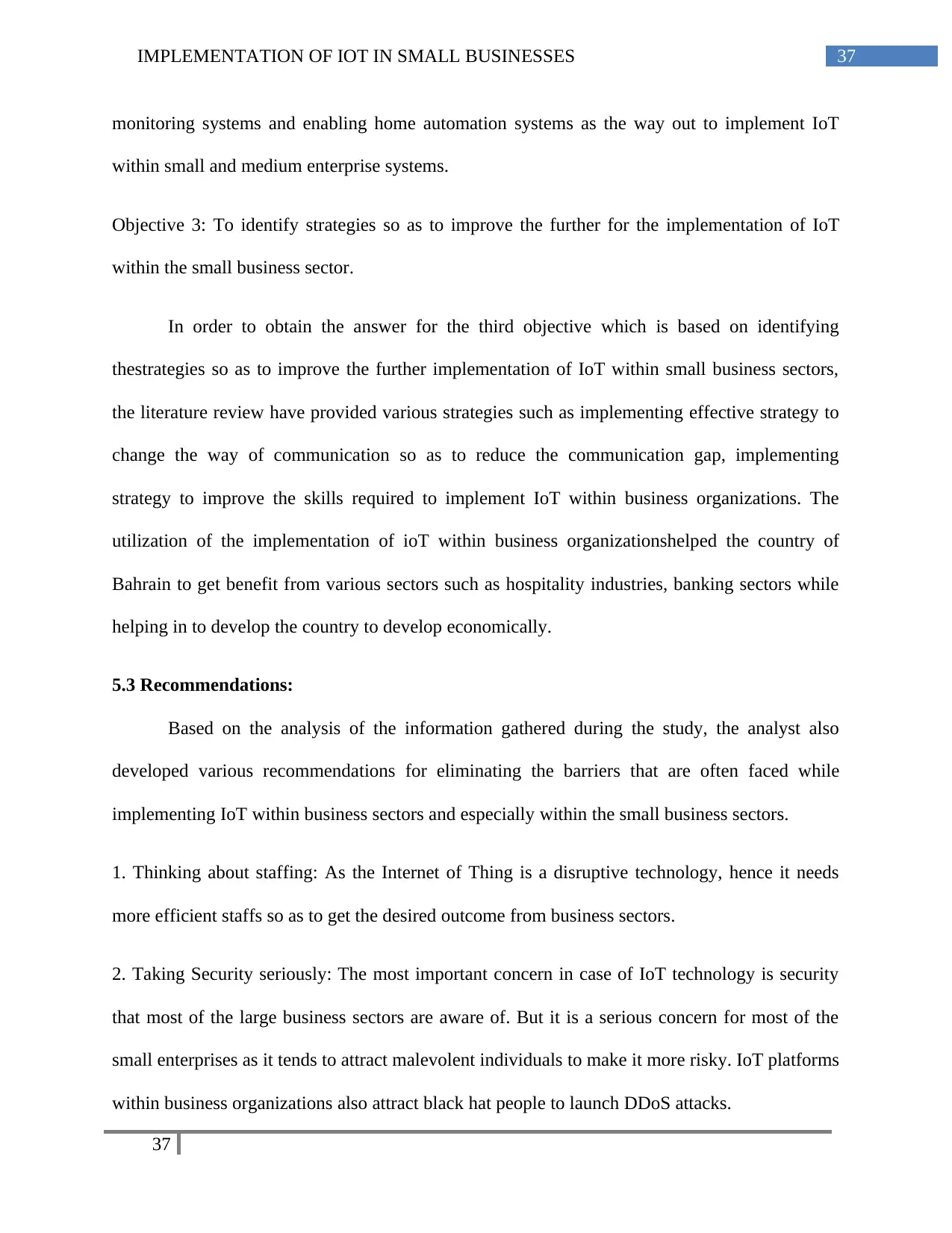
37IMPLEMENTATION OF IOT IN SMALL BUSINESSES
monitoring systems and enabling home automation systems as the way out to implement IoT
within small and medium enterprise systems.
Objective 3: To identify strategies so as to improve the further for the implementation of IoT
within the small business sector.
In order to obtain the answer for the third objective which is based on identifying
thestrategies so as to improve the further implementation of IoT within small business sectors,
the literature review have provided various strategies such as implementing effective strategy to
change the way of communication so as to reduce the communication gap, implementing
strategy to improve the skills required to implement IoT within business organizations. The
utilization of the implementation of ioT within business organizationshelped the country of
Bahrain to get benefit from various sectors such as hospitality industries, banking sectors while
helping in to develop the country to develop economically.
5.3 Recommendations:
Based on the analysis of the information gathered during the study, the analyst also
developed various recommendations for eliminating the barriers that are often faced while
implementing IoT within business sectors and especially within the small business sectors.
1. Thinking about staffing: As the Internet of Thing is a disruptive technology, hence it needs
more efficient staffs so as to get the desired outcome from business sectors.
2. Taking Security seriously: The most important concern in case of IoT technology is security
that most of the large business sectors are aware of. But it is a serious concern for most of the
small enterprises as it tends to attract malevolent individuals to make it more risky. IoT platforms
within business organizations also attract black hat people to launch DDoS attacks.
37
monitoring systems and enabling home automation systems as the way out to implement IoT
within small and medium enterprise systems.
Objective 3: To identify strategies so as to improve the further for the implementation of IoT
within the small business sector.
In order to obtain the answer for the third objective which is based on identifying
thestrategies so as to improve the further implementation of IoT within small business sectors,
the literature review have provided various strategies such as implementing effective strategy to
change the way of communication so as to reduce the communication gap, implementing
strategy to improve the skills required to implement IoT within business organizations. The
utilization of the implementation of ioT within business organizationshelped the country of
Bahrain to get benefit from various sectors such as hospitality industries, banking sectors while
helping in to develop the country to develop economically.
5.3 Recommendations:
Based on the analysis of the information gathered during the study, the analyst also
developed various recommendations for eliminating the barriers that are often faced while
implementing IoT within business sectors and especially within the small business sectors.
1. Thinking about staffing: As the Internet of Thing is a disruptive technology, hence it needs
more efficient staffs so as to get the desired outcome from business sectors.
2. Taking Security seriously: The most important concern in case of IoT technology is security
that most of the large business sectors are aware of. But it is a serious concern for most of the
small enterprises as it tends to attract malevolent individuals to make it more risky. IoT platforms
within business organizations also attract black hat people to launch DDoS attacks.
37
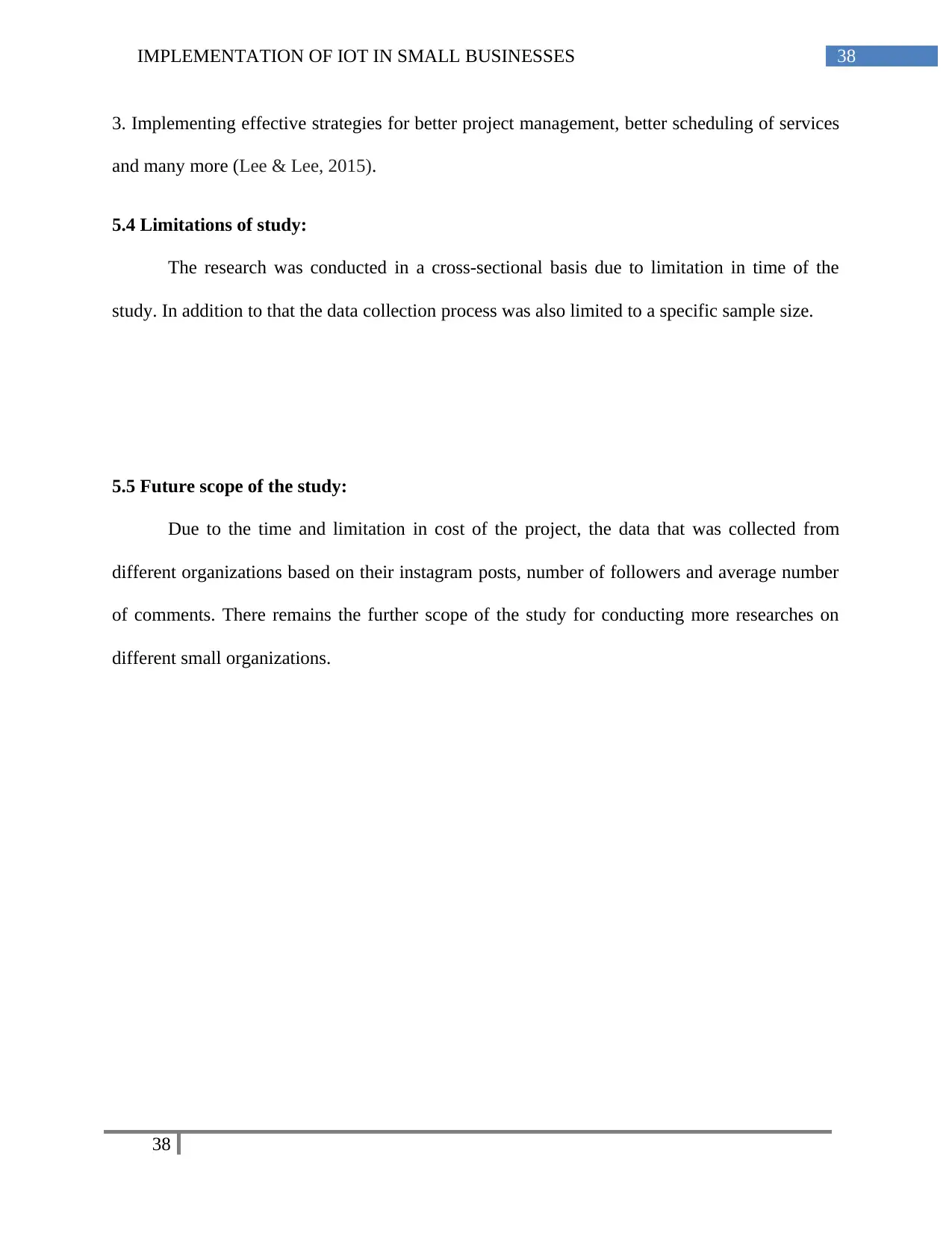
38IMPLEMENTATION OF IOT IN SMALL BUSINESSES
3. Implementing effective strategies for better project management, better scheduling of services
and many more (Lee & Lee, 2015).
5.4 Limitations of study:
The research was conducted in a cross-sectional basis due to limitation in time of the
study. In addition to that the data collection process was also limited to a specific sample size.
5.5 Future scope of the study:
Due to the time and limitation in cost of the project, the data that was collected from
different organizations based on their instagram posts, number of followers and average number
of comments. There remains the further scope of the study for conducting more researches on
different small organizations.
38
3. Implementing effective strategies for better project management, better scheduling of services
and many more (Lee & Lee, 2015).
5.4 Limitations of study:
The research was conducted in a cross-sectional basis due to limitation in time of the
study. In addition to that the data collection process was also limited to a specific sample size.
5.5 Future scope of the study:
Due to the time and limitation in cost of the project, the data that was collected from
different organizations based on their instagram posts, number of followers and average number
of comments. There remains the further scope of the study for conducting more researches on
different small organizations.
38
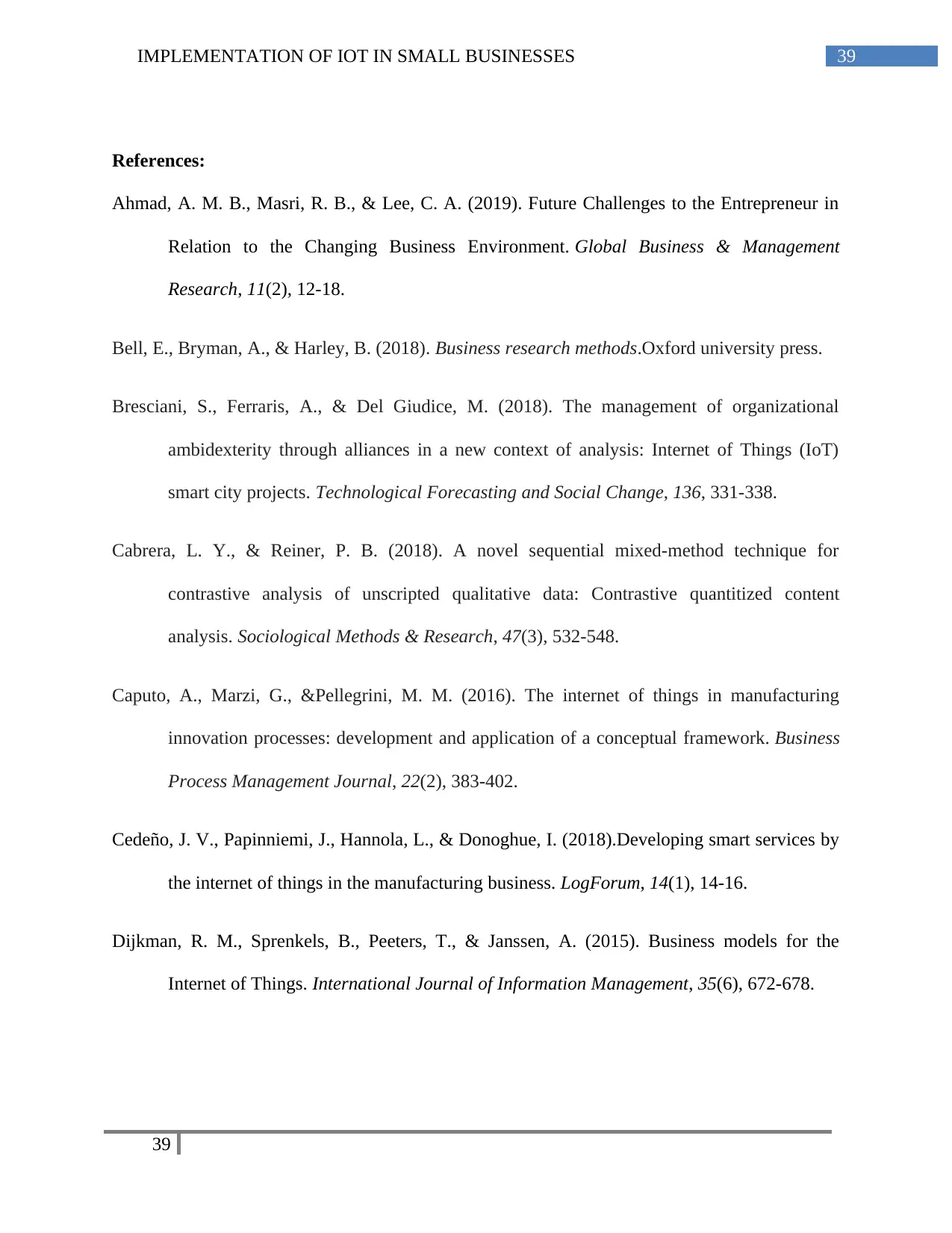
39IMPLEMENTATION OF IOT IN SMALL BUSINESSES
References:
Ahmad, A. M. B., Masri, R. B., & Lee, C. A. (2019). Future Challenges to the Entrepreneur in
Relation to the Changing Business Environment. Global Business & Management
Research, 11(2), 12-18.
Bell, E., Bryman, A., & Harley, B. (2018). Business research methods.Oxford university press.
Bresciani, S., Ferraris, A., & Del Giudice, M. (2018). The management of organizational
ambidexterity through alliances in a new context of analysis: Internet of Things (IoT)
smart city projects. Technological Forecasting and Social Change, 136, 331-338.
Cabrera, L. Y., & Reiner, P. B. (2018). A novel sequential mixed-method technique for
contrastive analysis of unscripted qualitative data: Contrastive quantitized content
analysis. Sociological Methods & Research, 47(3), 532-548.
Caputo, A., Marzi, G., &Pellegrini, M. M. (2016). The internet of things in manufacturing
innovation processes: development and application of a conceptual framework. Business
Process Management Journal, 22(2), 383-402.
Cedeño, J. V., Papinniemi, J., Hannola, L., & Donoghue, I. (2018).Developing smart services by
the internet of things in the manufacturing business. LogForum, 14(1), 14-16.
Dijkman, R. M., Sprenkels, B., Peeters, T., & Janssen, A. (2015). Business models for the
Internet of Things. International Journal of Information Management, 35(6), 672-678.
39
References:
Ahmad, A. M. B., Masri, R. B., & Lee, C. A. (2019). Future Challenges to the Entrepreneur in
Relation to the Changing Business Environment. Global Business & Management
Research, 11(2), 12-18.
Bell, E., Bryman, A., & Harley, B. (2018). Business research methods.Oxford university press.
Bresciani, S., Ferraris, A., & Del Giudice, M. (2018). The management of organizational
ambidexterity through alliances in a new context of analysis: Internet of Things (IoT)
smart city projects. Technological Forecasting and Social Change, 136, 331-338.
Cabrera, L. Y., & Reiner, P. B. (2018). A novel sequential mixed-method technique for
contrastive analysis of unscripted qualitative data: Contrastive quantitized content
analysis. Sociological Methods & Research, 47(3), 532-548.
Caputo, A., Marzi, G., &Pellegrini, M. M. (2016). The internet of things in manufacturing
innovation processes: development and application of a conceptual framework. Business
Process Management Journal, 22(2), 383-402.
Cedeño, J. V., Papinniemi, J., Hannola, L., & Donoghue, I. (2018).Developing smart services by
the internet of things in the manufacturing business. LogForum, 14(1), 14-16.
Dijkman, R. M., Sprenkels, B., Peeters, T., & Janssen, A. (2015). Business models for the
Internet of Things. International Journal of Information Management, 35(6), 672-678.
39
Secure Best Marks with AI Grader
Need help grading? Try our AI Grader for instant feedback on your assignments.
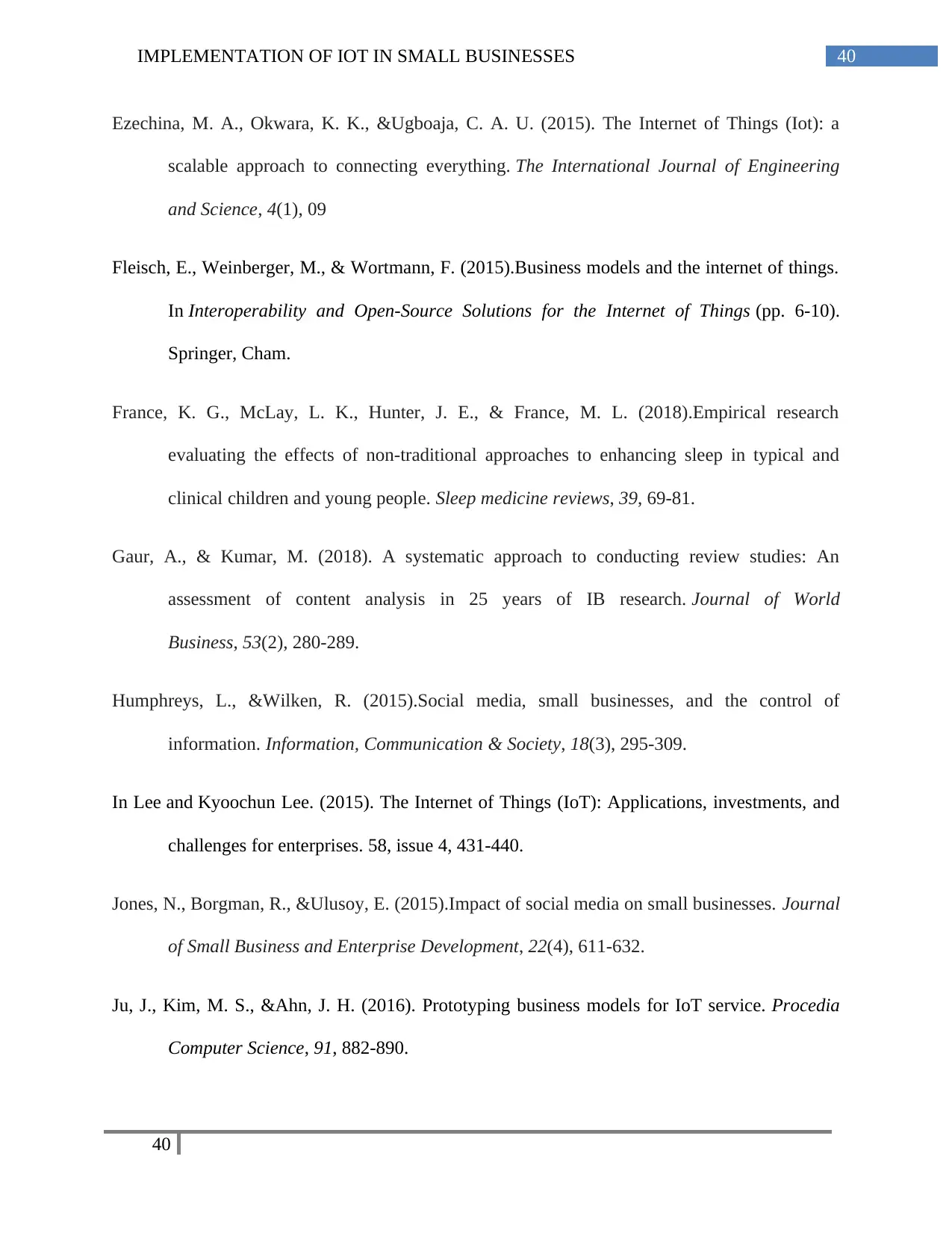
40IMPLEMENTATION OF IOT IN SMALL BUSINESSES
Ezechina, M. A., Okwara, K. K., &Ugboaja, C. A. U. (2015). The Internet of Things (Iot): a
scalable approach to connecting everything. The International Journal of Engineering
and Science, 4(1), 09
Fleisch, E., Weinberger, M., & Wortmann, F. (2015).Business models and the internet of things.
In Interoperability and Open-Source Solutions for the Internet of Things (pp. 6-10).
Springer, Cham.
France, K. G., McLay, L. K., Hunter, J. E., & France, M. L. (2018).Empirical research
evaluating the effects of non-traditional approaches to enhancing sleep in typical and
clinical children and young people. Sleep medicine reviews, 39, 69-81.
Gaur, A., & Kumar, M. (2018). A systematic approach to conducting review studies: An
assessment of content analysis in 25 years of IB research. Journal of World
Business, 53(2), 280-289.
Humphreys, L., &Wilken, R. (2015).Social media, small businesses, and the control of
information. Information, Communication & Society, 18(3), 295-309.
In Lee and Kyoochun Lee. (2015). The Internet of Things (IoT): Applications, investments, and
challenges for enterprises. 58, issue 4, 431-440.
Jones, N., Borgman, R., &Ulusoy, E. (2015).Impact of social media on small businesses. Journal
of Small Business and Enterprise Development, 22(4), 611-632.
Ju, J., Kim, M. S., &Ahn, J. H. (2016). Prototyping business models for IoT service. Procedia
Computer Science, 91, 882-890.
40
Ezechina, M. A., Okwara, K. K., &Ugboaja, C. A. U. (2015). The Internet of Things (Iot): a
scalable approach to connecting everything. The International Journal of Engineering
and Science, 4(1), 09
Fleisch, E., Weinberger, M., & Wortmann, F. (2015).Business models and the internet of things.
In Interoperability and Open-Source Solutions for the Internet of Things (pp. 6-10).
Springer, Cham.
France, K. G., McLay, L. K., Hunter, J. E., & France, M. L. (2018).Empirical research
evaluating the effects of non-traditional approaches to enhancing sleep in typical and
clinical children and young people. Sleep medicine reviews, 39, 69-81.
Gaur, A., & Kumar, M. (2018). A systematic approach to conducting review studies: An
assessment of content analysis in 25 years of IB research. Journal of World
Business, 53(2), 280-289.
Humphreys, L., &Wilken, R. (2015).Social media, small businesses, and the control of
information. Information, Communication & Society, 18(3), 295-309.
In Lee and Kyoochun Lee. (2015). The Internet of Things (IoT): Applications, investments, and
challenges for enterprises. 58, issue 4, 431-440.
Jones, N., Borgman, R., &Ulusoy, E. (2015).Impact of social media on small businesses. Journal
of Small Business and Enterprise Development, 22(4), 611-632.
Ju, J., Kim, M. S., &Ahn, J. H. (2016). Prototyping business models for IoT service. Procedia
Computer Science, 91, 882-890.
40
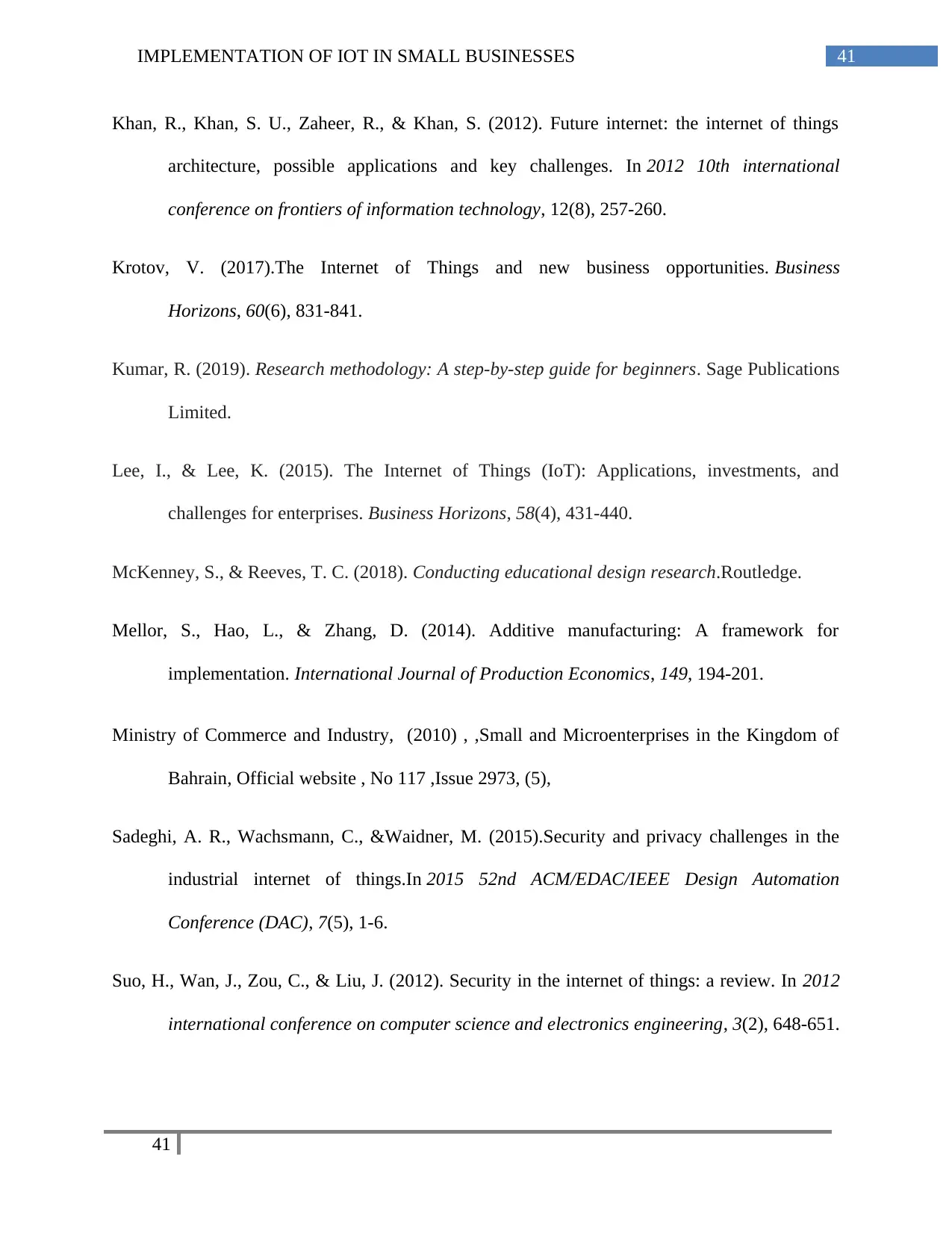
41IMPLEMENTATION OF IOT IN SMALL BUSINESSES
Khan, R., Khan, S. U., Zaheer, R., & Khan, S. (2012). Future internet: the internet of things
architecture, possible applications and key challenges. In 2012 10th international
conference on frontiers of information technology, 12(8), 257-260.
Krotov, V. (2017).The Internet of Things and new business opportunities. Business
Horizons, 60(6), 831-841.
Kumar, R. (2019). Research methodology: A step-by-step guide for beginners. Sage Publications
Limited.
Lee, I., & Lee, K. (2015). The Internet of Things (IoT): Applications, investments, and
challenges for enterprises. Business Horizons, 58(4), 431-440.
McKenney, S., & Reeves, T. C. (2018). Conducting educational design research.Routledge.
Mellor, S., Hao, L., & Zhang, D. (2014). Additive manufacturing: A framework for
implementation. International Journal of Production Economics, 149, 194-201.
Ministry of Commerce and Industry, (2010) , ,Small and Microenterprises in the Kingdom of
Bahrain, Official website , No 117 ,Issue 2973, (5),
Sadeghi, A. R., Wachsmann, C., &Waidner, M. (2015).Security and privacy challenges in the
industrial internet of things.In 2015 52nd ACM/EDAC/IEEE Design Automation
Conference (DAC), 7(5), 1-6.
Suo, H., Wan, J., Zou, C., & Liu, J. (2012). Security in the internet of things: a review. In 2012
international conference on computer science and electronics engineering, 3(2), 648-651.
41
Khan, R., Khan, S. U., Zaheer, R., & Khan, S. (2012). Future internet: the internet of things
architecture, possible applications and key challenges. In 2012 10th international
conference on frontiers of information technology, 12(8), 257-260.
Krotov, V. (2017).The Internet of Things and new business opportunities. Business
Horizons, 60(6), 831-841.
Kumar, R. (2019). Research methodology: A step-by-step guide for beginners. Sage Publications
Limited.
Lee, I., & Lee, K. (2015). The Internet of Things (IoT): Applications, investments, and
challenges for enterprises. Business Horizons, 58(4), 431-440.
McKenney, S., & Reeves, T. C. (2018). Conducting educational design research.Routledge.
Mellor, S., Hao, L., & Zhang, D. (2014). Additive manufacturing: A framework for
implementation. International Journal of Production Economics, 149, 194-201.
Ministry of Commerce and Industry, (2010) , ,Small and Microenterprises in the Kingdom of
Bahrain, Official website , No 117 ,Issue 2973, (5),
Sadeghi, A. R., Wachsmann, C., &Waidner, M. (2015).Security and privacy challenges in the
industrial internet of things.In 2015 52nd ACM/EDAC/IEEE Design Automation
Conference (DAC), 7(5), 1-6.
Suo, H., Wan, J., Zou, C., & Liu, J. (2012). Security in the internet of things: a review. In 2012
international conference on computer science and electronics engineering, 3(2), 648-651.
41
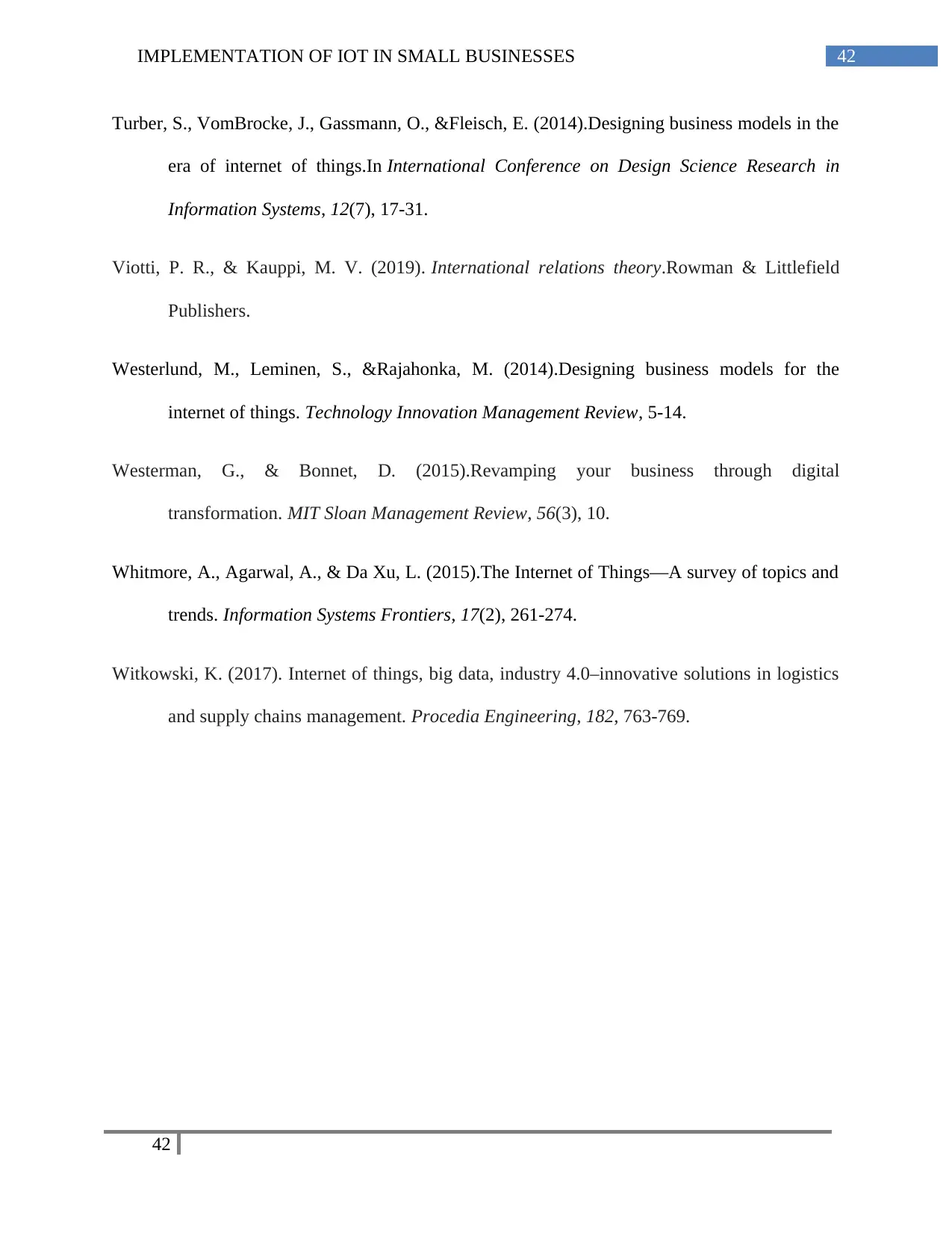
42IMPLEMENTATION OF IOT IN SMALL BUSINESSES
Turber, S., VomBrocke, J., Gassmann, O., &Fleisch, E. (2014).Designing business models in the
era of internet of things.In International Conference on Design Science Research in
Information Systems, 12(7), 17-31.
Viotti, P. R., & Kauppi, M. V. (2019). International relations theory.Rowman & Littlefield
Publishers.
Westerlund, M., Leminen, S., &Rajahonka, M. (2014).Designing business models for the
internet of things. Technology Innovation Management Review, 5-14.
Westerman, G., & Bonnet, D. (2015).Revamping your business through digital
transformation. MIT Sloan Management Review, 56(3), 10.
Whitmore, A., Agarwal, A., & Da Xu, L. (2015).The Internet of Things—A survey of topics and
trends. Information Systems Frontiers, 17(2), 261-274.
Witkowski, K. (2017). Internet of things, big data, industry 4.0–innovative solutions in logistics
and supply chains management. Procedia Engineering, 182, 763-769.
42
Turber, S., VomBrocke, J., Gassmann, O., &Fleisch, E. (2014).Designing business models in the
era of internet of things.In International Conference on Design Science Research in
Information Systems, 12(7), 17-31.
Viotti, P. R., & Kauppi, M. V. (2019). International relations theory.Rowman & Littlefield
Publishers.
Westerlund, M., Leminen, S., &Rajahonka, M. (2014).Designing business models for the
internet of things. Technology Innovation Management Review, 5-14.
Westerman, G., & Bonnet, D. (2015).Revamping your business through digital
transformation. MIT Sloan Management Review, 56(3), 10.
Whitmore, A., Agarwal, A., & Da Xu, L. (2015).The Internet of Things—A survey of topics and
trends. Information Systems Frontiers, 17(2), 261-274.
Witkowski, K. (2017). Internet of things, big data, industry 4.0–innovative solutions in logistics
and supply chains management. Procedia Engineering, 182, 763-769.
42
1 out of 43
Related Documents
Your All-in-One AI-Powered Toolkit for Academic Success.
+13062052269
info@desklib.com
Available 24*7 on WhatsApp / Email
![[object Object]](/_next/static/media/star-bottom.7253800d.svg)
Unlock your academic potential
© 2024 | Zucol Services PVT LTD | All rights reserved.





